Finding the Universe
Travel tales, photography and a dash of humor
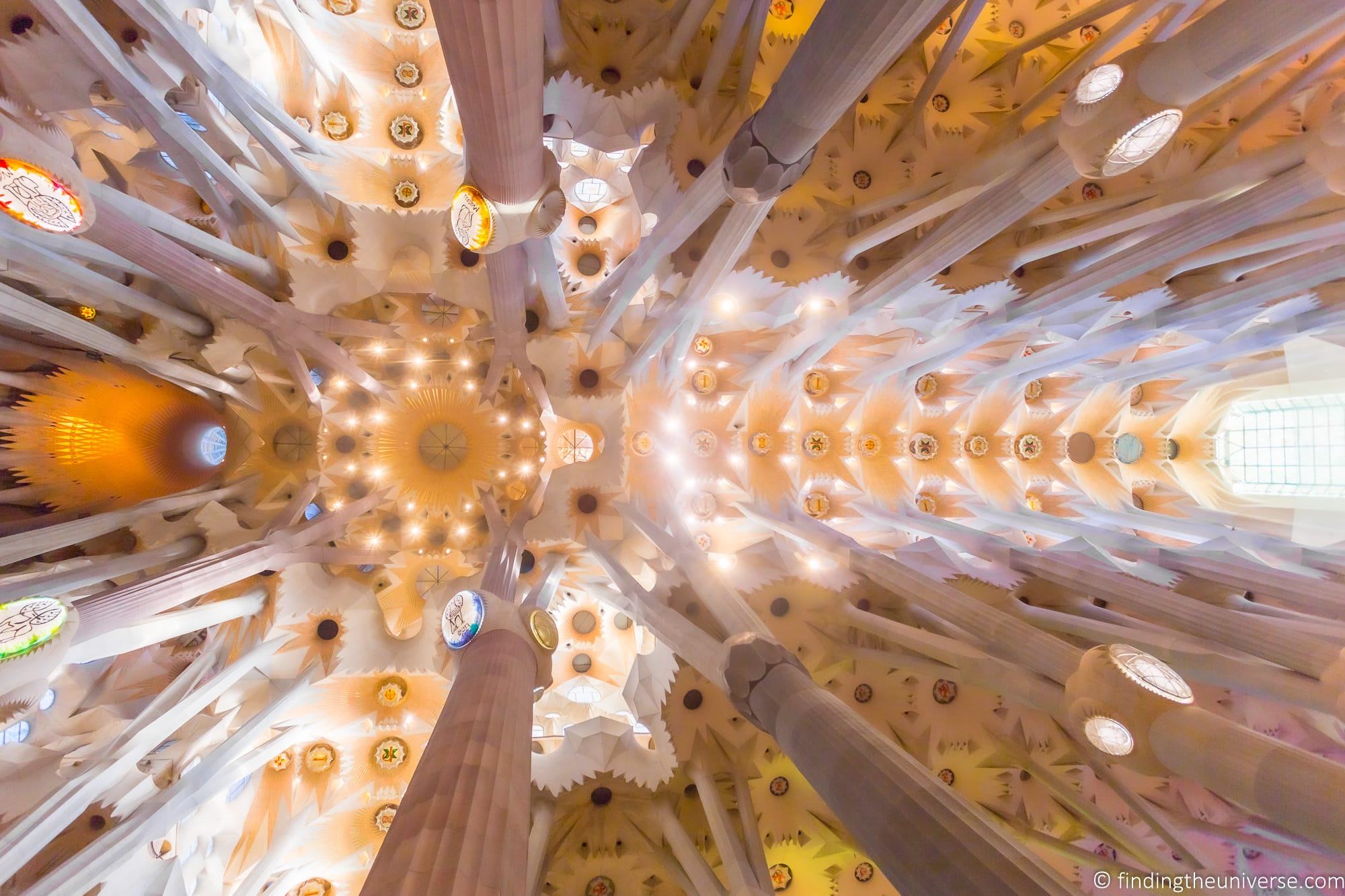

Guide to Visiting the Sagrada Familia 2024: Tickets, Tips and More!
Last updated: January 1, 2024 . Written by Laurence Norah - 9 Comments
If you’re visiting Barcelona, there’s a good chance you are planning on visiting the Basilica de la Sagrada Familia, commonly referred to as just the Sagrada Familia.
This magnificent building is a must-see in our opinion, and is high on the to-do list of most visitors to the city.
Because it’s so popular, you do need to do a bit of planning prior to your visit. At busier times of year, tickets can sell out. There’s also a lot to see and do here, as well as some choices you have to make before you buy your Sagrada Familia ticket.
We would also like to preface this guide with a note that currently the Sagrada Familia is an active construction site. This means different areas of the building may close, timings may change and access may vary. We will endeavour to keep this page as up to date as possible, but please do check the official website as well for relevant information.
In this guide, we’re going to tell you everything you need to know to help you plan your visit to the Sagrada Familia.
This will include a brief history of the Sagrada Familia, tips on getting to the Sagrada Familia, where to buy tickets for the Sagrada Familia, and lots more! Let’s get started by learning a bit about the Sagrada Familia itself.
What is the Sagrada Familia?
The Sagrada Familia is a huge Roman Catholic church in Barcelona. It’s classified as a minor basilica in the Roman Catholic church, and was consecrated as such by Pope Benedict XVI in 2010.
This unique building was the masterpiece of Antoni Gaudí, a Catalan architect responsible for a number of impressive buildings across Barcelona and the wider region. He was also a devout Catholic and was best known for his work in the Modernisme , or Catalan Modernism style.
Some of his other most popular works in Barcelona include La Pedrera, Casa Batlló, and Park Guell. You can see a full list of all his work in Barcelona in our guide to Gaudí sites in Barcelona
Construction of the Sagrada Familia started in 1882, and at the time of writing, is still ongoing. Gaudi died tragically in 1926, and work on the Basilica was interrupted by the Spanish Civil war in 1936. It resumed in 1940, and has been ongoing to this day.
Funding for the Sagrada Familia is entirely private, with no support from the government or Church. It was initially funded by private donors, but today much of the income is from visitor ticket sales. So when you visit, know that your money is going directly to helping finish this incredible building!
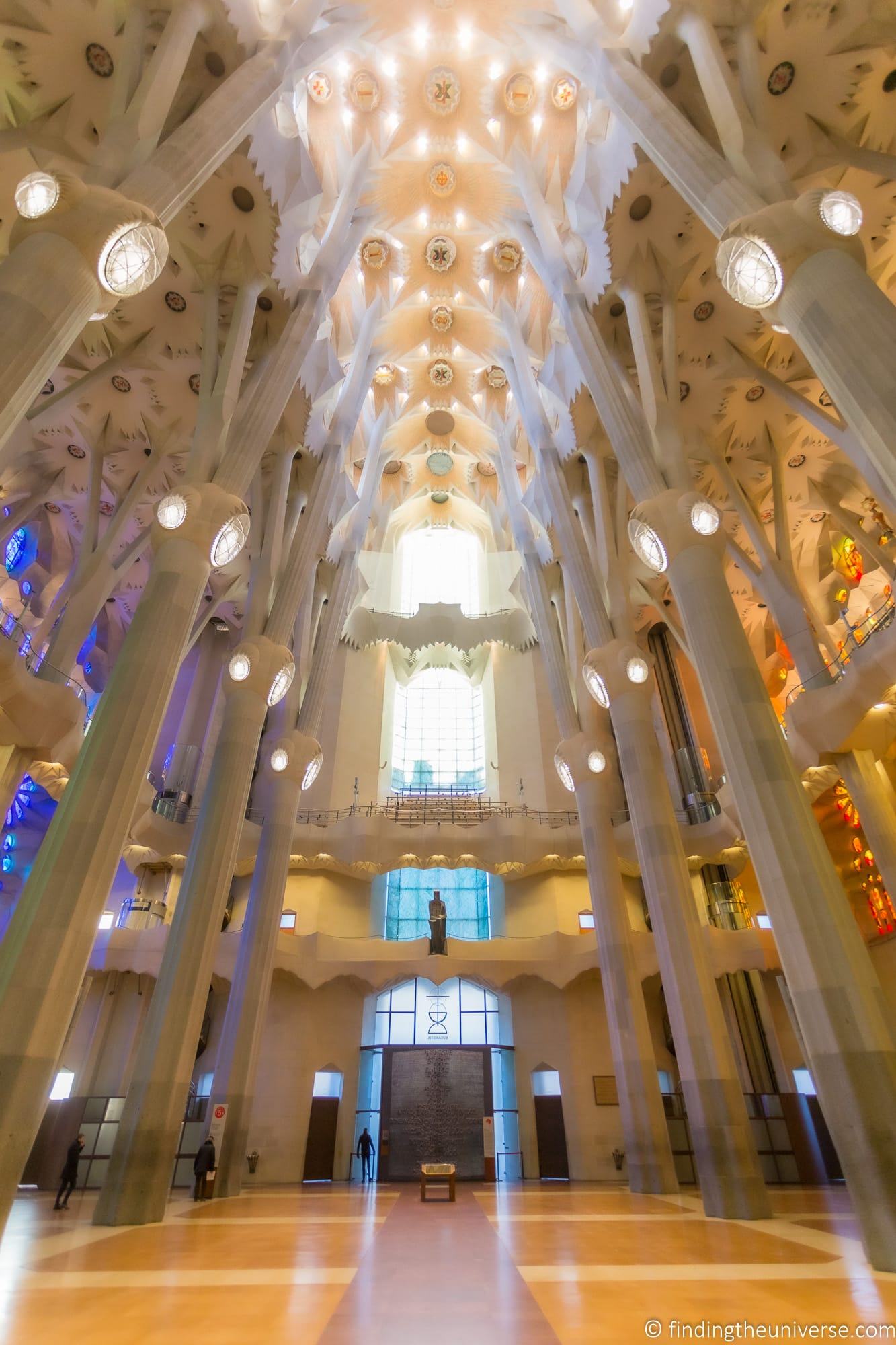
When Will the Sagrada Familia Be Finished?
Current estimates for the full completion of the Sagrada Familia are between 2030 and 2032.
The majority of the church structure and steeples were hoped to be complete by 2026, the 100th anniversary of Gaudi’s death, however this is looking unlikely at the present.
The fun thing about visiting a building that is under construction is that every time you visit it will look a bit different. The downside is that, well, it is an active building site. So expect to see workers, cranes, and all the other aspects that you might expect from a building site!
Where is the Sagrada Familia?
The official address for the Sagrada Familia is Carrer de Mallorca, 401, 08013 Barcelona, Spain. You can see it here on Google Maps.
The Sagrada Familia basically takes up a whole block to the north west of the city centre. It’s sandwiched between two small parks, Plaça de Gaudí to the northeast and Plaça de la Sagrada Família to the southwest.
How to Get to the Sagrada Familia
The Sagrada Familia is a little north east of the city centre, and you have a number of options for getting here.
First, you can walk. From Plaça de Catalunya it’s approximately a 2.4km / 1.5 mile walk, which should take around half an hour.
The next option is public transport. There’s a metro station right next to the church, and the stop name is Sagrada Familia. This services subway lines L2 and L5, and you can get to the Sagrada Familia in around 15-20 minutes from most stops in central Barcelona.
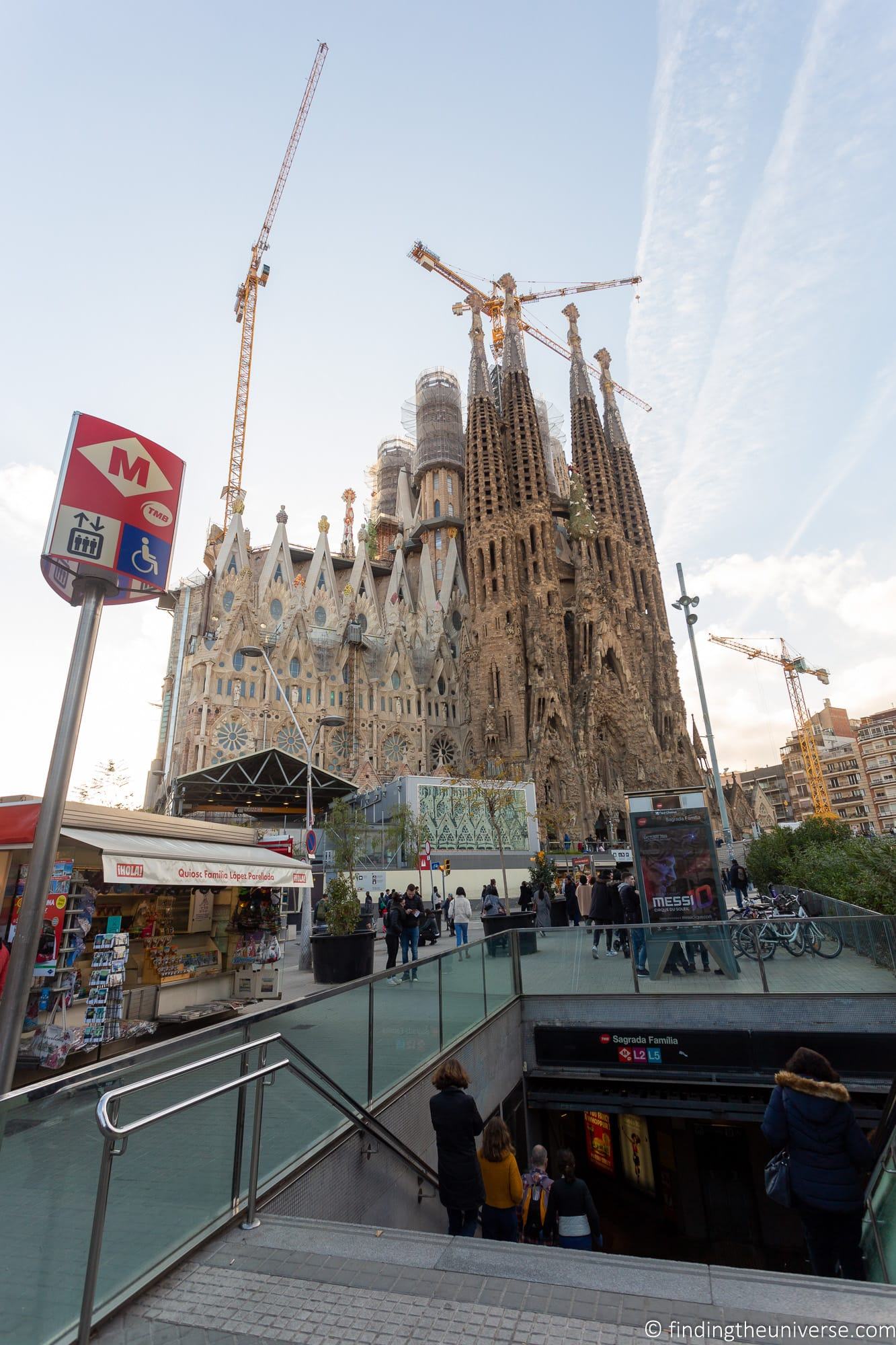
You can also take the public bus, although depending on traffic this will likely take a little longer than the subway, on average around 30 minutes.
Taxis are also widely available in Barcelona. The taxi fare from central Barcelona to the Sagrada Familia will vary, but expect to pay between €6 and €10 depending on where you ride from. Make sure you hail only a licensed cab, these are yellow and black. Free taxis will have green lights in the windows which you can hail, or you can find a taxi stand.
Finally, the Barcelona Bus Turístic (Hop on Hop off bus) has a stop directly outside the Sagrada Familia. This bus route also includes sites like Sant Pau Recinte de la Moderniste and Park Guell, and is a great way to see the city.
You can either buy the Barcelona Bus Turistic ticket directly here , or purchase it as part of a sightseeing pass for Barcelona. For example, it’s included on the Barcelona City Pass and the Go Barcelona Pass .
These passes have a variety of includes and benefits, which you can read more about in our guide to the various Barcelona City Passes here .
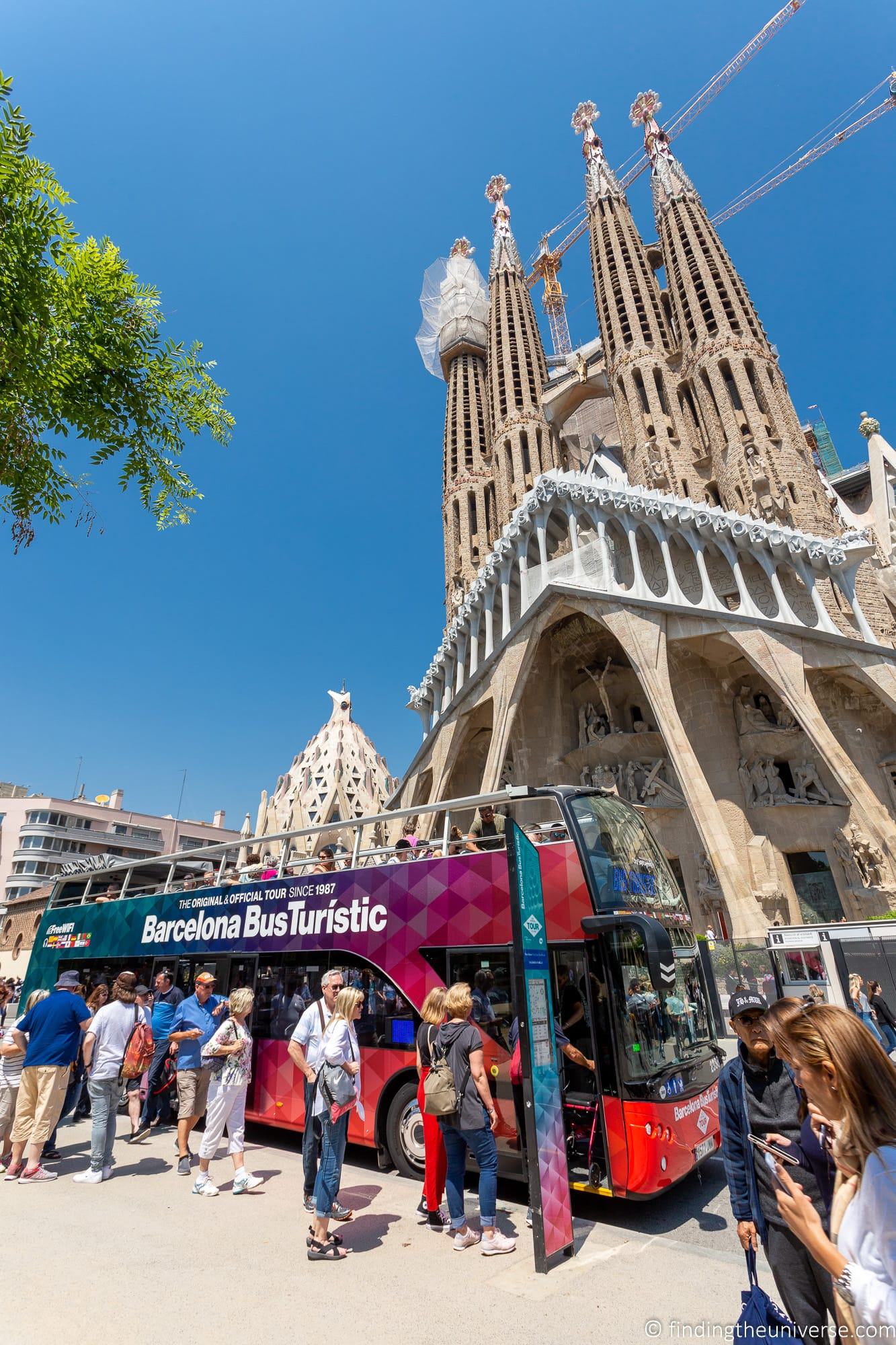
Is the Sagrada Familia Open?
Yes, the Sagrada Familia is open. It was closed for seven months, but reopened for visitors on the 29th May 2021.
Sagrada Familia Opening Times
In normal times, the Sagrada Familia is open every day of the year, including Christmas Day and New Year’s Day. Dates and times vary depending on the time of year, and are normally as follows:
- January to February: Monday – Saturday 9 am to 6 pm. Sundays 10.30am – 6pm.
- March: Monday – Saturday 9am to 7pm. Sundays 10.30am – 7pm.
- April to September: Monday – Saturday 9am to 8pm. Sundays 10.30am – 8pm.
- October: Monday – Saturday 9am to 7pm. Sundays 10.30am – 7pm.
- November to December: Monday – Saturday 9 am to 6 pm. Sundays 10.30am – 6pm.
Exceptions to the above are December 25th and December 26th, and January 1st and January 6th. On these days the opening time is 9 a.m. to 2 p.m.
Note that the ticket office stops selling same day tickets 30 minutes prior to closing time each day.
Very occasionally, the Sagrada Familia closes due to exceptional circumstances. It’s always best to check the official website here for the latest information prior to planning your visit.
Can You Attend Mass at the Sagrada Familia?
Yes, you can attend mass at the Sagrada Familia. It’s an active place of worship, and a number of masses are held throughout the week.
As an international visitor, you will likely want to attend mass in the main area of the church. These are held in multiple languages at least twice a week, to the following schedule:
- Every Saturday and on the eve of holy days of obligation at 8 pm.
- Every Sunday and on holy days of obligation at 9 am
In addition, the Sagrada Familia hosts extraordinary Masses at different times throughout the year. These usually require an invitation and are very popular.
For full details of these masses and how to get invitations for the extraordinary Masses, see the official calendar of masses here .
Attending a mass is free, and is on a first come first served basis. Please be aware that a mass is a sacred affair, and as such appropriate attire and behaviour is expected. Photography is not permitted during the mass, and attendees must be silent and not leave their seat area.
If you wish to attend one of the above masses, you will enter the Basilica on the Nativity façade (Carrer de la Marina). The entrance is open from 8:30 am for morning masses and from 7:30 pm for evening masses, until capacity is reached. We would advise coming earlier than this so as not to miss out. Masses are held in a number of languages.
As well as the above mass, a there are multiple daily masses held in the Sagrada Familia Crypt. These are held in Catalan and Spanish only. See the section on the Crypt for more details on these masses.
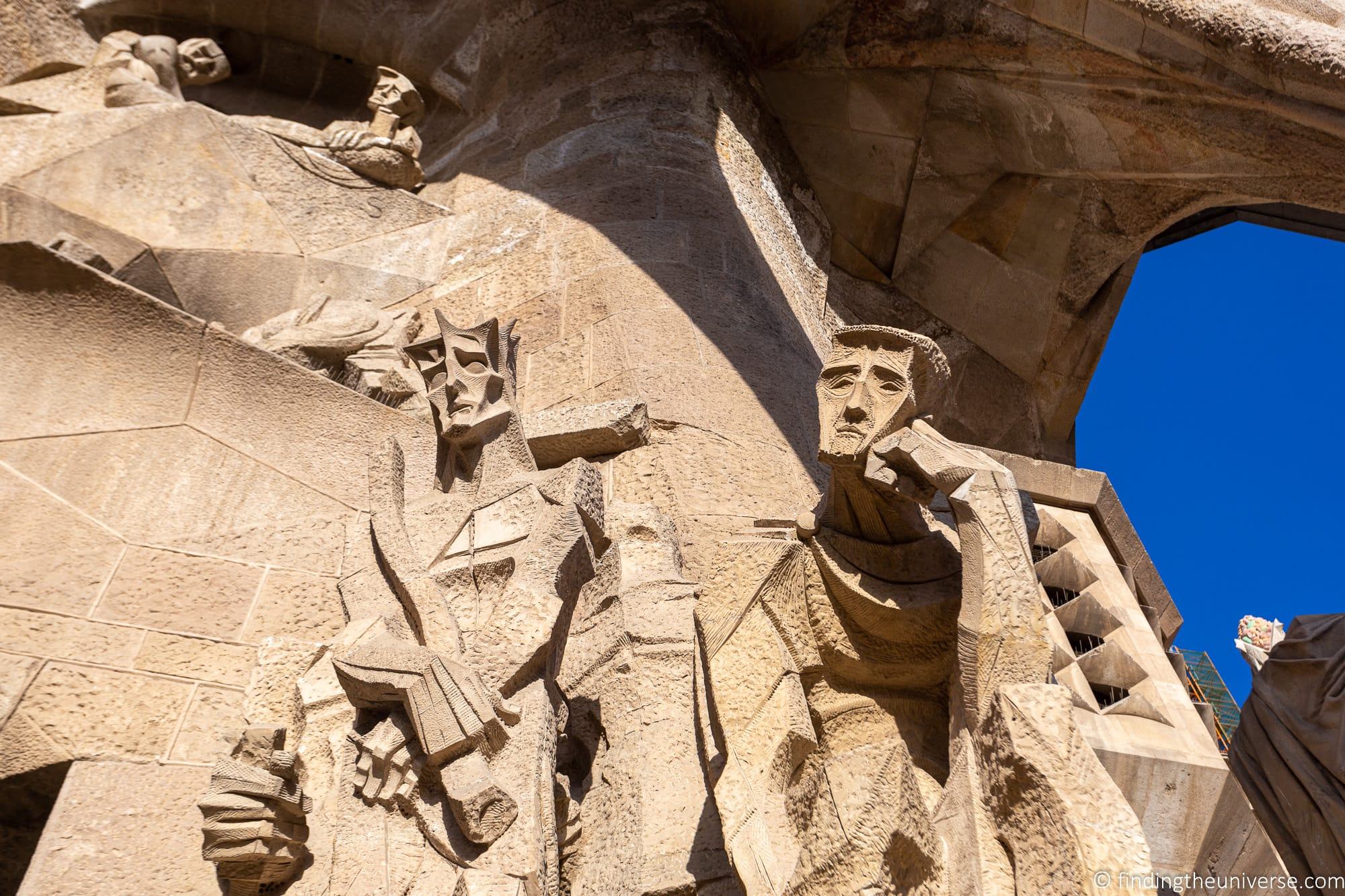
What Can You See at the Sagrada Familia?
There is a lot to see and do at the Sagrada Familia, so expect to spend between 90 minutes and 3 hours on site. Here’s an overview of what you can expect to see. All of the below is included on the standard entry tickets, with the exception of the tower climb, which requires a special ticket.
Exterior of the Sagrada Familia
The Sagrada Familia is an impressive sight – whether you glimpse it from afar, or if your first sight of it is as you emerge from the metro station nearby.
Combining all the styles that Gaudi worked with (Gothic, Catalan Modernism, and Art Nouveau), and featuring his signature architectural elements like hyperboloid and paraboloid structures, the building is a visual feast.
Some of the most popular exterior design sections are the detailed facades. There are currently two of these – the Nativity and the Passion Facade. The third facade, the Glory facade, is under construction. When finished this will be the largest and most spectacular of the facades, and will serve as the main entrance to the church.
Each of these facades tells the story of a different part of the life of Jesus Christ. The Nativity Facade tells the story of the birth of Christ, the Passion Facade focuses on the crucifiction of Christ, whilst the Glory Facade represents the road to God and Glory.
In terms of construction, the oldest facade is the organic looking Nativity Facade, which was the first facade to be completed. This was the one that Gaudi had the most control over. You will get an up close view of this as you enter the church today, as this is where the main visitor entrance currently is.
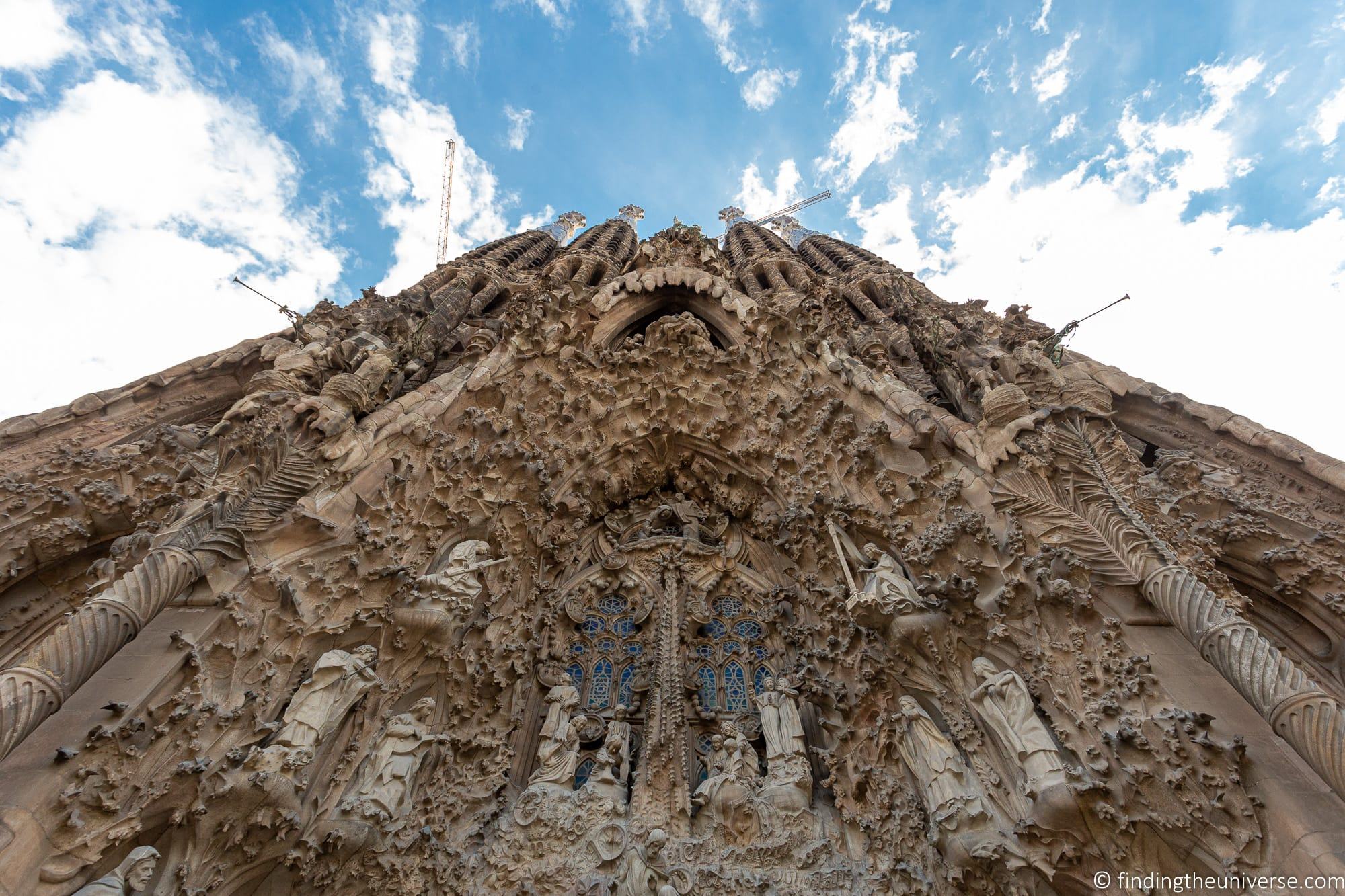
The Passion Facade is much more austere, with lots of angles, and has a completely different look and feel to the Nativity Facade. You will get a close up view of this as you leave the church, as this is where the visitor exit currently is.
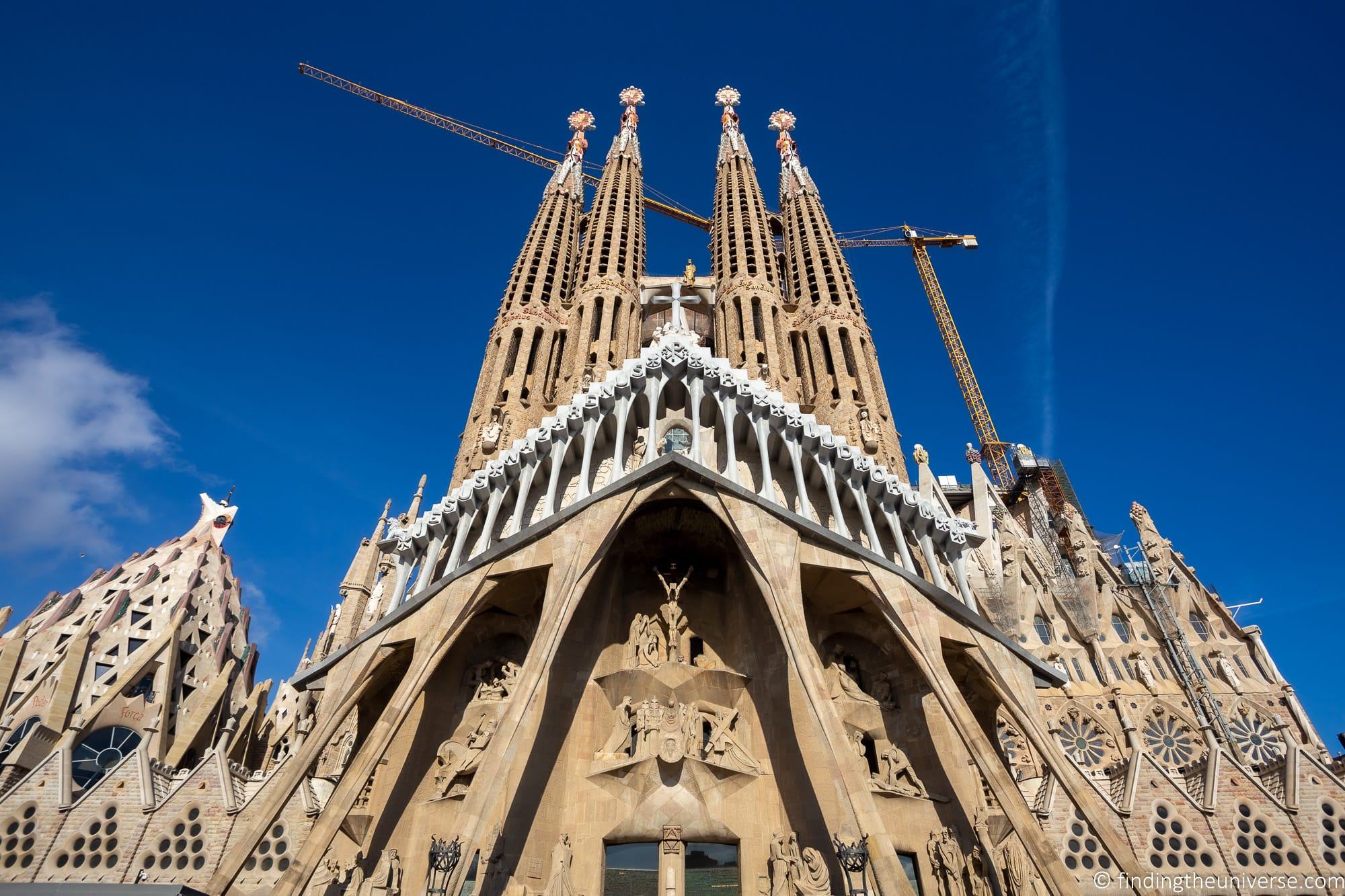
As well as the facades, there are a number of design elements all over the church, and of course, the immense towers, of which there will be eighteen when the construction is finally completed.
Basically, don’t rush straight in to the church. We recommend arriving a little earlier than your scheduled visit, so you can appreciate the exterior of the building before heading inside. Then head to the line a couple of minutes before the timeslot.
Nave and Main Interior of the Sagrada Familia
If you thought the outside of the Sagrada Familia was impressive, just wait until you walk inside. You’re going to be greeted by a huge five-aisled nave, with the roof far overhead supported by giant tree like columns. Colorful light, filtered through the stained glass windows, illuminates this area.
It’s kind of life walking into some sort of surreal dream forest, which was kind of the look Gaudi was going for. He definitely succeeded.
Once you have gotten over this impressive spectacle, managed to close your mouth, and take some photos, you’ll want to explore what else is on offer. There’s lots to see, including the nave, transept, and the apse where you’ll find seven chapels.
If you book a ticket with an audioguide or tour, which we highly recommend, this will give you all the detail you need to help you understand what you are seeing.
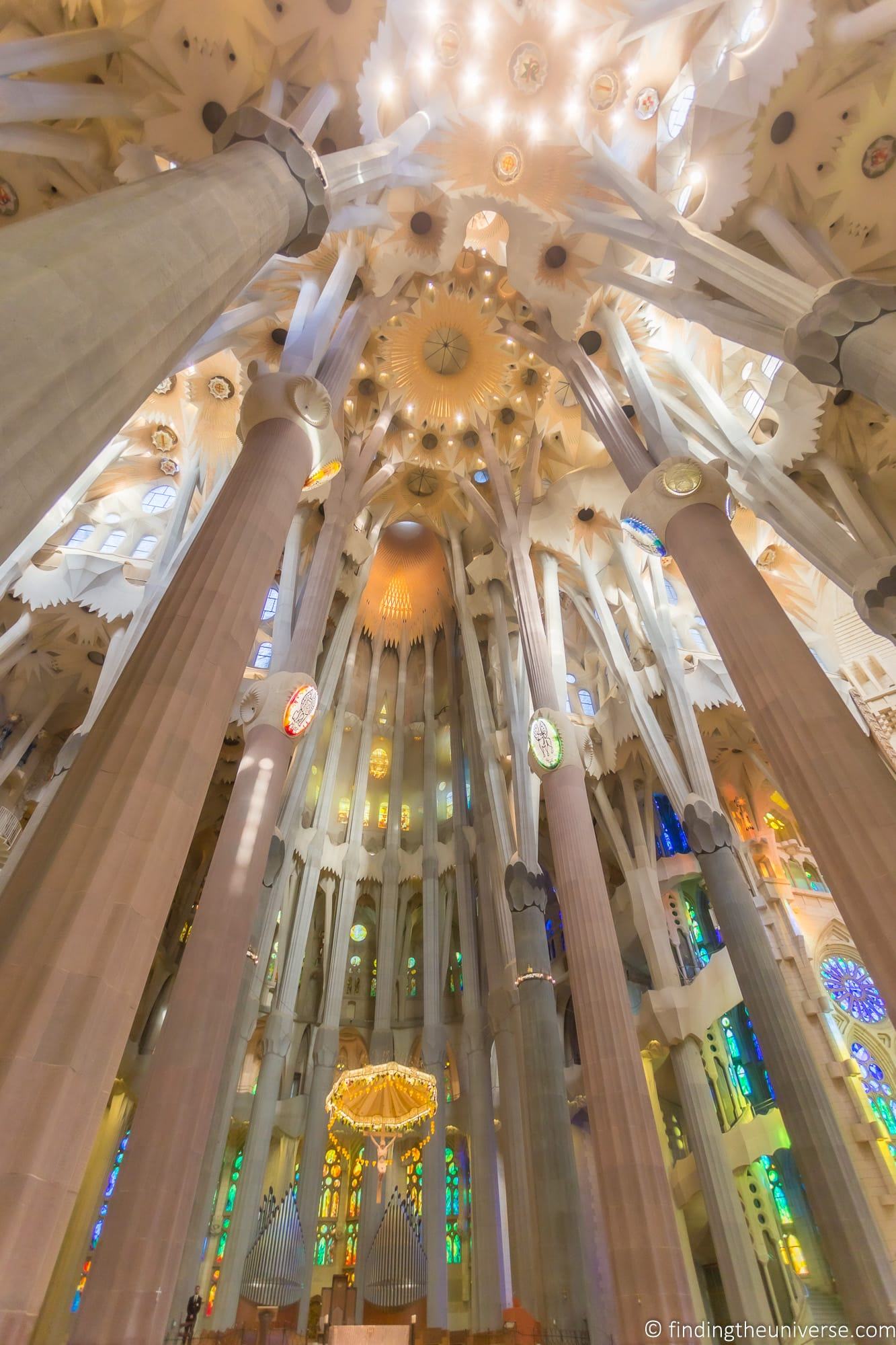
Sagrada Familia Crypt
The Crypt of the Sagrada Familia lies underneath the main apse of the church. It is the place where Gaudi himself is buried.
The Crypt was was completed during Gaudi’s lifetime, and as such is one of the few areas of the church he saw completed.
The Crypt is also a parish church, and mass is held here daily in Catalan and Spanish. The crypt is only open around mass hours, and can be visited at the following times:
- Monday – Friday: 9:00 am – 10:00 am and 6:00 pm – 9:00 pm
- Saturday, Sunday, and public holidays: 9:00 am – 2:00 pm and 6:00 pm – 9:00 pm
Note that as a visitor not wishing to attend mass, you will want to visit the crypt outside of the actual mass itself. Mass is held at the following times:
- Monday to Friday – 8.15pm (Catalan) and 9am (Spanish)
- Saturday – 7.30pm (Catalan) and 9am (Spanish)
- Sunday – 10.30am, 1pm, 6.30pm (Catalan) and 11.45am & 8.15pm (Spanish)
If you compare mass times with the opening times of the crypt, I would suggest the best time to visit the Sagrada Familia crypt would be between 6pm and 8pm Mondays to Fridays, 10am – 2pm or 6pm – 7.15pm on Saturdays and 9am – 10.15am on Sundays.
Along with the Nativity Facade, the Crypt is listed as a UNESCO world heritage site, part of the works of Antoni Gaudi world heritage site, which includes seven locations in Barcelona.
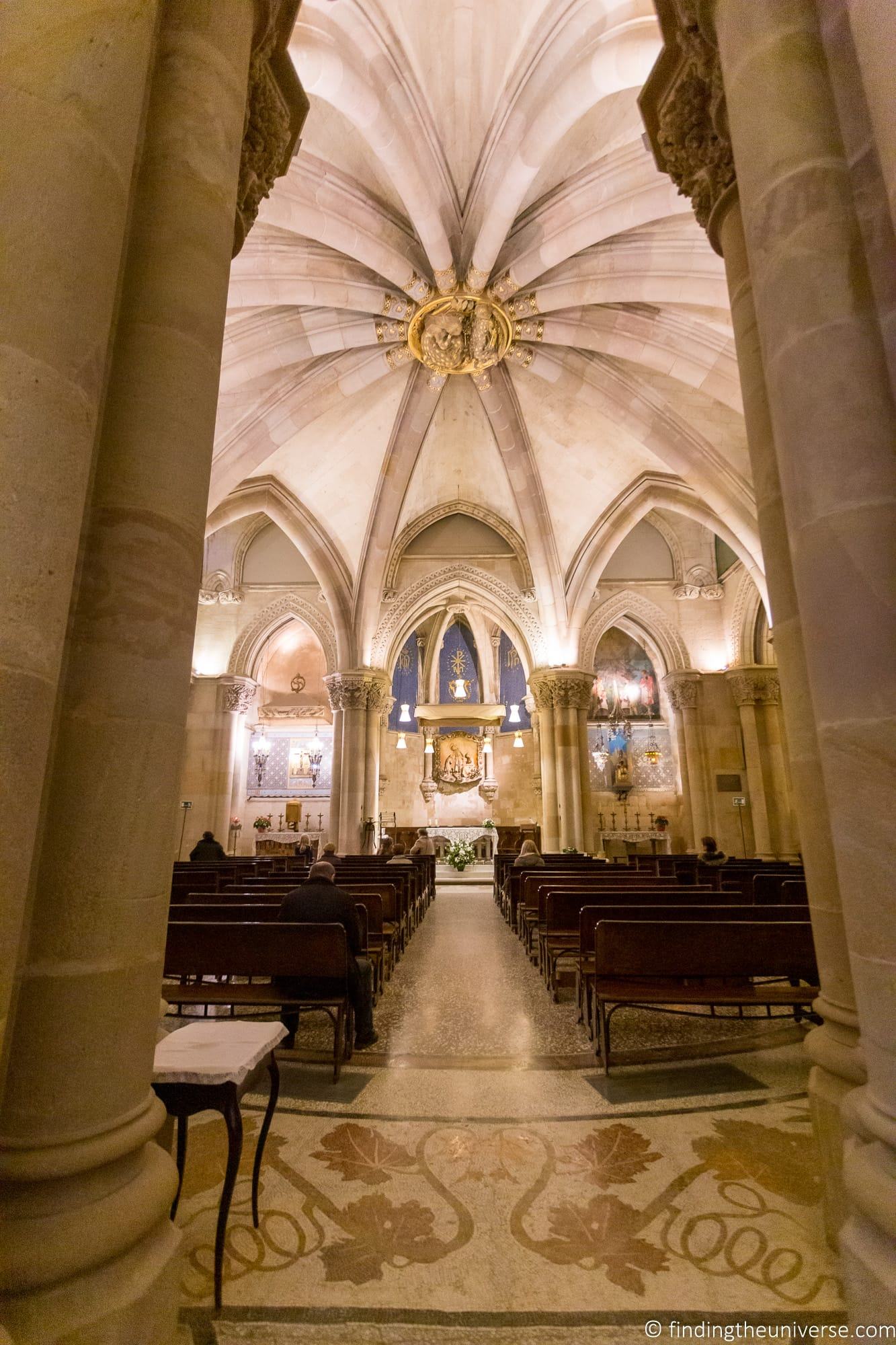
Sagrada Familia Museum
A highlight of any visit to the Sagrada Familia, the museum is on the ground floor underneath the main church.
Here, you will learn more about Gaudi, the man behind the church, as well as the history of the construction and design of the building itself.
There’s a lot to see here, so don’t feel rushed. It’s a great place to really get a feel for what goes into creating such a monumental work of art.
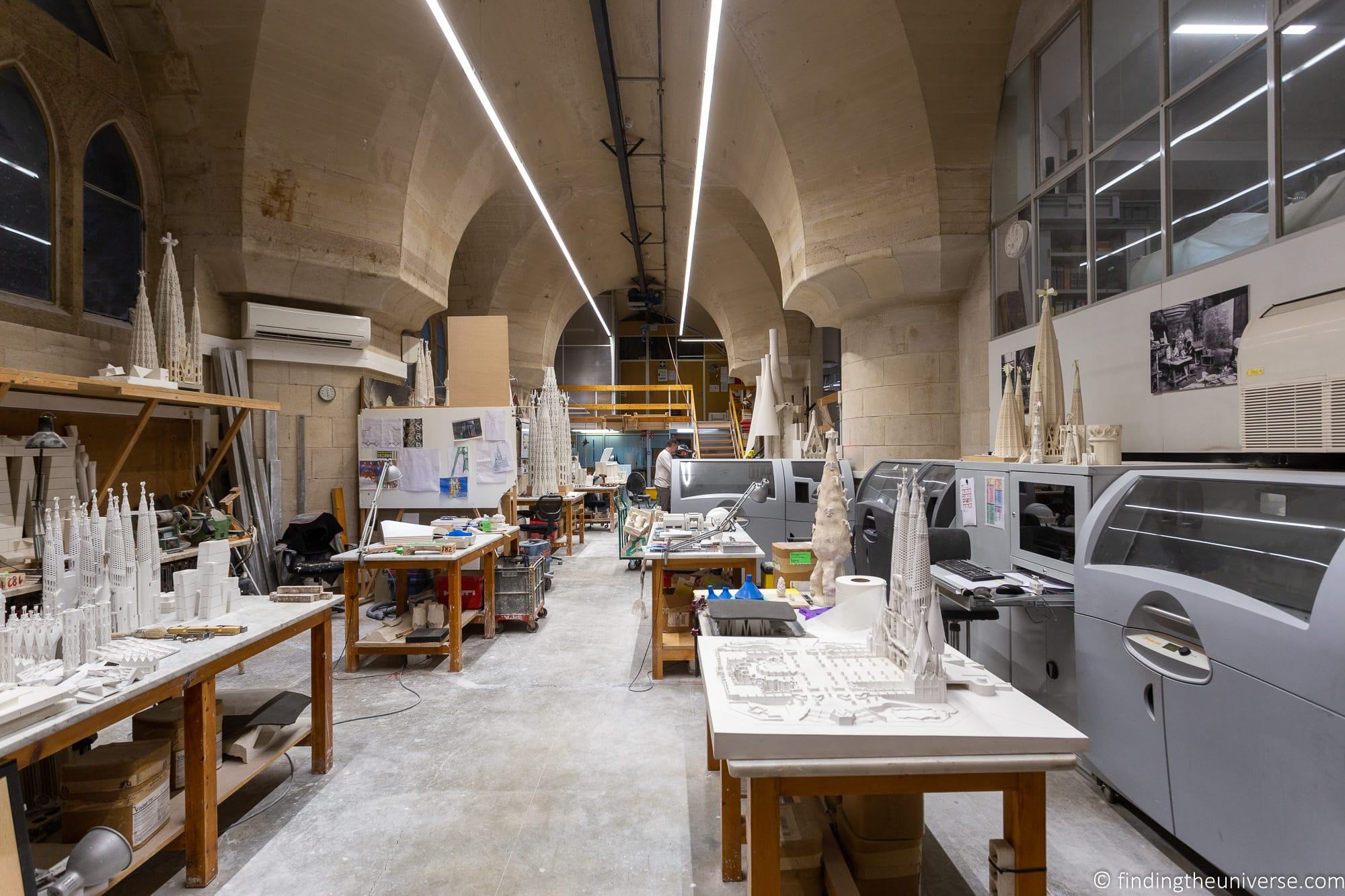
Sagrada Família Schools
On the Passion Facade side of the Sagrada Familia, tucked away in the southern corner, you will see a small building with an organic looking design.
This is the Sagrada Familia Schools building. In 1909, Gaudi has this building constructed on site to serve as a school for the children of the construction workers. It was originally in a different location on the site, but was moved during the construction. It may of course move again, although current plans do not show this as happening.
Today the school can be visited as part of your Sagrada Familia visit, and is home to a number of models used as part of the construction of the Sagrada Familia. There’s also a room set up as a school room from the time, to give you an idea of how it might have looked.
The building is also used for school groups and programs so is sometimes closed to the public when these are happening. It’s also worth noting that the building was badly damaged in a fire, so most of it is not original, however it has been rebuilt as closely to the original design as possible.
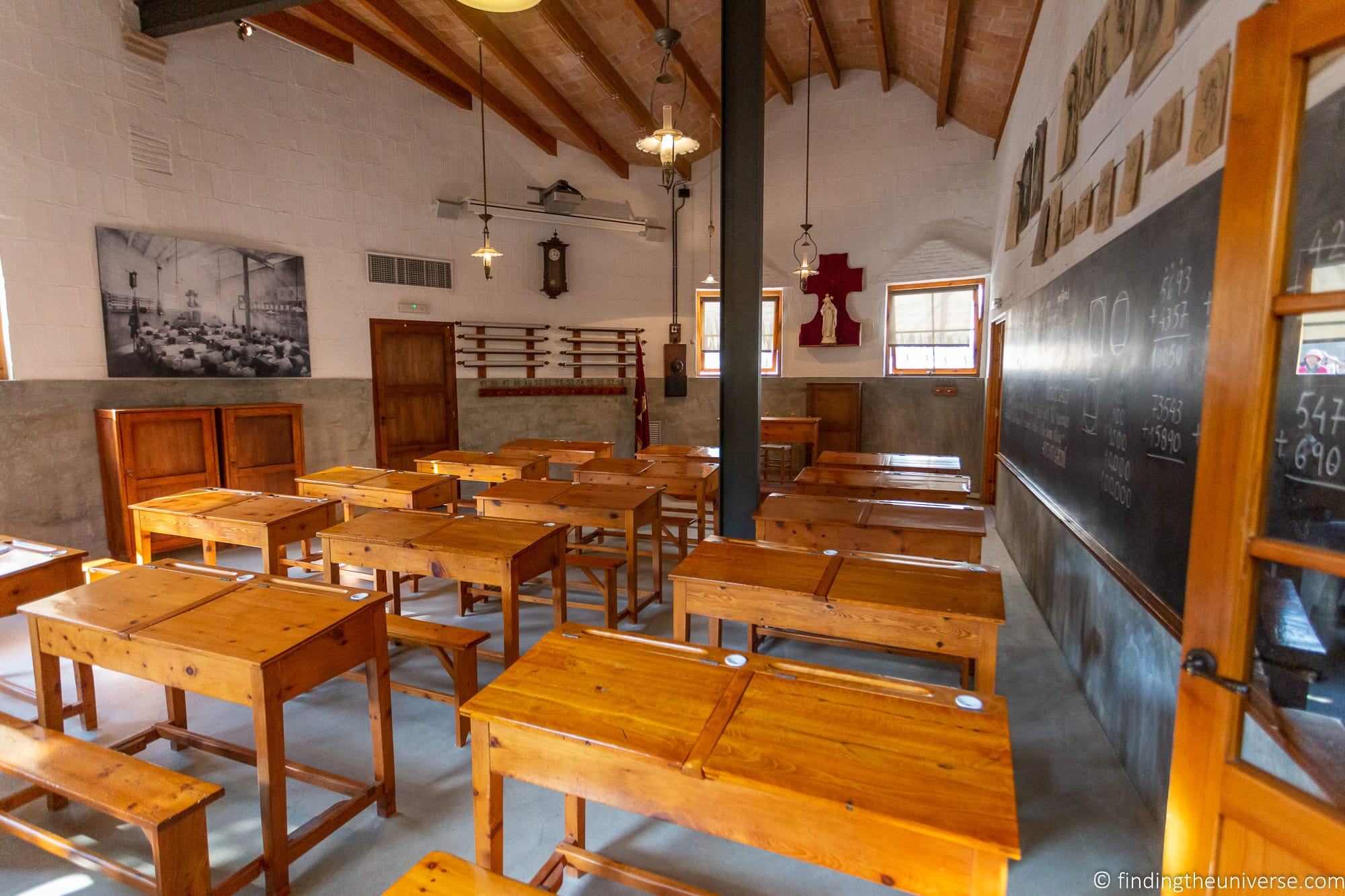
Sagrada Familia Gift Shop
The Sagrada Familia is a major tourist attraction, and as you might imagine, there’s an extensive gift shop on site.
There are in fact two gift shops. There’s one in the museum, and then another on the Nativity Facade side of the building near the group entrance.
The gift shop in the museum can only be visited by ticket holders; however, the ticket office on the Nativity Facade side of the basilica can be visited by anyone. So if you don’t want to go inside and buy a ticket, you can still check out this gift shop if you are hunting for some souvenirs.
However, be aware that when you enter this gift shop you are leaving the ticketed area. Only do this when you are ready to leave, as you will not be able to return to the church once you have left the ticketed area without getting a new ticket.
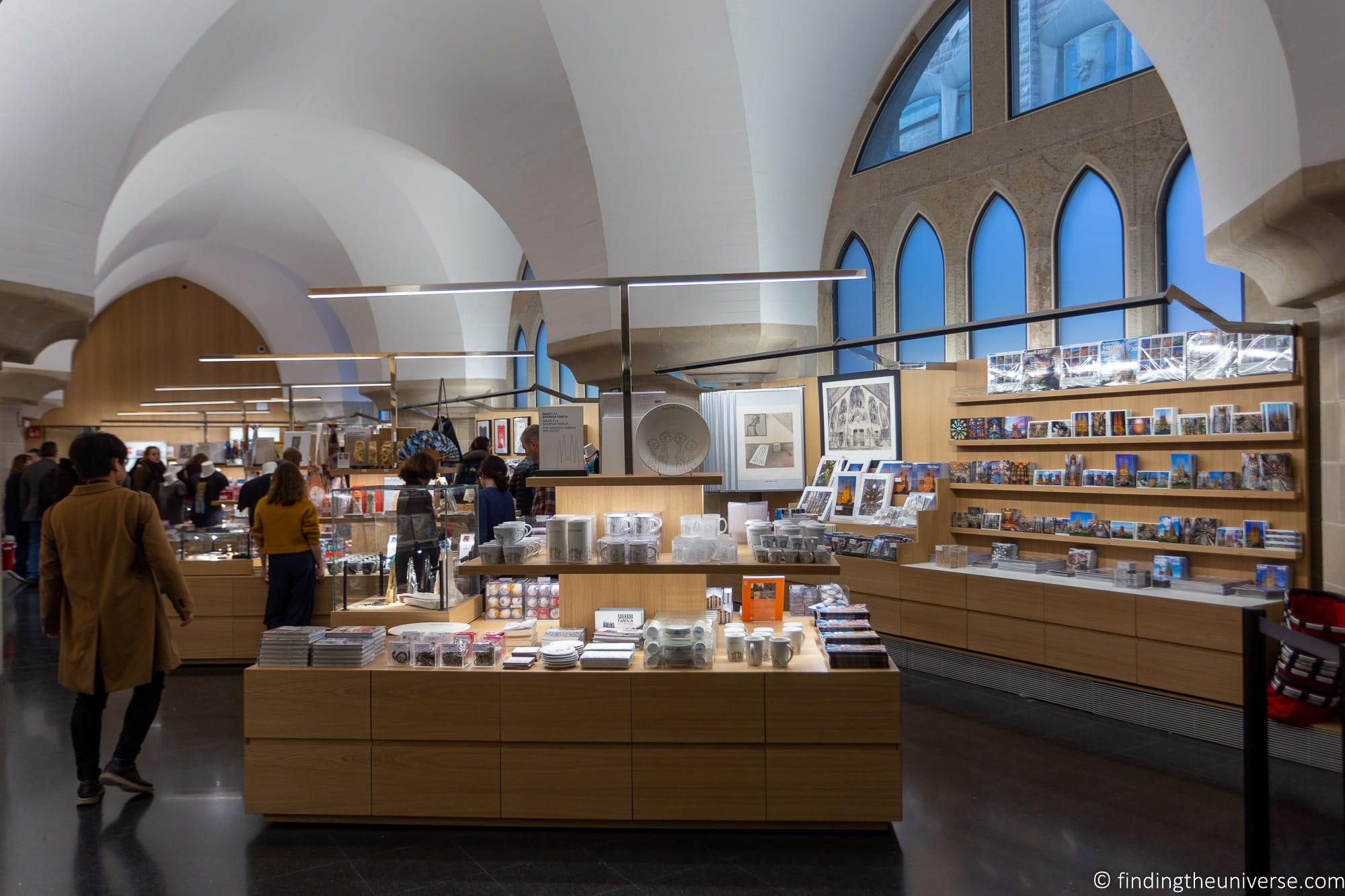
Climb Inside the Passion and Nativity Towers
If all goes as planned, when the Sagrada Familia is complete, it will have 18 towers in total. There are 12 towers to represent each apostle, one for the Virgin Mary, four for the Evangelists, and then the huge central tower to represent Jesus Christ.
The main tower will be an impressive 566ft / 172.5 metres in height when completed, making it the tallest church building in the world.
In the future you will likely be able to visit more of the towers, but currently you can only visit two of the towers, the Passion Tower and the Nativity Tower. These towers require a special ticket, but visitors who opt to visit them will be rewarded with great views over the city, as well as an up close view of elements of the church that cannot be seen from anywhere else.
See more on visiting the towers in the section below about which tower to visit, and whether the towers are worth visiting.
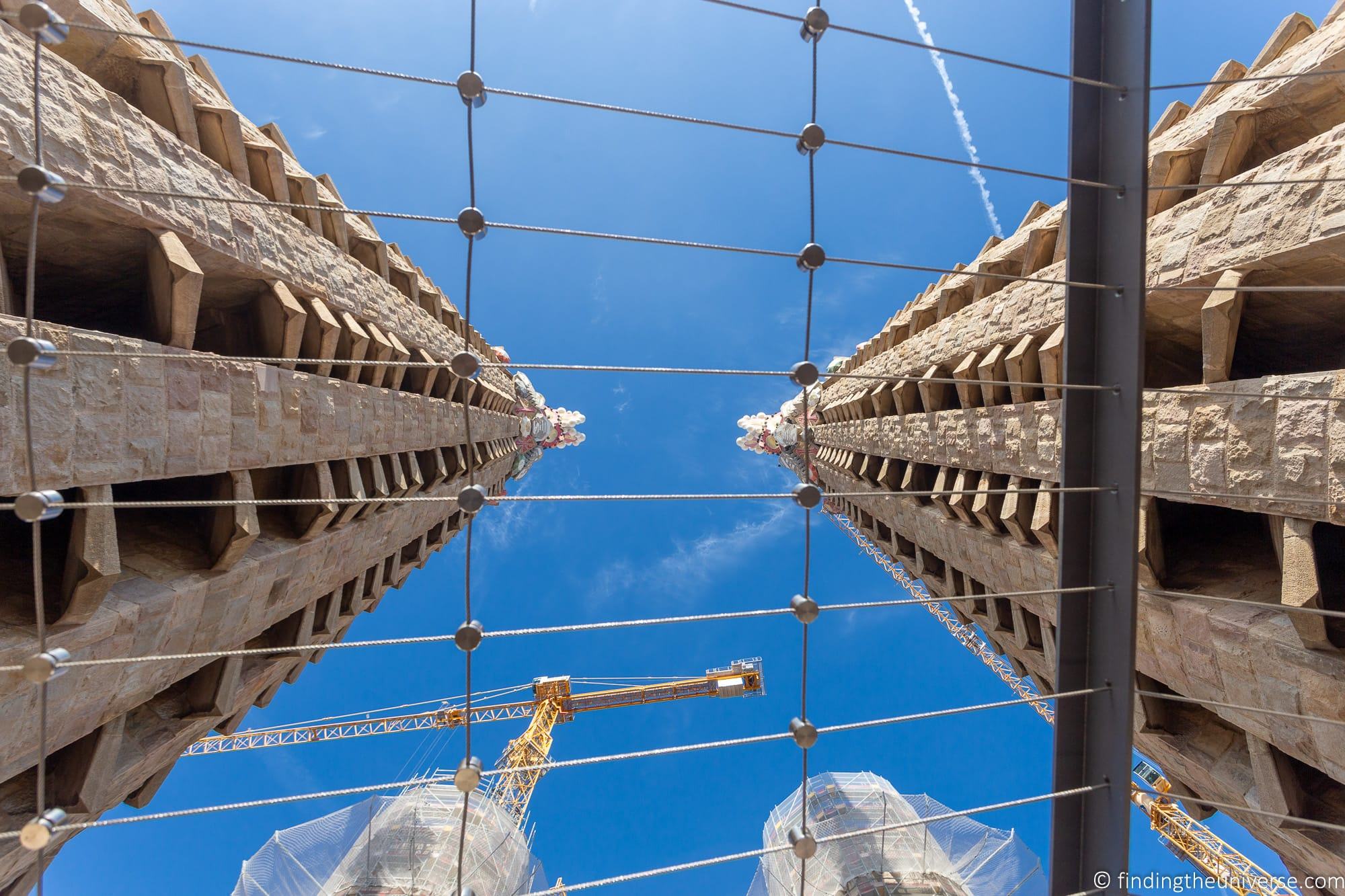
Do You Need a Ticket to Visit the Sagrada Familia?
Yes, you need a ticket for the Sagrada Familia. In addition, tickets are timed, so when you book a ticket it will be for a specific time slot. See more on where to buy Sagrada Familia tickets and ticket pricing further on in this guide.
The only time you don’t need a ticket for the Sagrada Familia is if you are attending mass. See the section on attending mass in this guide for more information on this.
How Much Does it Cost to Visit the Sagrada Familia in 2024?
Pricing for the Sagrada Familia varies depending on a number of factors, including what time you visit and what inclusions you want on your ticket.
Here’s an overview of the prices if you buy from the official website as of the time of writing. We’ll do our best to keep this updated, but do check the official website for latest prices. Prices are up to date as of January 2024.
- Sagrada Familia Basic Ticket – €20 (only available for the last two hours each day, not always available)
- Sagrada Familia – €26 (includes audioguide, available all day)
- Sagrada Familia with guided tour – €30
- Sagrada Familia with guided tour and towers – €40
- Sagrada Familia with Towers – €36 (also includes audioguide)
Some notes on the above tickets.
First, the prices above are when purchased from the official website. There is normally also a ticket office on site for same day tickets, but prices are higher. The price difference varies by ticket, but expect to pay around €4 – €6 more per ticket in person.
Note: the on-site ticket office is currently closed.
The cheapest ticket is the €20 ticket. This doesn’t include any extras like an audioguide, and is only available for the last two hours each day. It can only be bought online, not in person. This ticket is not always available for purchase.
The next ticket is the most widely available, which is the Sagrada Familia with audioguide. This is available in 16 languages, and the audioguide tour lasts for around 45 minutes. There’s also an express version which lasts for 25 minutes. Once you have completed the audioguide you are free to continue your tour.
Then there’s the option to visit with an official guided tour. Tours are available in five languages, and last around 50 minutes. Groups are limited to 30 people per group. Once the tour is over you can continue to explore on your own.
You can also buy a joint ticket for the Sagrada Familia and the Gaudi House Museum (his final residence), which is located in the unticketed part of Park Guell. This ticket includes an audioguide for the Sagrada Familia. The combined individual price of these tickets is €32.50, so this ticket is a good saving if you plan on visiting both locations.
Finally, you can buy a Sagrada Familia ticket with towers. This ticket includes an audioguide tour of the Sagrada Familia, as well as access to one of the towers. You have to choose which tower you want to visit when you purchase the ticket. See the section below on which tower to choose.
Of all the above options, the cheapest way to visit the Sagrada Familia is with the basic ticket. Just be aware these have limited availability, as you can only buy them for the last two hours of each day. They are also only available online.
Also, all tickets have a timeslot. You are only permitted to join the entry line for the timeslot marked on your ticket. If you miss your timeslot, you will generally need to buy a new ticket, unless the reason for missing the ticket was as a result of construction work at the Sagrada Familia.
Depending on various factors, not all the tickets will always be available to purchase.
Are there Concessions for the Sagrada Familia?
Yes, there are concessions available for the Sagrada Familia.
Children under 11 can visit the basilica free of charge with an adult. A ticket is still required.
If you are under 30 or a student, you will pay €2 less per ticket. Students will need to bring a student card to show on entry, those under 30 should bring proof of age like an ID or passport.
In addition, on Wednesdays through Fridays, visitors under 30 are able to purchase tickets for 50% off the normal price for the last two hours of the day.
Those with a proven disability can visit the basilica free of charge in the last two hours prior to closing each day. They may bring one companion who can also enter free of charge. Additional services like audioguides must be paid for. A ticket is still required as you need to book a timeslot.
Seniors (those 65 and over) are also eligible for concessions. This varies by ticket type but is in the region of €4 – €6 discount per ticket.
You can see more on current concessions and amounts on the website here . All of the above concessionary ticket types, including disabled access and child tickets are available on the official website.
Where to Buy Sagrada Familia Tickets
There are a number of options for purchasing Sagrada Familia tickets, which we will go through so you know all your options, and which is best.
1 – Official Website
The first place we recommend you look is the official Sagrada Familia website here . This has real-time availability, and tickets can be purchased for both same-day visits, as well as up to two months in advance. You can also buy concession tickets here.
2 – On-site Ticket Office (currently closed)
If you are already at the Sagrada Familia, there is a ticket office on site. Note that this ticket office can only sell tickets for the same-day, and prices are higher than the website prices. There can also be long lines here, so honestly, we’d advise buying online if you can.
The on site ticket office is by the exit to the Sagrada Familia, on the Nativity Facade side by Carrer de Sardenya. Large screens outside the ticket office show what timeslots are available for the day.
Our suggestion for the best place to buy Sagrada Familia tickets is the official website which at the time of writing does not charge any booking fees.
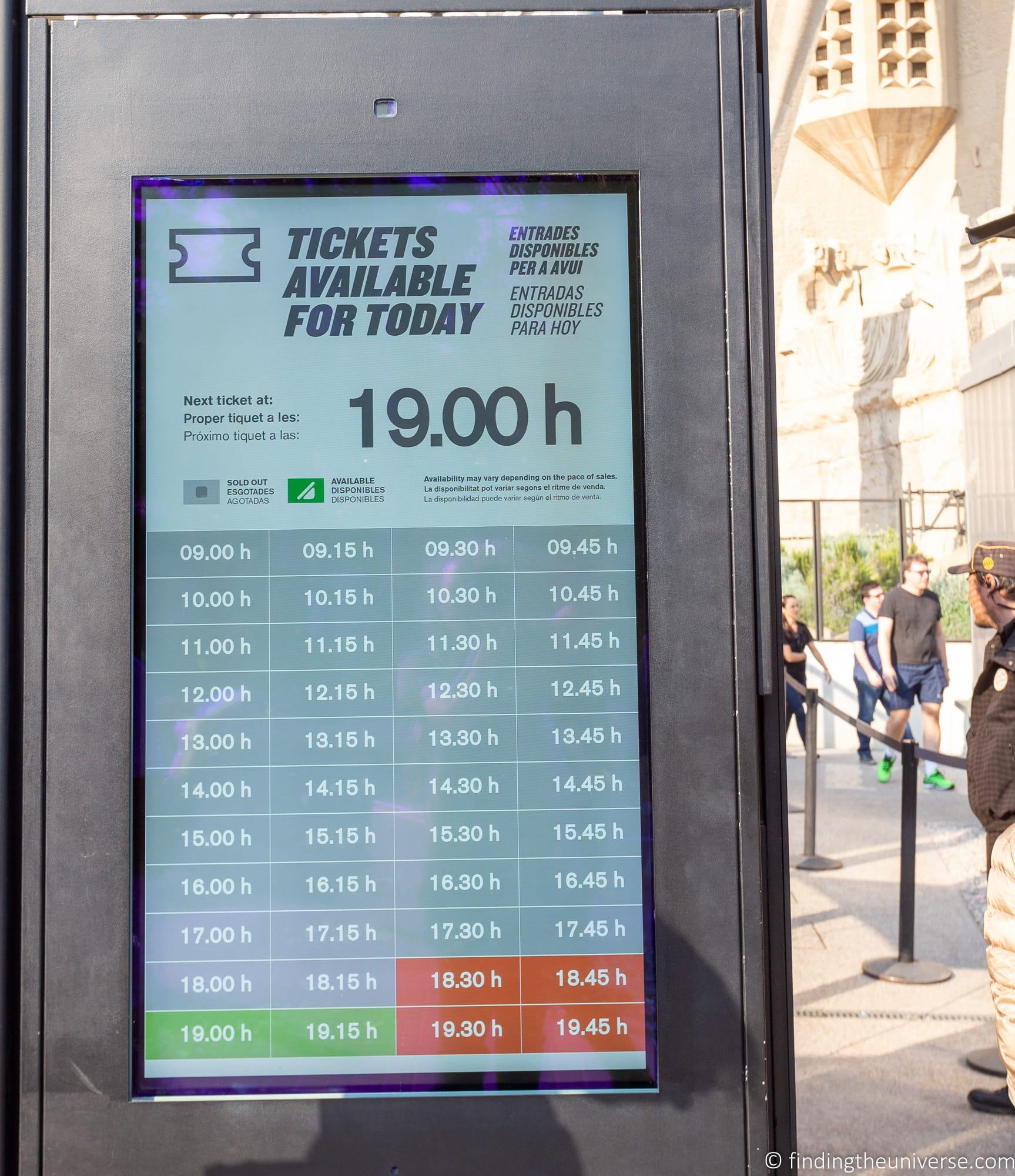
3 – Third Party Booking Sites
There are also a number of third party websites where you can buy tickets for the Sagrada Familia. Obviously these sites need to make a revenue, and so usually charge some kind of booking fee or other commission. For this reason the official site would be our preference.
Our recommended option is this website . They provide real time availability of tickets, as well as all the ticket types and concessions available.
You can also find Sagrada Familia tickets online here with GetYourGuide , and here with Viator . Again, these will usually be more expensive than the official site, but are worth checking when the Sagrada Familia is sold out just in case.
GetYourGuide tickets have the advantage (last time we checked) of free cancellation up to 24 hours before your visit, which can be very helpful if your plans change.
4 – Tour Companies
Another option is to either book a tour with a third party company like this , or to buy an attraction pass like this which includes Sagrada Familia entry as well as other discounts. More on these options further on in the guide.
Sagrada Familia Sold Out? Your Options.
As mentioned in this guide a few times, the Sagrada Familia is a very popular attraction in Barcelona, and tickets to the Sagrada Familia do sell out. This happens in particular around religious holidays such as Easter, as well as during the peak tourism season in Barcelona, usually over the summer months.
This is why it’s always best to buy tickets in advance. Tickets on the official Sagrada Familia website are usually available around 2 months in advance.
Of course, we appreciate not everyone can plan this far in advance. Maybe you have a last minute trip to Barcelona planned. Maybe you’re not a detailed planner. Whatever the reason, if there are no tickets available for the Sagrada Familia, you will likely still have some options to be able to visit.
1 – Check Other Days
First, check the official website of the Sagrada Familia to see if other days are available. It might be that by just juggling your itinerary slightly, you can visit on another day of your trip.
2 – Check Other Ticket Types
Second, check to see if other ticket types are available on the official site. There are a range of different ticket types to choose from for your visit, and it might be that one of these has availability, such as a guided tour or a tower ticket.
3 – Check Third Party Ticket Sites
Next, check to see if any of the third party sites have availability. In our experience, if the Sagrada Familia website is sold out, then standard tickets on third party sites will also be sold out.
However, you can try. We suggest trying Tiqets here , GetYourGuide here and Viator here .
4 – Book a Tour (most likely to succeed)
We think your best option for visiting the Sagrada Familia when it is sold out is to book a tour of the Sagrada Familia with a tour company.
These tours will be more expensive than a standard ticket, but because group tickets come out of a different allocation to individual tickets they are often available even when the Sagrada Familia is “sold out”.
You also get the advantage of a guided tour, which we think is well worth it for learning about what you are seeing.
You can either take a tour which includes the Sagrada Familia as part of a wider tour of the city, or one which just focuses on the Sagrada Familia. Here are some options to consider.
- Go Barcelona Pass . The Go Barcelona Pass includes a guided tour of the Sagrada Familia, as well as access to over 40 activities and attractions across the city. If you are planning on visiting a number of attractions in Barcelona, this is a great value option.
- Barcelona in a Day : This full day tour of Barcelona has you visiting La Sagrada Família, Casa Milà, the historic city center and even taking a sailboat cruise. An excellent introduction to the city.
- Skip the Line Express Sagrada Família Tour & Tickets – If you want a guided tour of the Sagrada Familia and are struggling to get official tickets, this is a great option with one of our favourite walking tour companies
- Sagrada Familia Guided tour – A 1.5 hour guided tour of the Sagrada Familia. It’s always worth checking different tours, as if one is sold another company might have availability.
- Complete Gaudí Tour : Interested in learning more about Gaudi and seeing several of his most famous works? This tour features some of the architects highlights, including Casa Batlló, Park Guell, and of course the Sagrada Família. It even includes a Tower Climb of the Sagrada Familia.
- Sagrada Familia Guided Tour – This is a 1.5 hour long guided tour of the Sagrada Familia with a relatively small group
- Sagrada Familia Small Group Guided tour – This is a 1.5 hour tour with no more than 15 people
There are lots more guided tours to choose from of course. See Tiqets here , GetYourGuide here and Viator here for more options.
5 – Attend Mass
Another option for visiting the Sagrada Familia if it is sold out is by attending a mass in main Basilica. These are free and on a first come, first serve basis, usually held on Saturday evenings and Sunday mornings. See the section on mass in the Sagrada Familia in this guide for more information.
Be aware that visiting for mass time is not a good time for getting photos or wandering around, as both these activities are forbidden during mass. Instead, it’s a good time to see the church in use for its intended purpose.
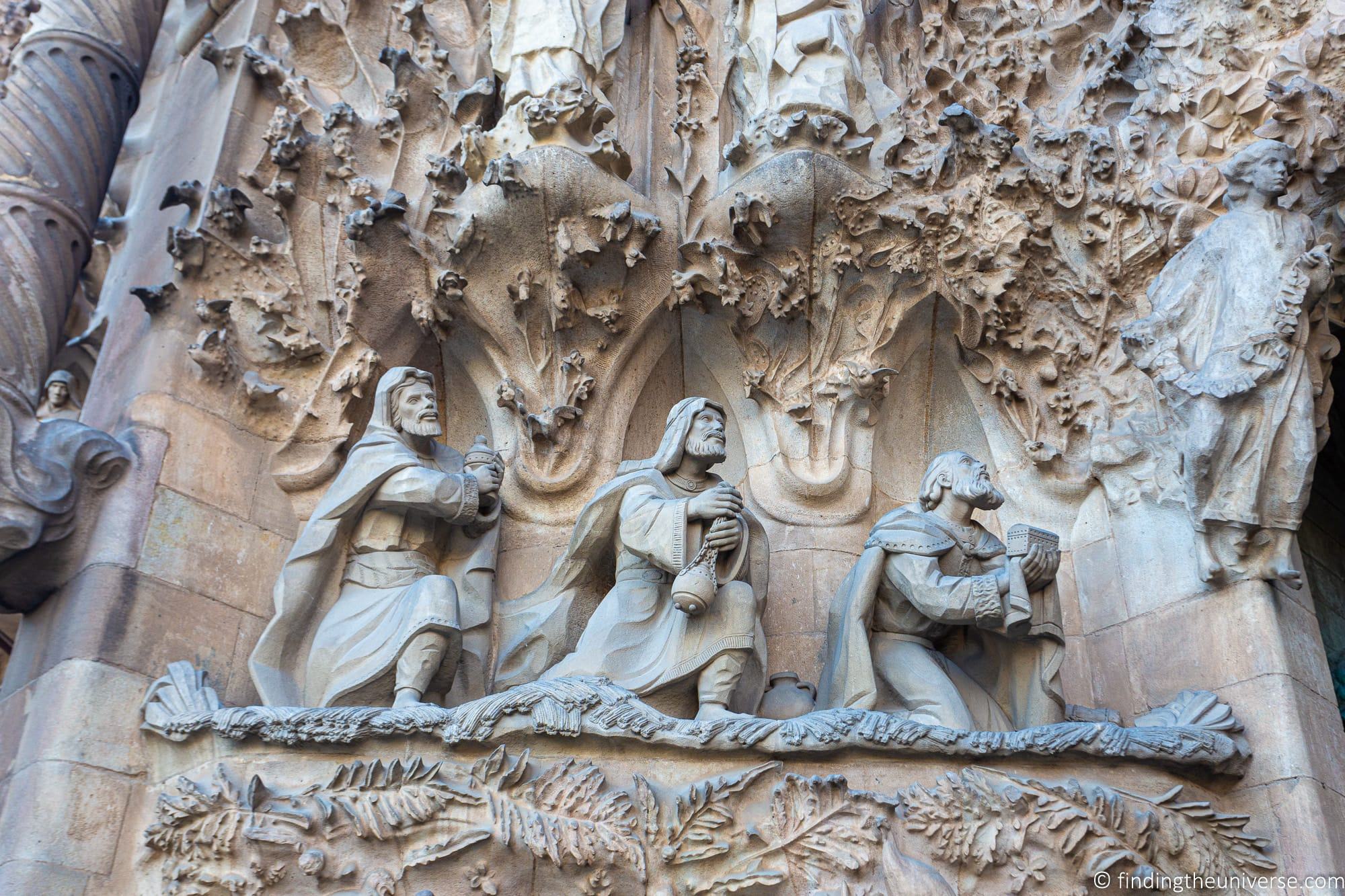
Tours of the Sagrada Familia
We can very much recommend taking some kind of tour of the Sagrada Familia. There is a huge amount to see here, with fascinating architecture and symbolism, and a tour is one of the best way to truly understand what you are seeing.
When you take a tour, a knowledgeable guide will tell you everything you need to know about the building. You’ll also be able to ask any questions you have, and get pointers on what to focus on when the tour is finished.
If you want to take a guided tour of the Sagrada Familia, you have a few options.
The best value tours are offered by the Sagrada Familia itself, and can be booked directly on the official website. These last approximately 50 minutes and have a maximum group size of 30 people.
However, we actually recommend considering one of the tours below. These tend to be longer, more comprehensive tours with fewer people, and are generally specifically geared towards English speaking visitors.
You can either take a tour which includes the Sagrada Familia as part of a wider tour of the city like this , or one which just focuses on the Sagrada Familia like this .
Here are some options to consider. All of these tours include entrance to the Basilica – something you will want to check before you book a tour with any company. Some also include tower access, so when comparing prices do check what is and what isn’t included, tour length and tour size.
- Complete Gaudí Tour : Interested in learning more about Gaudi and his works? This tour features some of the architects highlights, including Casa Batlló, Park Guell and of course the Sagrada Família. It even includes a Tower Climb of the Sagrada Familia.
- Sagrada Familia Guided Tour – this is a 1.5 hour long guided tour of the Sagrada Familia with a relatively small group
- Sagrada Familia Small Group Guided tour – this is a 1.5 hour tour with no more than 15 people
There are lots more guided tours to choose from of course. See Tiqets here , GetYourGuide here and Viator here for more options. We always recommend reading recent reviews and comparing prices and inclusions before booking.
Also, every tour (other than those with multiple stops) will usually end inside the Sagrada Familia, so you have time to explore and take photos at your own pace once the tour is complete.
Do we Recommend an Audioguide or Guided tour?
To make the most of your visit to the Sagrada Familia we definitely recommend you use an audioguide, a guidebook, or join a guided tour.
There isn’t much signage in the building, so you will miss out on a lot of information without any sort of information or context.
You can purchase a ticket from the official site which includes an audioguide or guided tour. Alternatively, we recommend this guided tour by one of our favorite walking tour companies Take Walks.
Where is the Entrance to the Sagrada Familia?
The general and group entrances to the Sagrada Familia are under the Nativity Facade on Carrer de la Marina. As you face the church, the general entrance is currently to your right, and the group entrance is to your left. There is also an accessible entrance to the left, by the main gift shop.
If you have booked an individual ticket on the official website, even one which includes a tour, you will enter via the general entrance. You will join the tour once you have passed through security. Only groups can use the group entrance.
The entrances are very well marked, and on-site staff will check your ticket before you join any line, so we don’t think you’ll have any trouble getting into the correct line.
It is important to realize that all tickets to the Sagrada Familia operate on a timed entry basis. You need to be in line to enter the Sagrada Familia during the time market on your ticket. You will not be allowed to join the line or enter the building except during the time on your ticket.
If you book a tour with a third party website, they will give you instructions as to where to meet outside the Sagrada Familia. Pay careful attention to these instructions, as there are a lot of guides and people, so you want to be sure you know what to look for.
School groups are typically asked to enter on the other side of the church, on Carrer de la Sardenya.
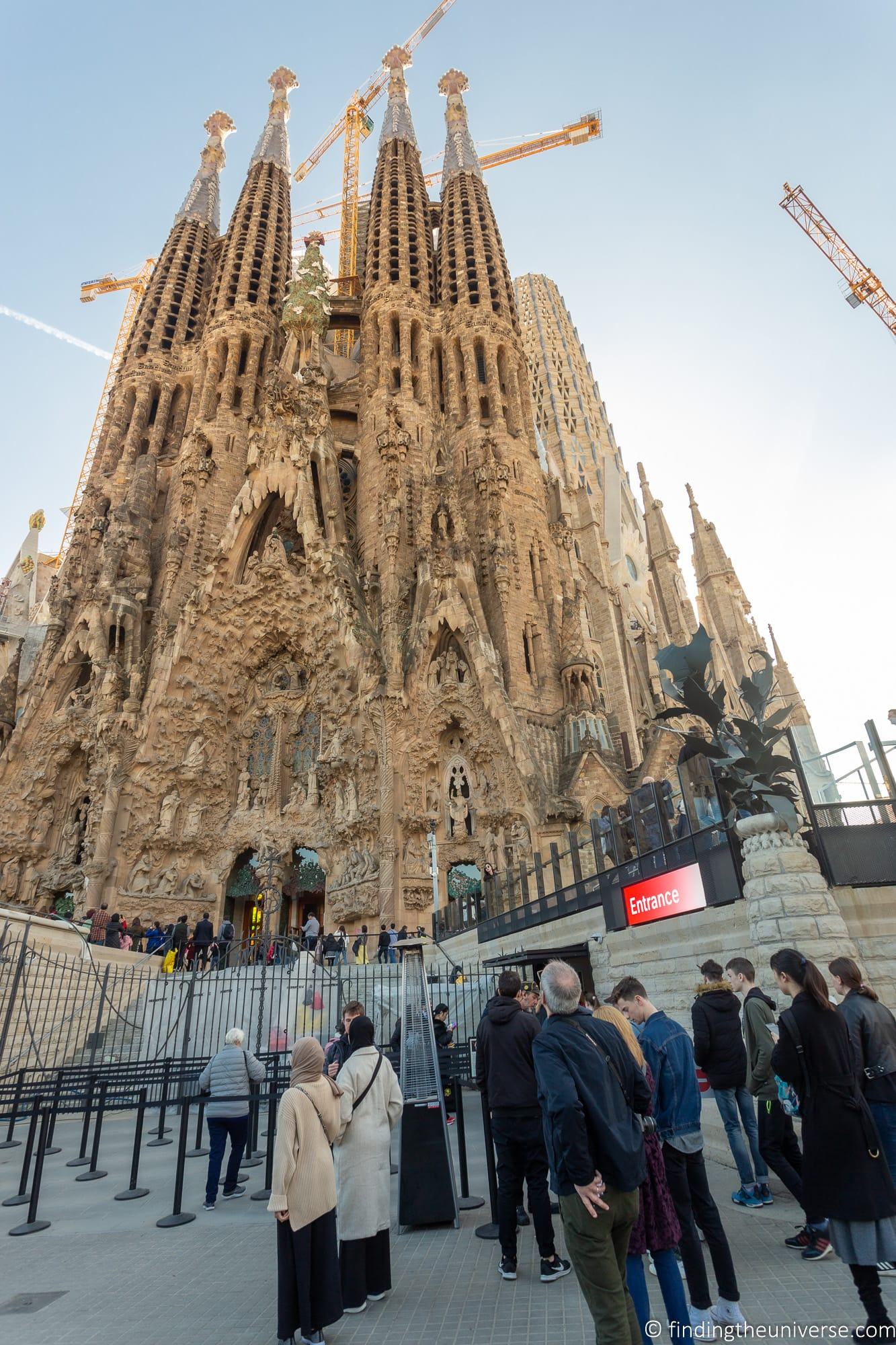
Can you Skip the Lines at the Sagrada Familia?
Yes and no. If you buy your ticket online or via a third party website, either for individual access or as part of a tour, then you can skip the ticket line.
Instead, you can go straight to the main entrance. The Sagrada Familia like many popular attractions operates airport style security with bag and body scanners. So you will need to queue a short while for this.
The line for these is never very long, as you can only join the line when your timeslot for entering opens. On site ticket officers check tickets before you enter the line, so you will only be in line with others who are entering at the same time as you.
In my experience, the security line moves quickly and efficiently, so you shouldn’t need to worry about losing much time here.
When you see tickets advertising skip the line access at the Sagrada Familia, they are referring to the ticket line. All ticket holders, including individual and group tickets, have to go through the same security line.
Is it worth visiting one of the Sagrada Familia towers?
There are currently two Sagrada Familia towers that you can visit, the Passion Tower and the Nativity Tower. Visiting a tower requires a special ticket, and these are some of the more expensive tickets available for a visit from the official website. Visits to the towers are self-guided.
The Virgin Mary tower was completed in late 2021, so this might also become available for visiting.
You definitely don’t need to visit a tower to enjoy your time at the Sagrada Familia, although it does reward you with both nice views of the city and a unique viewpoint on areas of the building that are otherwise impossible to view.
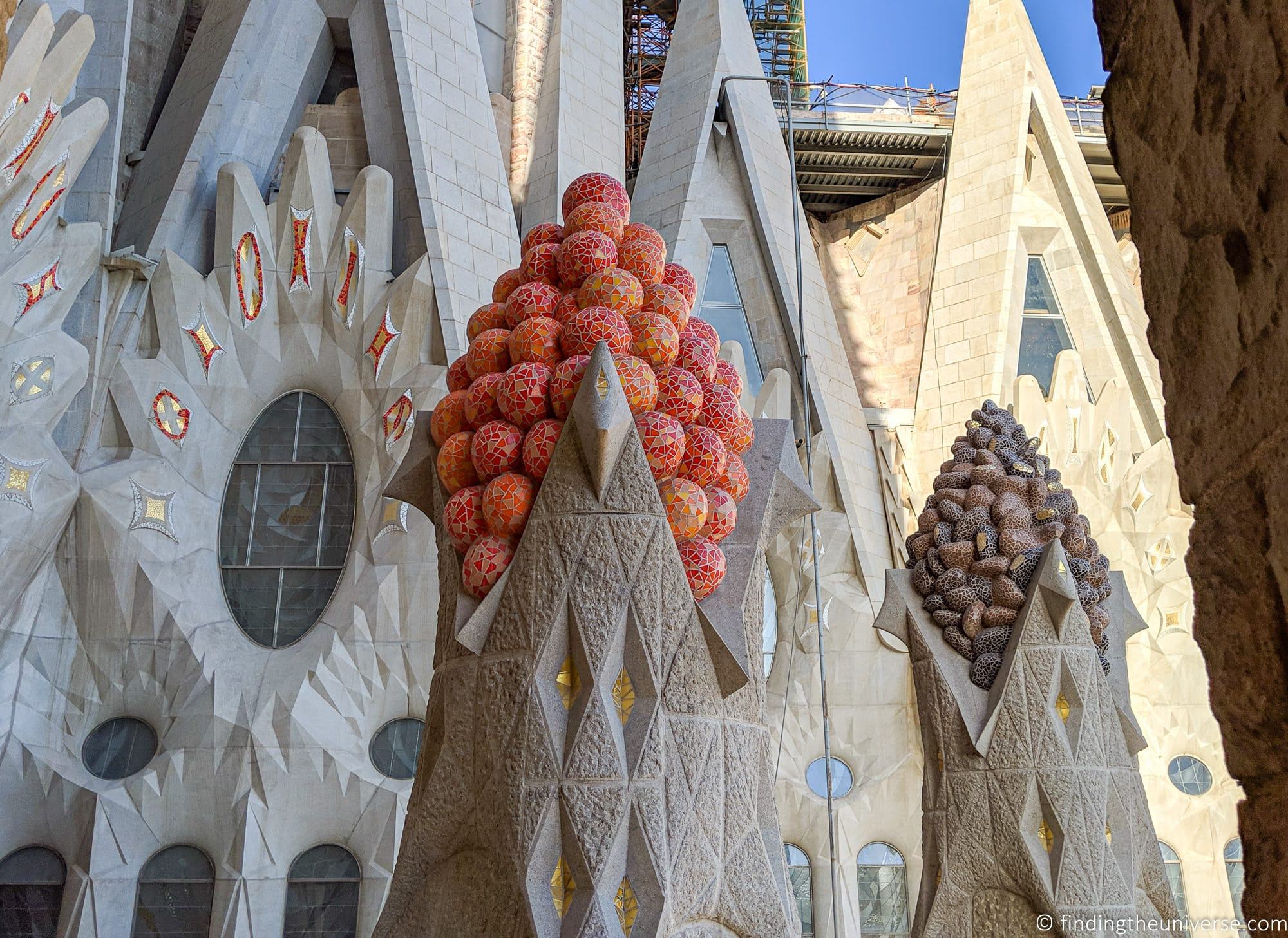
Of course, there are lots of other options for great views of the city – a favourite of ours being the view from Santa Maria del Pi in the Gothic Quarter. See more ideas in our guide to where to get a great view of Barcelona .
I think that seeing the inside and outside of the towers, as well as getting up close to the facades, is definitely a unique experience. If you climb the towers for this reason, it is definitely worth it. But some people don’t find visiting the towers worth the extra cost, and we would agree that it is definitely not required
Which Sagrada Familia Tower Should You Visit?
There are currently two Sagrada Familia towers you can visit – the Passion Tower and the Nativity Tower. If you decide to visit a tower, the next question you might have is which tower is the best to visit?
Honestly, the answer to this is not so simple, as both towers are worth visiting. In addition, you might find that when you come to book, only one of the two towers has availability, so your decision will be made for you! However, here’s a quick overview of the two towers you can currently climb to help you make a decision.
The Nativity Tower is the older of the two towers, and was completed during Gaudi’s lifetime. It’s on the Nativity Facade side of the building, which was also built during Gaudi’s lifetime. The Nativity Tower offers views across the east side of the city and the mountains, as well as up close viewing opportunities of the Nativity Facade.
The Passion Tower is one of the newer towers, and is on the Passion Facade side of the building. This Facade was only fully completed in 2018. Whilst this was designed by Gaudi, it still has a newer look and feel due to being more recent.
Views from this tower are across the city centre and out to sea. There is still quite a lot of construction work ongoing around this tower, and when I visited there was lots of evidence of this when looking out of the windows.
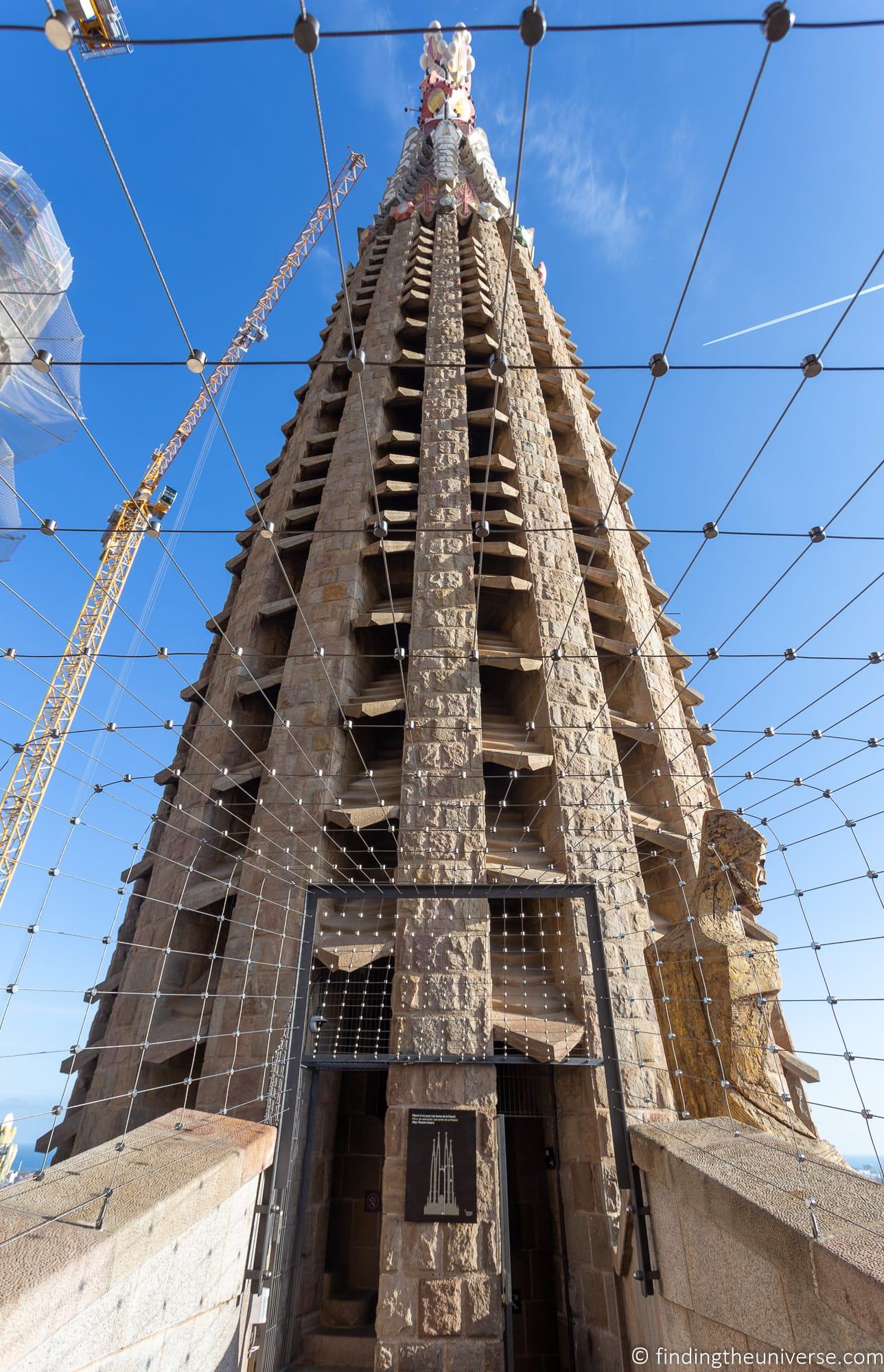
Both towers you can visit have a bridge which links the two main towers on each facade. Sometimes this bridge isn’t open, but when I visited the bridge in both the Nativity and Passion towers was open. This bridge is open air (but surrounded by safety wire) and offers a great view of the city and the outside of the towers.
Both towers have lift access to get up the towers, followed by a series of steps. They then both have steep spiral staircases, consisting of hundreds of steps, to get down. The exit stairs in the Nativity Tower are slightly wider, so are more popular with folks who suffer from claustrophobia.
There is no accessibility access to the towers, as even when you take the lift there are a number of stairs to climb. In addition, you can’t get the lift up and down, only up. As a result, anyone with physical mobility issues will likely want to skip the towers.
It is worth mentioning that there is no handrail in the centre of the staircase in either tower, and you can see straight down from the top to the bottom as there’s a small hole in the centre. This is too small to fall into, but vertigo sufferers might want to give this a miss as it can be a little disconcerting.
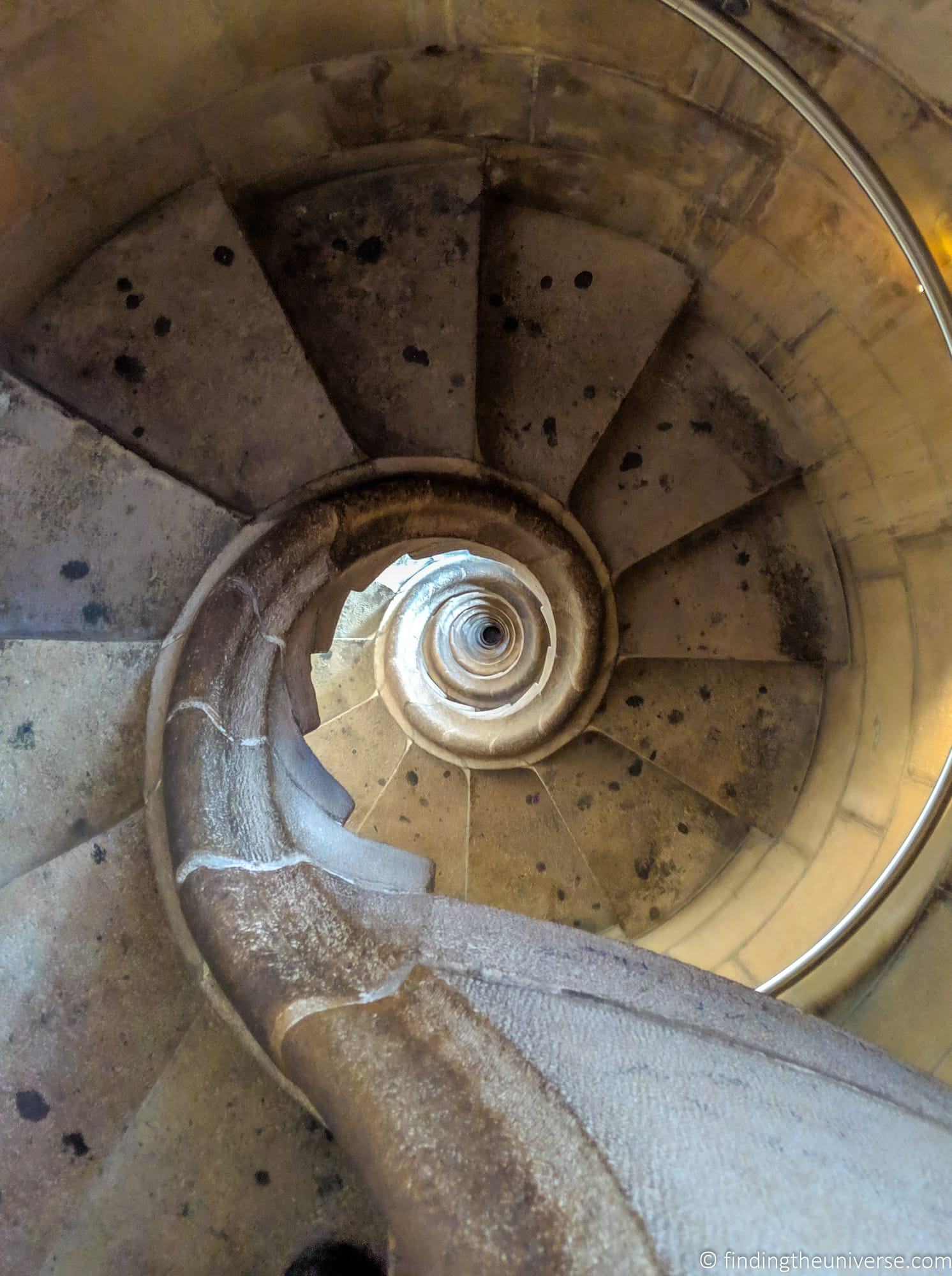
In our experience looking at the booking website and reading reviews from other visitors, the Nativity Tower tends to be more popular, and tickets for this tower tend to sell out first. However, we think if you want to visit a tower, then either tower will work.
If you want to visit a tower but tickets are sold out, again, there are third party tours which normally include tower access (although always check the description) such as this one with Take Walks .
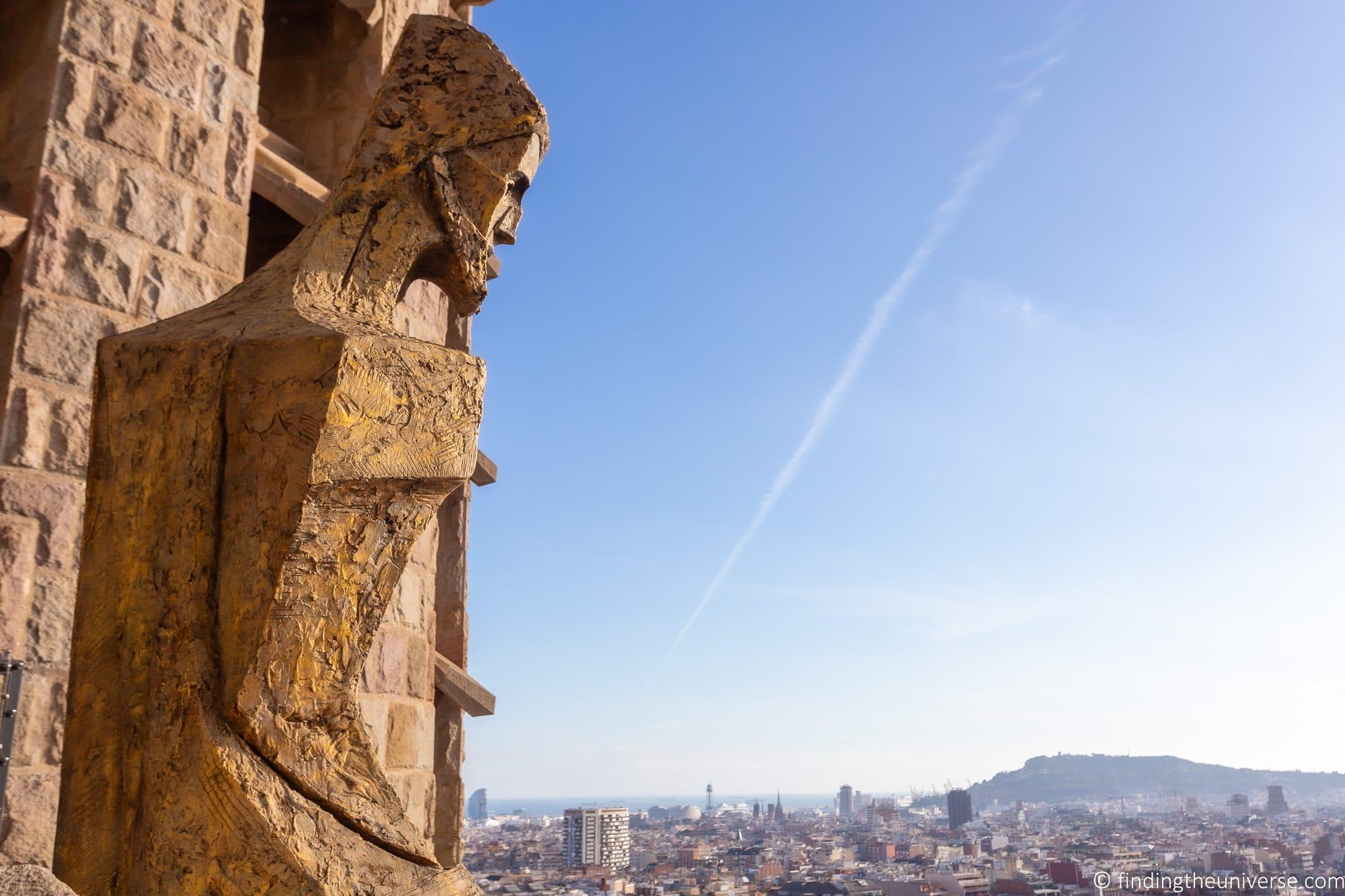
What is the Dress Code at the Sagrada Familia?
The Sagrada Familia is a place of religious worship, and as such, visitors are expected to wear appropriate attire. The following rules apply:
- Shoulders must be covered
- Shorts / skirts must come down to at least mid-thigh. We’d recommend knee length though to be on the safe side.
- Swimwear is not permitted
- Fancy dress or clothing to celebrate a festivity is not permitted. For example, a bachelor party all wearing similar outfits may be refused entry.
- See through clothing is not permitted
- Hats are not permitted with the exception of those required for religious or health related reasons
- Visitors must be wearing footwear, it is not permitted to enter barefoot.
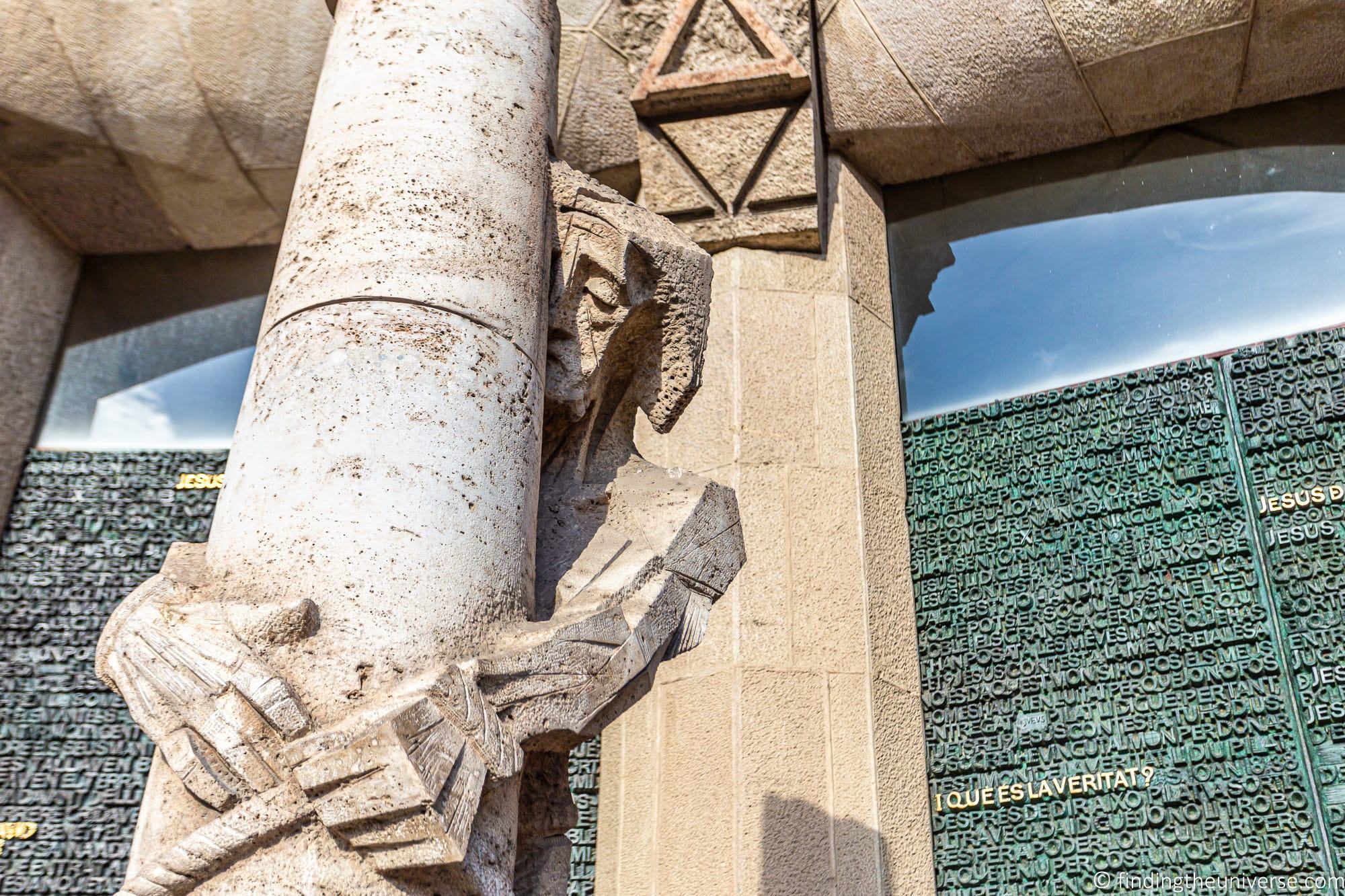
Other Forbidden Items at the Sagrada Familia
As well as the dress code, there are other items that are not permitted in the Sagrada Familia. A summary of these is as follows:
- Food and drinks are not permitted, and must be consumed and disposed of prior to entering.
- Professional photography equipment, including tripods, is not permitted
- Smoking is not permitted anywhere on the grounds
- Dangerous items such as weapons, sharp objects, knives or similar are not permitted. These will be held at security and returned after the visit.
- Any sort of banner, sign or, flag intended as a protest
- Any chemical product that could harm other people or damage the monument.
- Animals are not allowed on site with the exception of service dogs for people with disabilities
As you can see, nothing particularly out of the ordinary here.
Can you Take Photos in the Sagrada Familia?
Yes, you are allowed to take photos in the Sagrada Familia. However, there are a number of rules to be aware of.
First, photography is not permitted during masses or holy day events.
Second, p rofessional photography equipment, including tripods, is not permitted in the basilica.
If you wish to visit and take photos for commercial photography reasons, this needs to be authorised by the press department. In these instances, tripods may be authorised but you will want to get permission in writing before your visit.
As with most museums, churches, and other attractions, flash photography is also not permitted. Honestly, the church is so big that a flash probably won’t do much anyway! We have a guide to disabling the flash on a camera here if you need instructions for disabling the flash on your camera.
There is no specific guidance around videos, however the same rules likely apply regarding professional video equipment. If in doubt, contact the Press Department of the Sagrda Familia.
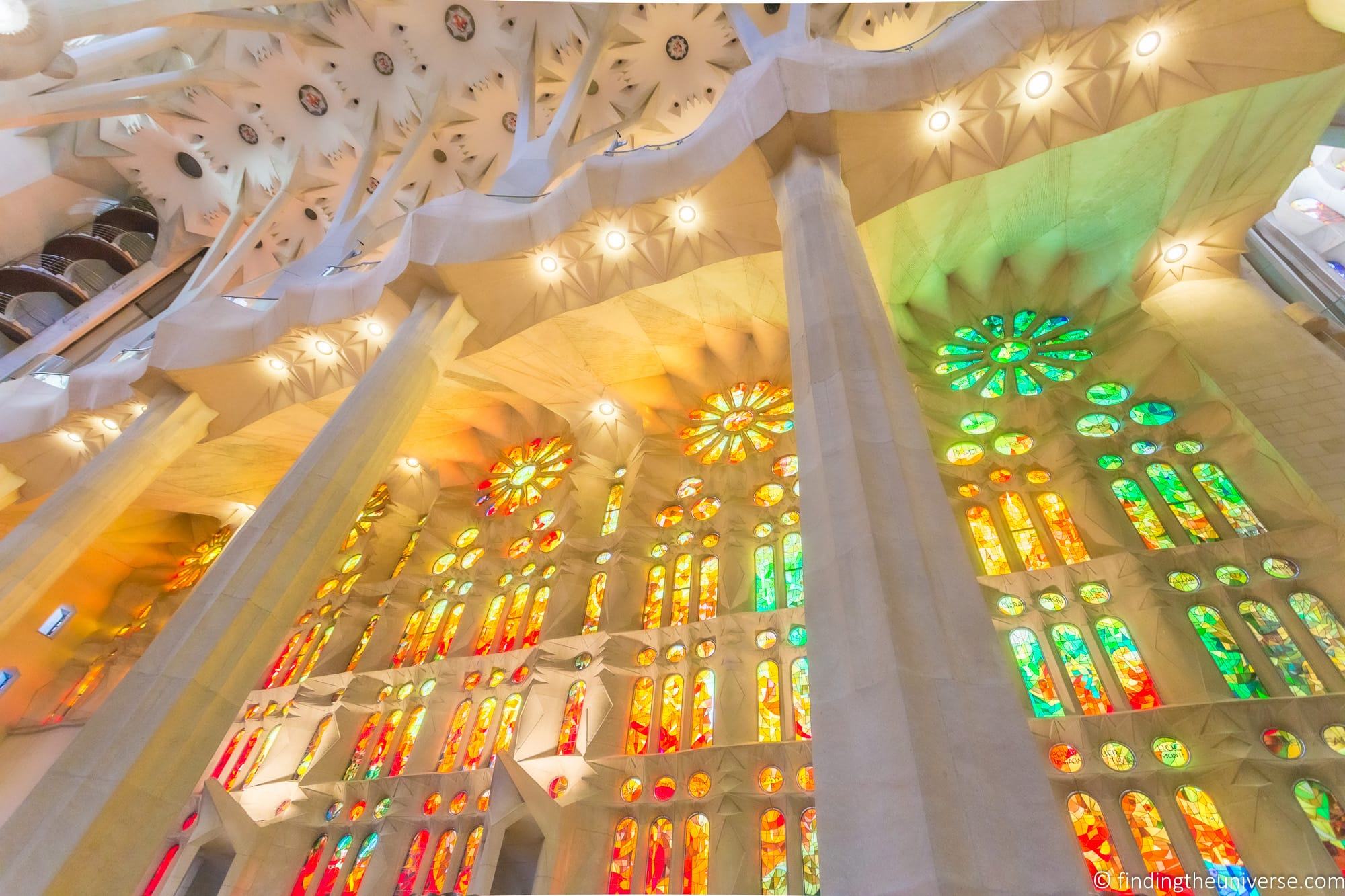
Are there Free Days at the Sagrada Familia?
There are no regular free days at the Sagrada Familia.
Barcelona Attraction Passes that Include the Sagrada Familia
If you plan on seeing a number of sights in Barcelona, and perhaps using the Hop on Hop off bus, then you might find that buying an attraction pass or some kind of combination ticket is more convenient than individual tickets.
Some of these attraction passes will also save you money, depending on which attractions and services you use.
If you decide to purchase an attraction pass, you will want to purchase these at least 48 to 72 hours before you would like to visit the Sagrada Familia. This is because you will need to confirm a time of visit and receive the tickets via email (or however each works). You can’t just book and turn up an hour later with these kinds of passes.
Barcelona has a number of attraction passes (see our guide to the Barcelona attraction passes here ), however not all of them include the Sagrada Familia. Here are some that do.
Go Barcelona Pass
The Go Barcelona Pass comes in two formats, an all-inclusive version and an explorer version . The all-inclusive version is generally our favourite pass for Barcelona as it includes so many attractions and activities.
Both versions include a guided tour of the Sagrada Familia, meaning you get skip the line access to the Sagrada Familia as well as a tour with an expert guide.
This is a great way to experience the Basilica as you’ll learn a lot about what you’re seeing. The pass also includes access to over 40 attractions across the city. In our opinion it’s one of the best value passes for Barcelona. You can see a full list of the included attractions here , and buy your pass here .
You also can see our full review of the Go Barcelona pass here to see if it is going to make sense for your visit.
Barcelona City Pass
The Barcelona City Pass . This pass includes the Sagrada Familia, Park Güell, and airport bus transfer, as well as either a 1 day or 2 day Hop on Hop off bus ticket. It also includes an audioguide covering the city, as well as a further 10% discount on a wide range of attractions in Barcelona.
What we like about this pass is that it lets you book the specific ticket type you want for the Sagrada Familia, from basic through to the towers visit, and it also lets you book the timeslot for your visit for both the Sagrada Familia and Park Güell.
If you are planning on visiting the Sagrada Familia and Park Guell, using the Hop on off Hop bus to get around the city, and plan on booking some extra attractions with a 10% discount, this is definitely an easy all in one option.
The Gaudi Bundle
The Sagrada Familia is far from the only Gaudi attraction in Barcelona. Another very popular one is Park Guell. If you want to visit both of these, then you might consider the Gaudi Bundle ticket .
This includes Sagrada Familia tickets with the official audioguide, tickets for Park Guell with an audio guide, as well as an audioguide for the exterior of the Sagrada Familia and other Barcelona attractions.
This ticket is slightly more expensive than purchasing individual tickets for each attraction, however the included audioguides might make this a good option if those interest you.
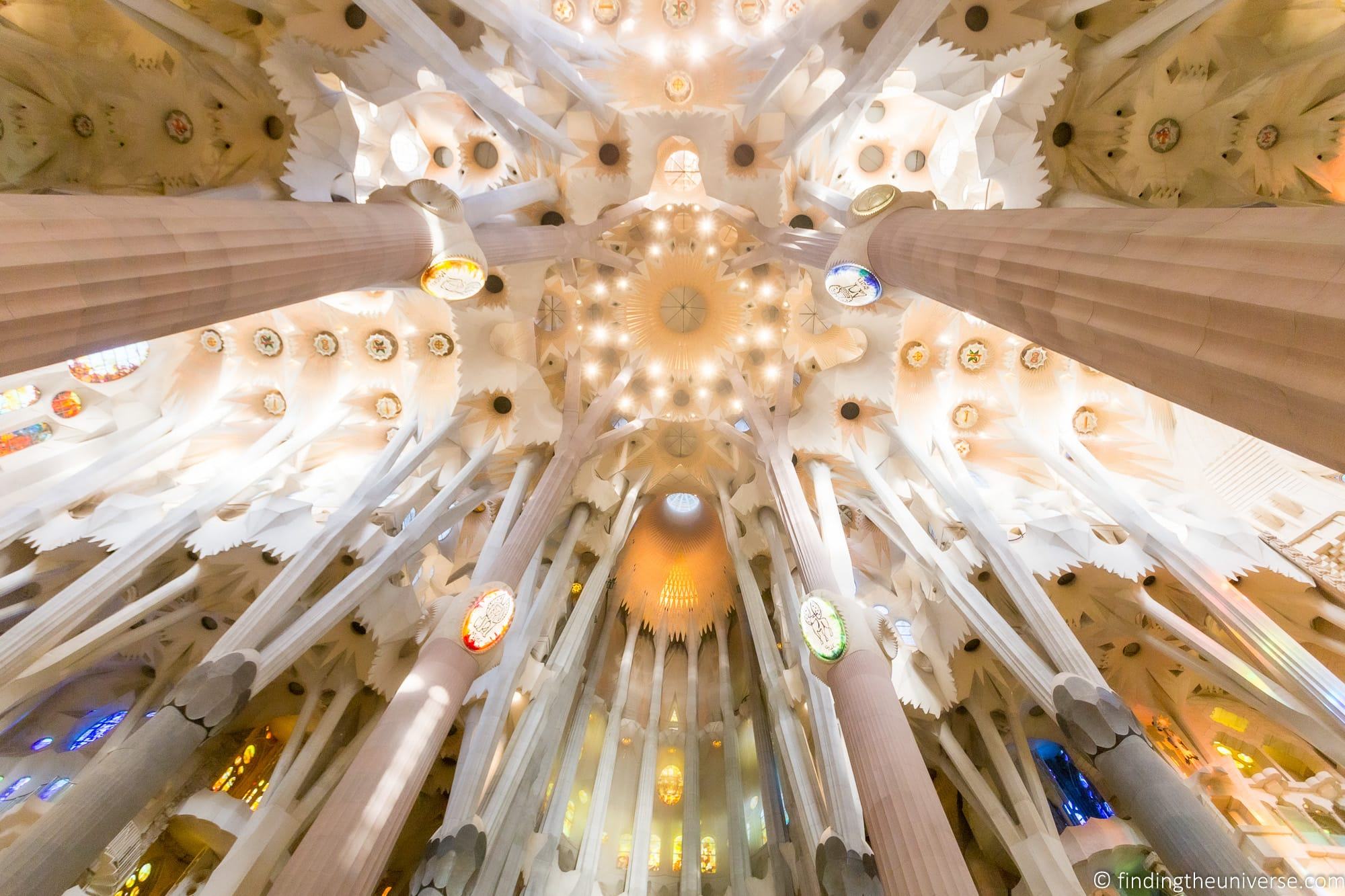
Where to Get a Good Photo of the Sagrada Familia
You’ll probably want to get a great photo of the Sagrada Familia to remember your visit! My favourite spot (and one of the most popular views in general) is from Plaça de Gaudí to the north east of the building.
This has a small pond in, which makes for some nice reflections. However, you will need quite a wide angle lens in order to get the whole church and its reflection in shot.
As the Sagrada Familia is an active construction site, you will obviously get photos of cranes, netting and workers – which you can see in my photos!
Being the tallest building in Barcelona, you can also see the Sagrada Familia from a number of other locations in the city, including from the roof tops of some of Gaudi’s other buildings. The closest is La Pedrera, however, you will need quite a long lens to get a good shot as the Sagrada Familia will be around a mile away.
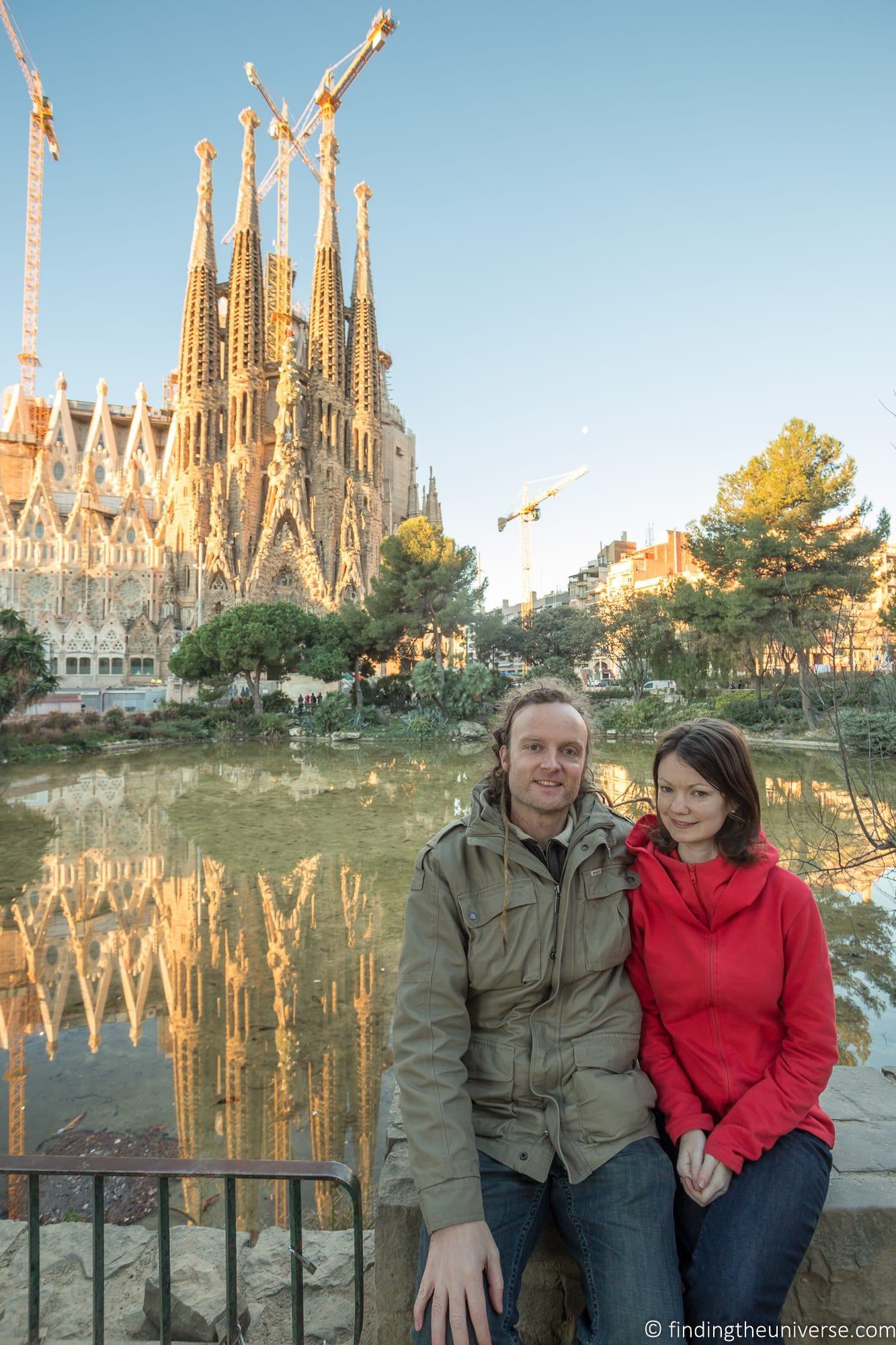
Practicalities for Visiting the Sagrada Familia
Facilities at the sagrada familia.
The Sagrada Familia has toilets on site.
Food and drink is not permitted on site, and as such there is nowhere to buy food or drink on site either. There are however lots of stalls serving snacks and drinks just outside the entrance and exit points. There are also a number of cafes and restaurants within walking distance of the basilica.
Security at the Sagrada Familia
The Sagrada Familia operates airport style security. Expect your bags and person to be scanned, and forbidden items to be either conficated or held onto until your visit is over.
Accessibility at the Sagrada Familia
All parts of the Sagrada Familia which are open to the public currently are fully accessible except for the two towers. Whilst these have a lift, this does not go all the way up, and there are additional stairs that must be climbed. As such, the towers are currently not accessible.
Adapted audioguides in sign language and audiodescription are also available in Catalan, Spanish and English. There are also accessible toilets on site.
The accessible entrance to the Sagrada Familia is near the gift shop on the Nativity Side.
Luggage Storage Near the Sagrada FAmilia
There is no luggage storage available at the Sagrada Familia. The only exception to this rule is for visitors to the towers, who can put small backpack sized bags in lockers by the tower lifts during their visit to the towers. Following the tower visit, the luggage must be immediately collected.
Currently, the rules for visiting the Sagrada Familia do not explicitly forbid bringing luggage inside. However, you should be aware that there is airport style security screening, so any bags you bring will be screened. We don’t recommend bringing any luggage or large bags with you to the basilica.
Instead, consider storing your luggage either at your hotel or finding luggage storage near the Sagrada Familia.
Things to do Near the Sagrada Familia
The Sagrada Familia may be the most popular attraction in Barcelona, but there’s plenty more to do in the city! Some of these options are relatively close to the Sagrada Familia, and make for a good next step.
- Recinte Modernista de Sant Pau – about a 10 minute walk north east of the Sagrada Familia, this collection of building was originally a hospital. Today it is one of the finest examples of Art Nouveau architecture in Europe
- Casa Milà – also known as La Pedrera, this is another of Gaudi’s works, famous for its rooftop chimneys. It is about a 20 minute walk from the Sagrada Familia
- Gaudí Experiència – an interactive exhibition next to Park Güell that will take you through the life and works of the architect responsible for so many of Barcelona’s sights. About a 30 minute walk from the Sagrada Familia, or a short ride by Hop on Hop off bus / public transport.
- Park Güell – another of Gaudí’s works. This is a large park area with a number of installations to explore and visit. This is also where you’ll find the Gaudi House Museum where Gaudi lived, which is well worth a visit. If you do decide to visit, don’t forget you can save a few euros by buying a combination ticket with the Sagrada Familia on the official site
For more ideas on what to do when visiting Barcelona, see our guide to spending 1 day in Barcelona , as well as 3 days in Barcelona .
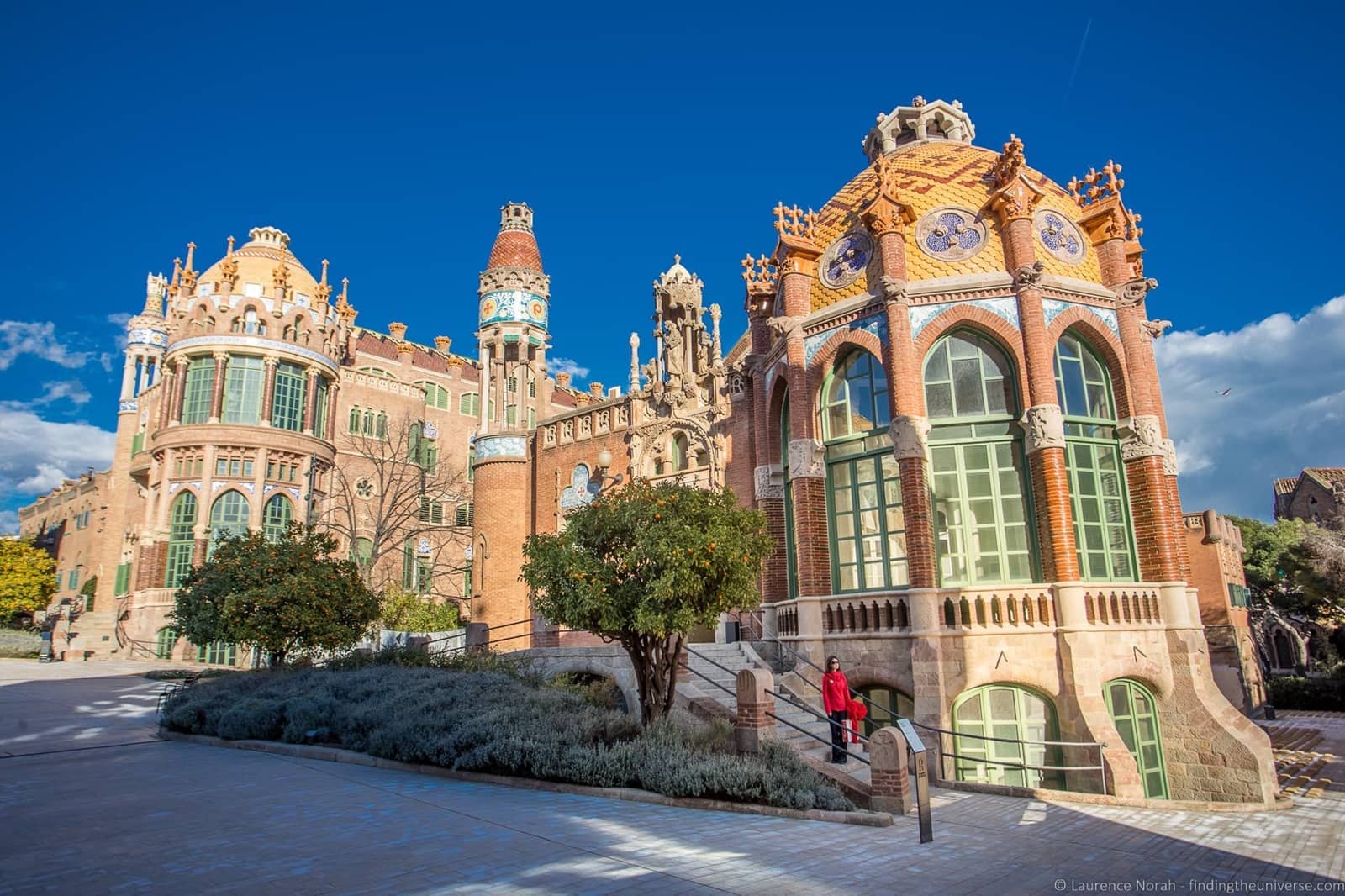
Where to Stay Near the Sagrada Familia
If you would like to stay near the Sagrada Familia during your time in Barcelona, we have put together this list of hotels, guesthouses and hostels which are all within a five minute walk of the Sagrada Familia.
These properties are across a range of budgets, and are ordered approximately by price, from lower to higher. Pricing can of course changing depending on season and demand, so do always check prices for your dates.
- Barcelona & You Hostel Sagrada Familia – three minutes walk from the Sagrada Familia, this is a well reviewed hostel offering dormitory style accommodation. It’s a great value option and breakfast, coffee/tea and WiFi is included.
- Hostemplo Sagrada Familia – just 200 yards from the Sagrada Familia, this is a highly rated design guesthouse offering private en-suite rooms at a great price
- Ibis Barcelona Centro (Sagrada Familia) – just a few minutes walk from the Sagrada Familia, this 2* hotel offers comfortable en-suite air conditioned rooms with soundproofing
- Boutique Hostemplo Sagrada Familia – found on a pedestrian street just 100 yards from the Sagrada Familia, this 3* boutique hotel offers air-conditioned en-suite rooms
- Hotel Sagrada Familia – a 3* hotel a couple of blocks from the Sagrada Familia, offering private en-suite rooms with air conditioning.
- SM Hotel Sant Antoni – five minutes walk from the Sagrada Familia, this is a well rated 3* hotel with private en-suite rooms and air conditioning
- Hotel Barcelona 1882 – 450 yards from the Sagrada Familia, this is a very well reviewed 4* hotel with a pool, and air-conditioned en-suite rooms
- Ayre Hotel Rosellón – 200 yards from the Sagrada Familia, this 4* design hotel has a roof top terrace offering stunning views of the Sagrada Familia. It also has great reviews, an en-suite air conditioned rooms
Hopefully one of the above hotels will work for you when looking for somewhere to stay near the Sagrada Familia.
Apartment rentals through sites like AirBnB are also available. One thing to be aware of is that in Barcelona these need to be registered with the city. When they are registered they will be issued a license number. If you want to stay in an apartment rental in Barcelona, then we recommend picking one which has the license number on the listing.
If you would prefer to stay in an in apartment in Barcelona, then we recommend either Plum Guide or AirBnB .
Plum Guide carefully curate their listings so their options tend to be of a very high quality whilst still being available at a range of price points. See their listings for Barcelona here .
We’ve also used AirBnB all around the world, and they consistently have the most options to choose from. See their listings for Barcelona here .
If you can’t find what you want from the above choices, or you want some new options to try out, we wrote a whole post on the best alternatives to AirBnB which you should check out!
Further Reading for Visiting Barcelona
Hopefully this guide to visiting the Sagrada Familia has answered all your questions and given you plenty of ideas for your own trip.
As well as the Sagrada Familia, we’ve also explored Barcelona many times, as well as other parts of Spain’s Catalonia region. From our experiences, we have put together a number of posts to help you plan your own trip. Here are some we think you will find useful in planning your own trip.
- For Barcelona, check out our 3 day Barcelona itinerary , our 2 day Barcelona itinerary , our guide to spending a day in Barcelona , our review of the Barcelona Pass , and our detailed guide to Gaudí sites in Barcelona to start you off.
- There are lots of great day trips from Barcelona. See our guides to visiting Besalu , Montserrat , and Girona as good starting points.
- Lovers of surrealist artist Salvador Dali will want to visit some of the many sites associated with the artist in the region. See our guide to Dali attractions in Costa Brava that lists all the attractions to help you put together your trip.
- A fantastic experience we can recommend to anyone visiting this region is to take a hot air balloon ride. We’ve done this twice, and you can see our guide to hot air ballooning in Costa Brava here.
- We have a guide to things to do in Palamós , one of our favourite fishing towns in the Costa Brava
- If you love mountains, you’re going to want to spend some time in the Spanish Pyrenees region of Catalonia. See our guide to the Spanish Pyrenees to start you off. If visiting in the winter, you might consider heading to one of the Girona region’s ski resorts, and you can take a look at our guide to skiing in the Spanish Pyrenees .
- We also have detailed guides to all the specific regions of the Girona Pyrenees of Catalonia, including La Garrotxa , El Ripollès and La Cerdanya .
- Another mountainous experience for lovers of nature or skiiers is the Vall de Nuria, which also makes a good day trip or overnight experience from Barcelona. See our guide to visiting the Vall de Nuria for more information
- If you would like a book about the Sagrada Familia, this is a detailed guide to the history, present and future of this building
- If you’re looking for a guidebook, take a look at this Costa Brava pocket guide and this DK Eyewitness guide to Barcelona and Catalonia
And that’s it for our detailed guide to visiting the Sagrada Familia in Barcelona, Spain! As always, we’re happy to answer your questions – just pop them in the comments below and we’ll get back to you as soon as we can.
In addition, if you visit the Sagrada Familia and notice anything incorrect about this guide, do let us know in the comments section so we can correct it.
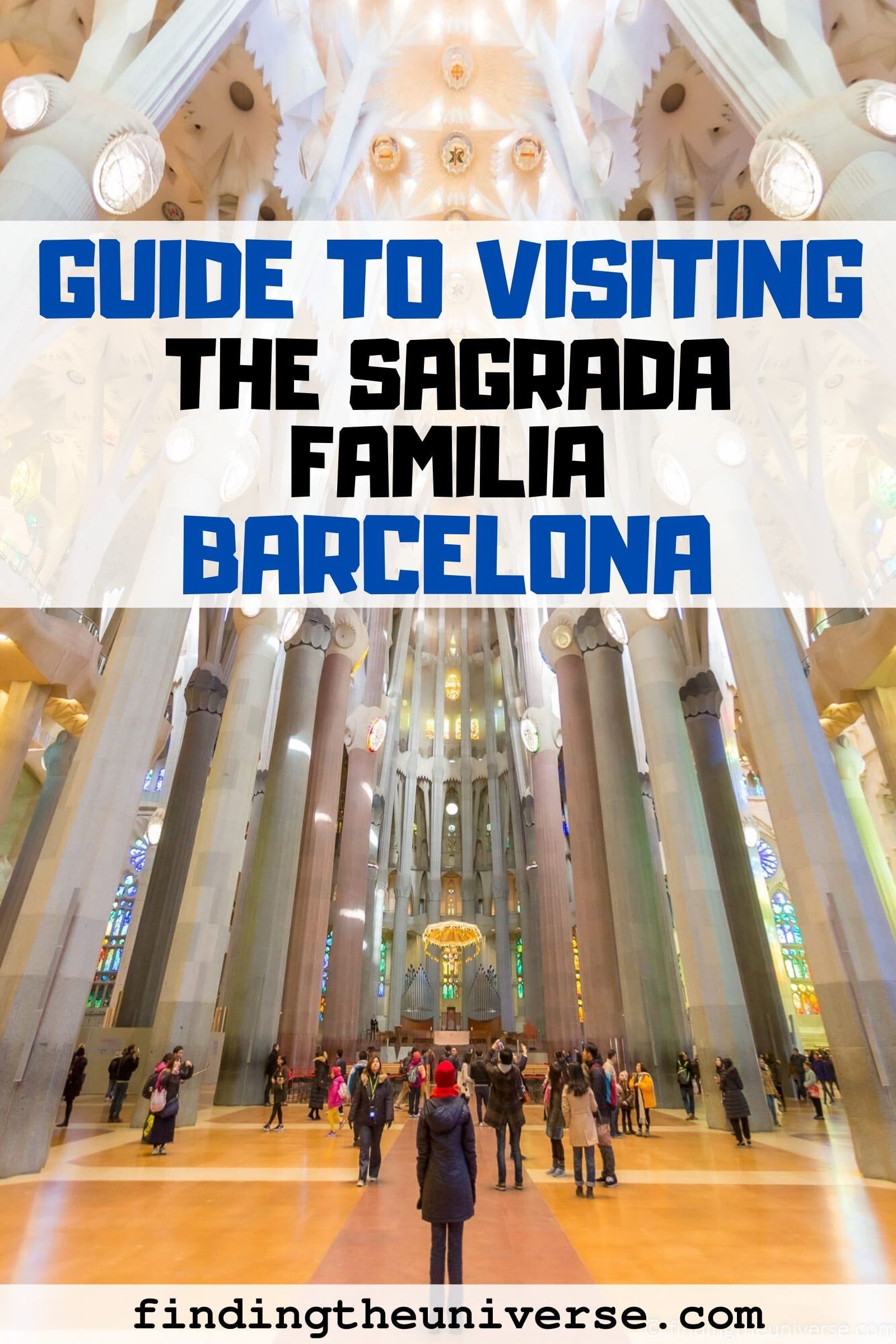
Enjoyed this post? Why not share it!
There are 9 comments on this post
Please scroll to the end to leave a comment
22nd August 2023 at 10:29 pm
Hello, do you know how the timed entries work for purchasing tickets to enter the church as well as go up in one of the towers? When I go to the official website, the first option is to choose a date, then a timed entry for the tower of your choice. The second option is to choose a time for the church. I like to do the earliest times possible to get tours done before they get too busy. If I select the 9am time for the tower, the first choice that comes up for the church is 9:15am. I’m not sure if I am supposed to estimate how long it takes to do the tower visit and then select a later time to do the church tour? Obviously the tower can’t be completed in 15 minutes, so I’m unsure how to select an appropriate time for each part of the ticket. Any advice would be appreciated! Thanks so much
Laurence Norah says
23rd August 2023 at 10:27 am
So just to clarify you are booking the ticket which includes a guided tour of the church and which includes the tower? Or are you just booking for tower and church entry? Because it works slightly differently. With the guided tour you normally do the guided tour first and then the tower afterwards I think, but without the tour component you can visit the church around your tower visit. Once you are inside you go to the tower, and then you can further explore the church when you come back down.
Let me know if this helps or if you need further clarification, and I’ll do my best to help out!
23rd August 2023 at 4:31 pm
Thank you. We are planning to do the self-guided tour with the audioguide (church and tower). When I choose this option, and select the earliest possible time for the tower (9:15am), the only option I can select for the church afterwards is 9:00am. So I am assuming that the church entry is first, then as you said, we would go up the tower first at 9:15, then back down to do the self guided tour of the church. Does that sound right?
Thank you for your help!
23rd August 2023 at 4:37 pm
Yep, that is what would happen! The tower entry is inside the church, so you would go into the church first and head towards the tower entry. After the tower visit, you can explore the rest of the church at your leisure.
Have an awesome time, do let me know how you enjoy it 🙂
Garry Matheson says
4th June 2022 at 4:37 am
Hi, Thanks for the very helpful and detailed guide. I’m not a professional photographer by any means but love travelling with my full-frame camera. Just wanted to clarify about ‘forbidden’ items…what constitutes ‘Professional photography equipment’? I’ll be travelling with a Sony A73 which is bigger than a pocket camera. The lenses are zooms, so quite bulky in comparison. Will they allow entry? Also more generally, is it common for cathedrals, museums and places of interest in Europe where ‘professional’ cameras aren’t allowed?
4th June 2022 at 12:05 pm
This is a good question. I have visited many times with my full frame cameras, sometimes two at the same time, and I’ve not had an issue. I believe they are primarily trying to stop people from doing photo shoots, so things like wedding shoots or influencer style shots with models is what they are against. A tourist with a nice camera isn’t really an issue. They also don’t like tripods or lighting setups.
In general, “professional” cameras are fine across Europe. Some locations won’t allow photography at all, although this is changing as most locations realise the benefit of free publicity on social media from visitors. Westminster Abbey for example had a long policy against photography, which changed only last year. In some places they might charge a nominal fee to allow you to take photos, I believe in Edinburgh for example it’s a couple of quid for a photography permit. Flash and tripod photography though is almost universally banned.
Hopefully this helps!
Have a great time in Europe!
Katie D'Agostino says
25th February 2022 at 2:01 pm
This article is SUPER helpful! Thank you. I cannot seem to find how you purchase tower tickets on the Sagrada Familia website. I only have that option through a tour I was looking to book. Are tower tickets normally available on the Sagrada Familia website or am I just missing it? Also, we are staying at the Ayre Rosello for those great views you speak of. Any great places to eat in that area? We’ve included breakfast in our SF View Room, but we’d love lunch and dinner suggestions. Thank you!
25th February 2022 at 5:40 pm
Thanks for your comment 🙂 So the Sagrada Familia has been a challenging attraction to keep on top of in terms of what is and what isn’t open and to who for the last couple of years! You are correct that right now the towers aren’t on the official website, and yes, they normally are as that’s how I booked them last time we visited. I have reached out to a partner who sells tour tickets to find out if it’s just tour partners who have access at the moment to the towers. I know that for a time they were only allowing guided tours of the towers as it let them control numbers, but I want to confirm if that’s still the case and when I hear back I’ll comment again. I’m not sure if they are actually open at all. If you have found a tour that includes them, definitely reach out to confirm that is the case if climbing them is important to you.
Food wise, I haven’t eaten a lot in that area and to be honest we don’t normally recommend restaurants as it’s hard to keep up with changes. The only place I am comfortable to recommend in general in Barcelona is L’Alcoba Blava, which is an amazing Tapas place in the Gothic Quarter and well worth visiting if you are in that area. It doesn’t look like much from the outside (we always walk right past in when looking for it), but the food speaks for itself.
I’ll get back as soon as I hear about the towers!
1st March 2022 at 8:12 am
I’ve been told that the tower tickets are due to be back online in March, but I’m not sure exactly when.
Leave a Reply Cancel reply
Your email address will not be published. Required fields are marked *
Let me know when there's a reply to my comment (just replies to your comment, no other e-mails, we promise!)
Subscribe to our monthly Newsletter where we share our latest travel news and tips. This also makes you eligible to enter our monthly giveaways!
We only ask for your e-mail so we can verify you are human and if requested notify you of a reply. To do this, we store your data as outlined in our privacy policy . Your e-mail will not be published or used for any other reason other than those outlined above.

Everything you need to know about the ethereal La Sagrada Família & amazing trips that will take you there
La Sagrada Família, Antoni Gaudí’s architectural marvel, is one of the most famous stops on any Barcelona itinerary. Impressive on the outside and transformative on the inside, the basilica is first on our list of things to add to your Spain bucket list . Here’s everything you need to know before you visit this cultural landmark and masterpiece of design on one of our Spain tours .

Explore our tours

4.7 out of 5 stars

4.6 out of 5 stars
More travel inspiration

Sagrada Familia Tours
Exceptional Tours
Carefully selected tours and experiences from passionate tour operators.
Skip the line
All tours include priority access and entry tickets.
Easy Booking
Easily find and book the best tours. Instant confirmation and mobile vouchers
The Basilica of the Holy Family otherwise known as the Sagrada Familia is undoubtedly the most famous church in Barcelona, in the whole of the Iberian Peninsula. Every year the unfinished masterpiece of Antoni Gaudi climbs higher in the sky and the world awaits its grand unveiling. Entirely funded by donations, the church has been beset by many setbacks, not least the death of the genius Antoni Gaudi who conceived it leaving few schematic drawings. The Spanish Civil War halted progress with the destruction of Gaudi’s handmade models and most recently construction was halted by the COVID pandemic. Over the years, architects working on the project have struggled to realise Gaudi’s designs, as no real plans were left to copy. But thanks to the latest technology, changes in construction methods over the years and the dedication of generations of tradesmen work continues to complete the basilica. Despite the unfinished state of the basilica, it was awarded UNESCO world heritage status in 2005 and was consecrated by Pope Benedict XVI in 2010. The planned completion date was to be in 2026 to coincide with the centenary of Gaudi’s death, although that now looks unlikely.
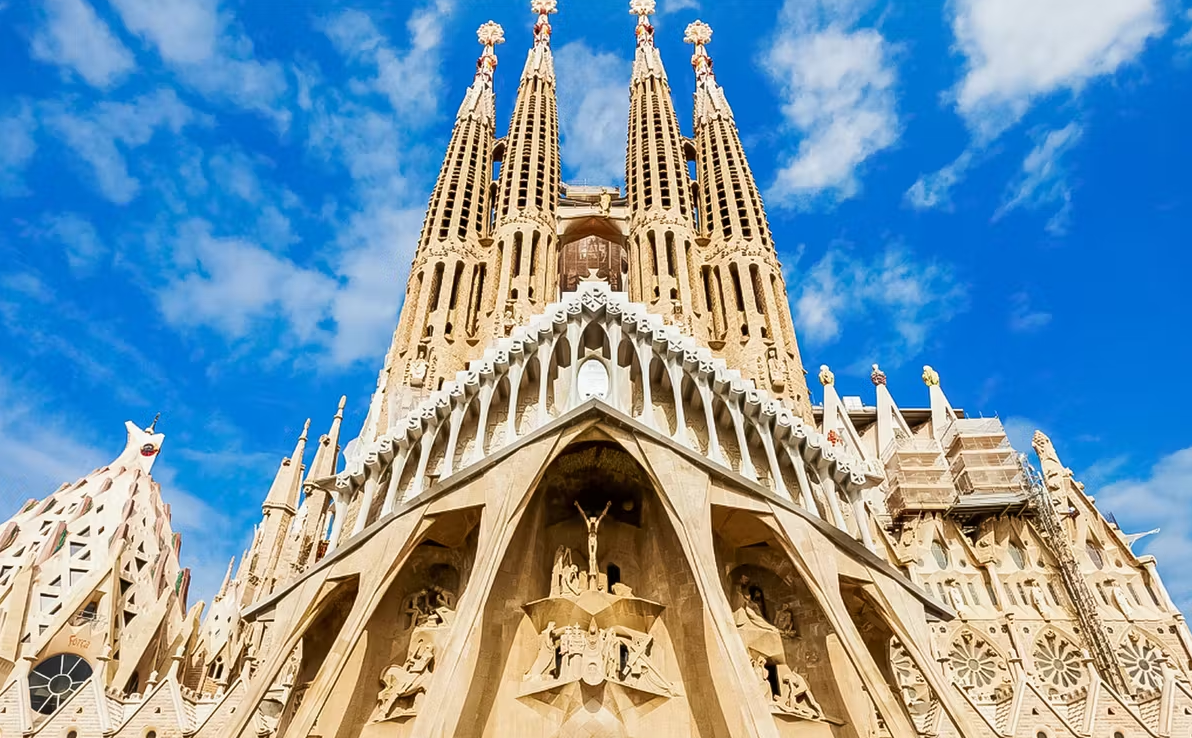
Priority access

2995 Reviews
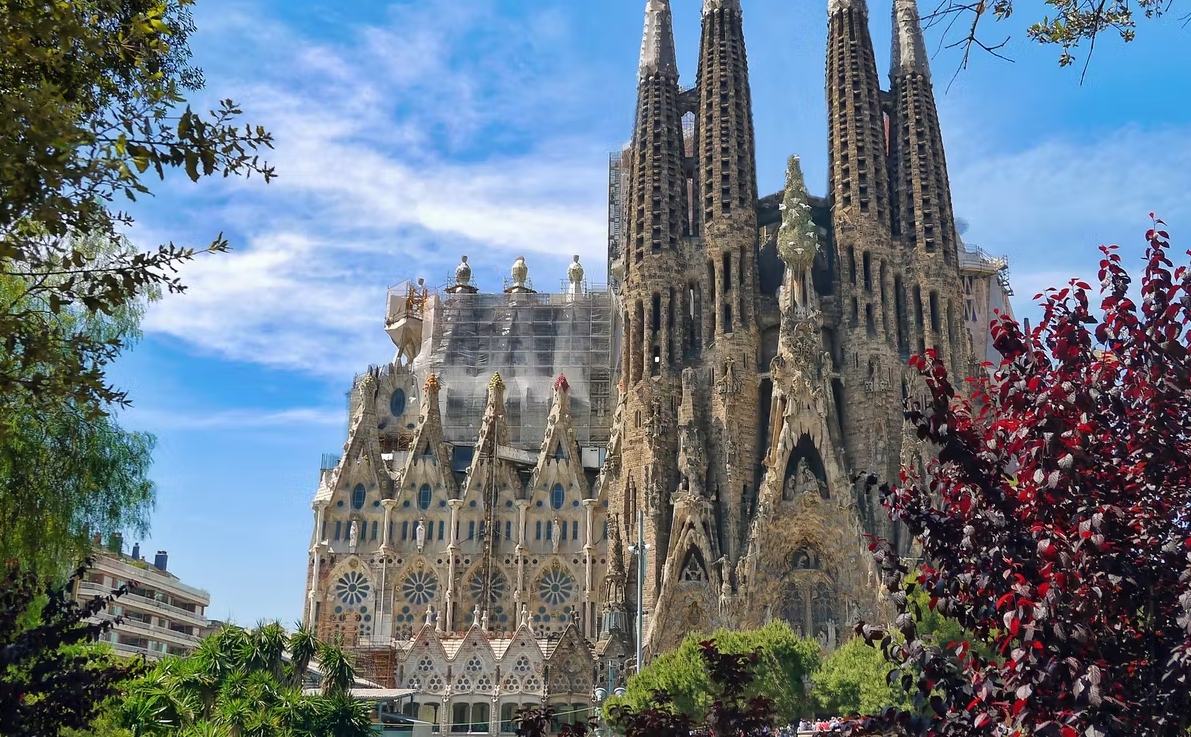
Fast track guided tour
5712 Reviews

with tower access
2356 Reviews
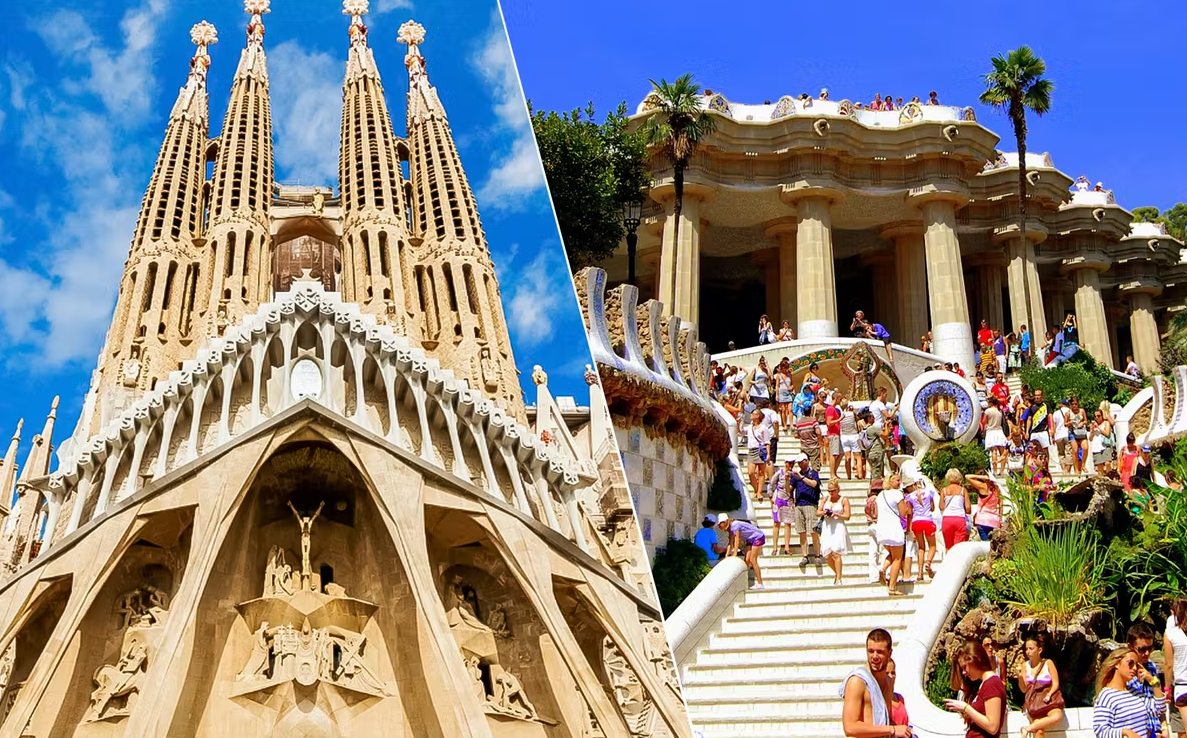
Sagrada & Guell

25929 Reviews

Tour sagrada & guell
3162 Reviews
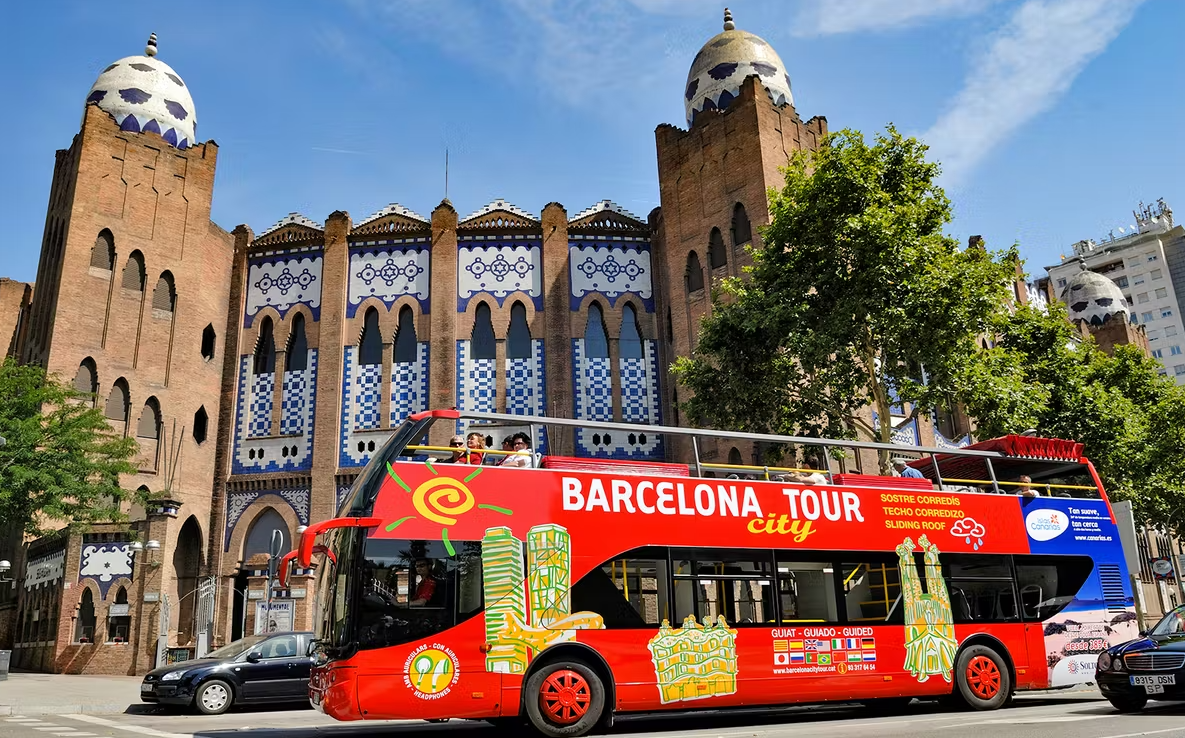
Skip the line tour
1904 Reviews
Popular Tours in Barcelona
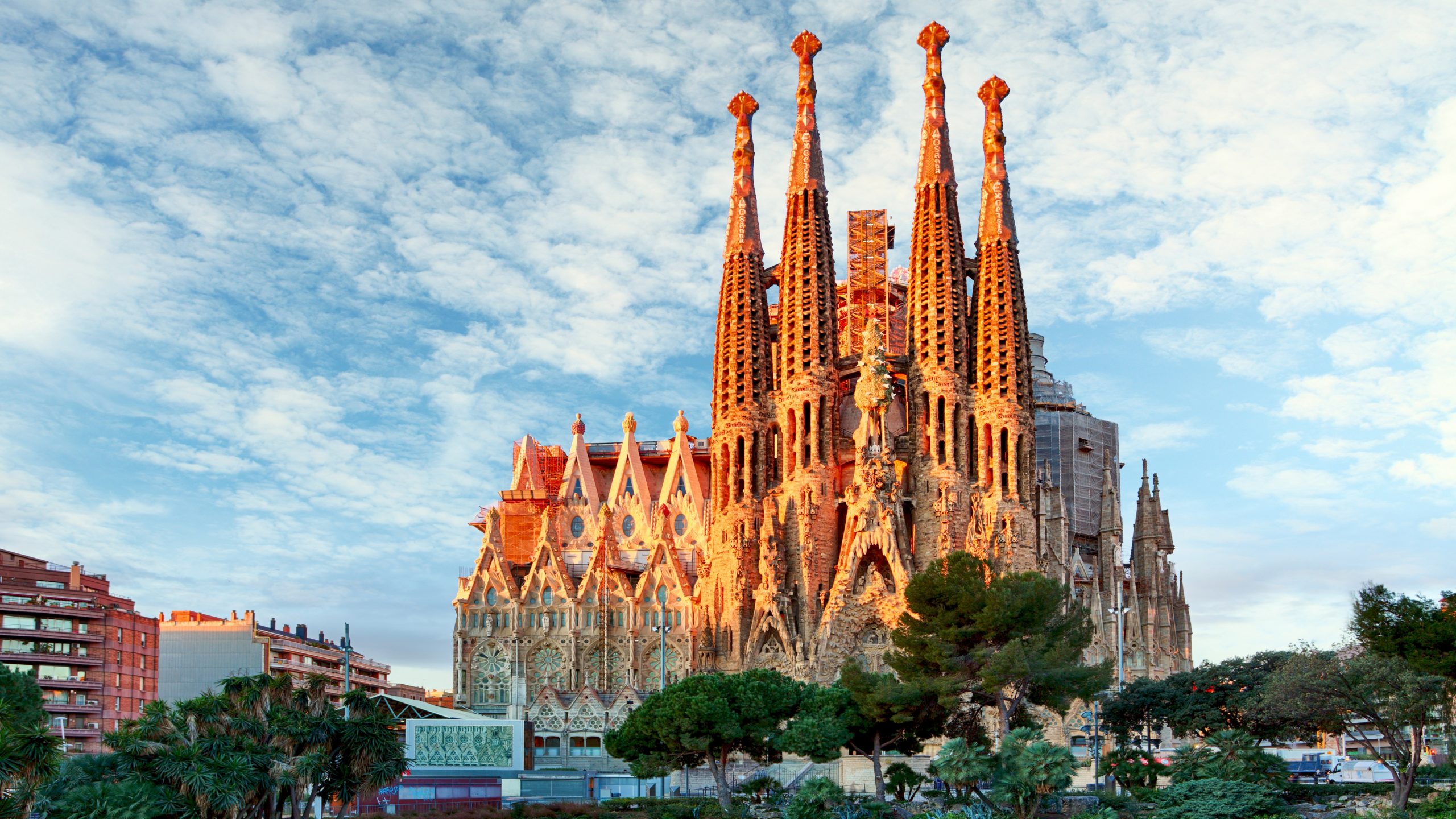
Sagrada Familia and Park Güell Tour

2157 Reviews
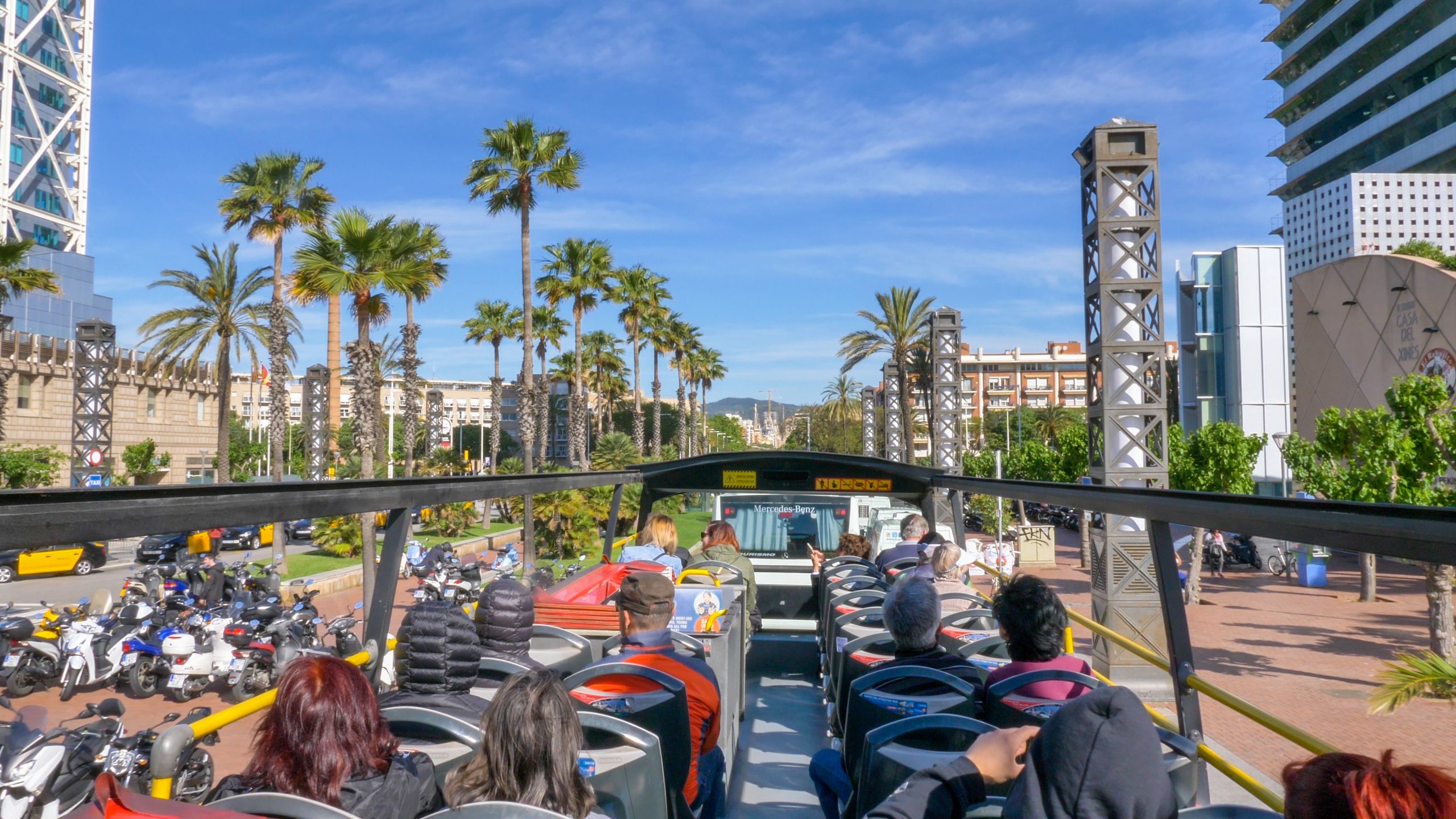
Hop-on Hop-off Bus Tour 1/2 day

2363 Reviews
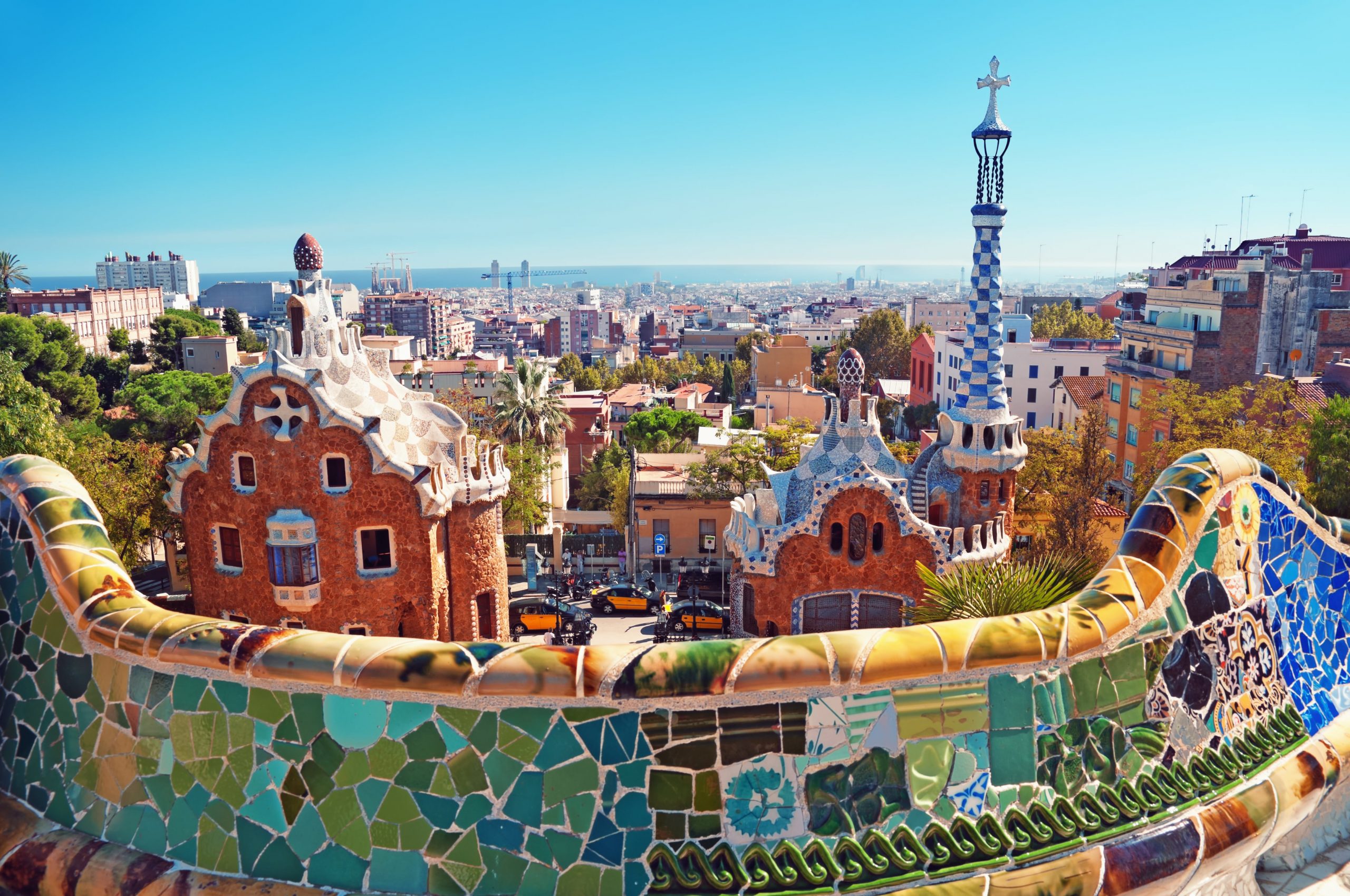
Park Güell Skip-the-Line Ticket and Guided Tour
1352 Reviews
Free Cancellation
Up to 24 hours before tour begins
Best Price Guaranteed
Disciunts Up to 60%
24/7 Support
Sagrada familia tour information - 2024.
La Sagrada Família – An icon of Barcelona’s skyline and one of the most notable masterpieces by Antonio Gaudí.
The Basílica de la Sagrada Família! Yes! The famous Sagrada Familia is a huge, unfinished basilica in Barcelona’s Eixample region. The structure was designed by the Spanish architect Antoni Gaudi, whose work is now a UNESCO World Heritage Site.
La Sagrada Familia is without a doubt Barcelona’s most famous structure. It is a prominent attraction in Barcelona and one of the most spectacular monuments ever built. There is no other building in the world with such a brilliant combination of Gothic and Art Nouveau styles. Also Visit Gaudi other masterpieces like Park Guell
Types of Sagrada Tours
There is a couple of options for a city tour of Sagrada. A few of the Sagrada tours should be taken into consideration. They are:
1. Sagrada Familia Guided Tour
On this guided tour of the basilica de la Sagrada Familia, you will experience an architectural paragon still in the making. Experience the jewel of Barcelona with our skip-the-line tickets. An expert guide walks you through Antoni Gaudí’s Sagrada Familia while keeping you entertained and engaged with the history of the basilica and anecdotes about the architect’s life.
Enter the basilica and marvel at the interior’s awe-inspiring pillar forest. Take in the vibrant light from the stained-glass windows and you’ll understand why Gaudí claimed: “the sun is the best painter.”
A colorful collision of Gothic and Art Nouveau designs awaits you. With the help of your guide, focus on the symbolic details and modernist renderings of the Holy Family. Hear how the present construction project is coming along after more than a century of hard work.
Learn more about Gaudí’s life via his work and the impact he left behind as you stroll around the basilica. Enjoy the freedom to continue exploring with your newfound knowledge at the end of the tour. Highlights
- Head straight inside with an expert guide to learn about the history of this UNESCO World Heritage-listed cathedral with your skip-the-line priority access tickets.
- Admire the beautiful ceilings and stained-glass windows of this architectural marvel.
- See displays on the history of the building, which traces its evolution since the nineteenth century.
- Marvel at this unfinished masterpiece by Antonio Gaudí while getting an insight into the creator’s life by your guide.
- Experience how the afternoon rays enter through the colorful windows and transform the rooms into a surreal magical setting.
- Get a Sagrada Familia guided tour to the museum to witness the monument’s original concept sketches and plaster models.
- Learn about the significance of Gaudí s modernist architecture.
- With your guide, unravel the layers of visuals and then continue exploring the basilica de la Sagrada Familia on your own.
- Skip-the-line tickets for la Sagrada Familia tour
- Full access to the Sagrada Familia Towers
- Optional audio guides in multiple languages including English, French, and Spanish.
2. Private Tour Sagrada Familia
On this private tour, learn everything there is to know about the father of modernist architecture. With your professional local guide, tour his most iconic structures and the areas he frequented. Take a stroll around the Plaza Real, an exquisite area with lighting designed by a young Gaudi.
Then pay a visit to Palau Güell, one of his earliest works, a simple edifice in the Raval Quarter devoid of the elaborate exterior ornamentation that marked his later works. Before leaving the Old City, you’ll stop by Antoni Gaudi’s and Pablo Picasso’s favorite tavern.
Finally, Gaudi cathedral, basilica de la Sagrada Familia. Enter with your skip-the-line tickets and witness one of the most fascinating religious temples in the world. Before departing, your guide will show the two main exterior facades, give you your skip-the-line tickets with audio-guide, as well as tips to make the most of your Sagrada Familia visit.
This Gaudi Barcelona Sagrada Familia tour is private, and it may be tailored to your specific needs.
- Barcelona and Gaudi are two ideas that are inextricably linked. On this trip, you learn everything you need to know about the father of modernist architecture while visiting some of his most iconic structures.
- Visit Palau Güell and Take a stroll down Paseo de Gracia that showcases masterpieces By Antonio Gaudi and other renowned architects of the time.
- Finally, there’s Antoni Gaudi’s Sagrada Familia. With your skip-the-line tickets, you’ll be able to experience one of the world’s most fascinating religious temples without waiting in queues.
- With your private guide, enter through a separate entrance on this Sagrada Familia Tour.
- As you gaze up at the tree-like pillars and softly illuminated from the stained-glass windows, marvel at Gaudí’s mastery of modernism.
- Immerse yourself in the basilica’s construction history, taking note of recent milestones and subsequent additions.
- Allow your guide to interpret and enlighten you on the architect’s use of symbolism to express Christian ideology on this private tour of Sagrada Familia.
- Get a behind-the-scenes look at Barcelona’s most famous monument and its long-awaited construction.
- Private 3-hour trip with a local multilingual guide.
- Skip-the-line tickets for Sagrada Familia.
- Enter through a separate entrance to avoid the crowds.
- Audio-guided tour is available in multiple languages including English, French, Italian, Portuguese, Spanish, and German.
3. Sagrada Familia Tower Tour
Inside Gaudi’s unfinished masterwork, the Sagrada Familia, don’t miss any of the nuances. Allow your tour guide to point out the nativity and passion facades. Then pass through the massive doors with hand-carved vines.
Look out in front of you at the rows and rows of tree-like pillars that seem to reach the heavens. Be amazed and awed at the colorful stained-glass windows painting the room with the rays of light passing through.
As you learn about the church’s history, keep an eye out for Christian iconography. Your guide will keep you engaged throughout the Sagrada Familia tour of the towers while they explain the symbolism that gives life to the stonework as you gain a better understanding of Gaudi’s vision.
At the conclusion of your tour, climb one of the basilica’s towers to get a bird’s-eye view of Barcelona. Return to ground level and explore the monument to your heart’s content.
- Take a guided Sagrada Familia tour, Barcelona’s most prominent monument, Basilica de la Sagrada Familia, to avoid the ticket line-ups.
- A small tour group of no more than 20 people.
- A qualified multilingual guide will take you on an in-depth tour of this UNESCO-listed historic landmark.
- Witness Gaudi’s art and his unfinished masterpiece during this basilica tour.
- Learn more about the life and work of architect Antoni Gaud.
- Enjoy a panoramic and breath-taking view of the city from one of the towers.
- Sagrada Familia guided tour
- Sagrada Familia access
- Sagrada Familia Towers access
- Live multilingual tour guides
- Headsets are provided to hear your guide better.
- Skip to main content
- Skip to primary sidebar
- Skip to footer

Is a Tour of Sagrada Familia Worth It?
Ian Sumpter Last Updated: September 26, 2023
Are you heading to Barcelona and want to visit the Sagrada Familia but unsure if you should do a solo visit or a tour? The Basilica is one of the architectural wonders of the World, and millions visit each year asking the same question. This article will explain why a tour of Sagrada Familia is worth it.
Pro Tip: Planning your visit to Sagrada Familia in Barcelona? Bookmark this post in your browser so you can easily find it when you’re in the city. See our comprehensive guide to Barcelona for more planning resources, our top Barcelona tours for a memorable trip, and the top things to see in Barcelona .
What is the Sagrada Familia?
The Sagrada Familia is an iconic basilica located in the heart of Barcelona, Spain. It is a breathtaking emblem of both architectural and religious devotion. Designed by the renowned architect Antoni Gaudí, its construction commenced in 1882 and has been progressively evolving ever since.
The basilica is a harmonious blend of Gothic and Art Nouveau styles, with intricate details and symbolic religious elements integrated into every corner of the design. Though still under construction, with an anticipated completion in 2026, the Sagrada Familia already stands as a majestic testament to Gaudí’s innovative genius and the rich spiritual heritage of Spain. Its towering spires, intricate facades, and the mesmerizing play of light through its stained glass windows draw millions of admirers from around the globe, making it one of the most visited and revered landmarks in Spain.
Not ready to book a tour? Check out some Amazing Facts About Sagrada Familia

Is a Tour of Sagrada Familia Worth it?

Short Answer: Yes, a tour is worth it. Check out our free guide to the Best tours of Sagrada Familia.
While it is entirely possible and enjoyable to visit the Sagrada Familia without a guide, a guided tour can often elevate a visit to another level. The entry fee of 26 euros includes an audio guide, but audio guides are robotic and cannot answer any questions you may have. That is where the advantage lies with an expert licensed guide. Not only do they have the best stories, but they know the best tips and tricks to navigate security lines and large crowds. In terms of context added and time saved, a guided tour is often well worth the extra cost.
Skip-the-Line Tickets
Some 5 million visitors pass through the Sagrada Familia each year. In high season, tickets sell out weeks in advance, so having the hassle of organizing entry is always nice. This eliminates the confusion outside if there are lots of people trying to get in the right line. A guide with skip-the-line tickets can make this a smooth and quick process.
Small Group Tour
When it is completed in 2026, the Sagrada Familia will be the tallest Basilica in the world. You can easily get lost in its grandeur. We design small group tours so your guide can interact more with each person and take advantage of all of the Basilica’s wonders.
Private Tours
If you enjoy seeing architectural gems at a pace dictated for you, or you don’t play well with others, then our private tours are perfect for you. Our expert guides will tailor an incredible experience for you, providing an unforgettable experience for you and your party.
Not ready to book a tour? Check out our guide on How to Visit the Sagrada Familia
If Tours of Sagrada Familia are Worth it, Which is Best for You?
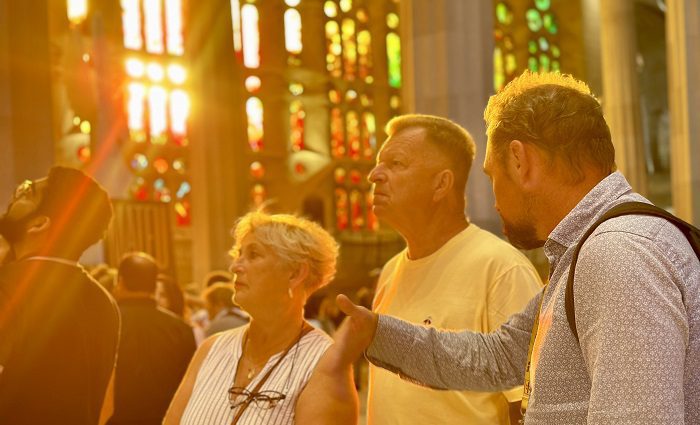
Now that you know a tour of Sagrada Familia is worth it, check out our tours. We run several tours of Sagrada Familia , but each is different. We run tours that explore the interior and those that just admire it from a distance, it all depends on your own desire, though I feel like not going inside is a huge missed opportunity. You’ll find some of our top Sagrada Familia tours below, and you can explore our full and free Guide to Barcelona .
Unbeatable Barcelona in a Day (6.5 hours)
This is a perfect tour for anybody wanting to get deep under the skin of Barcelona and the genius of Anonit Gaudí.
Gaudí certainly left his mark on the Catalan capital, and with this tour, you’ll explore the imaginative gardens at Park Güell and the incredible Sagrada Familia. Through a stroll around the Gothic Quarter and a few stops for local delicacies, what you have here is a perfect day in Barcelona.
See tour itinerary, price, and description
Skip the Line Sagrada Familia (1.5 hours)
The Sagrada Família is one of the world’s most celebrated buildings. It deserves your undivided attention; with this tour, it will receive it. You’ll meet your enthusiastic, expert licensed guide outside of the Sagrada, where they will regale you with stories of its lengthy construction before expertly leading you through the security lines and into one of the modern architectural wonders of the world.
It is a perfect tour for anyone wishing to gain a deeper understanding of Gaudís masterpiece.
Private Barcelona in a Day With Sagrada Familia and Park Guell (6.5 hours)
A private tour may be the best option if you prefer group tours. Do you have a young child who loves to ask questions? Have you already been to the Sagrada Familia and want to get answers to some specific questions? Want to customize the tour itinerary slightly to see spots you can’t miss? All of this is possible with a private tour. Not only will your tickets be sorted, but you’ll also be able to skip the long lines and be expertly guided through the security lines. While the price is higher, the VIP treatment makes it all worthwhile.
Private Tour of Barcelona by Electric TukTuk (2 hours)
Are you looking for a fun way to familiarize yourself with Barcelona’s top attractions? Then hopping on an electric TukTuk with a local guide is a fun and fast way to see the city’s highlights.
You won’t explore the interior of Gaudi’s masterpiece. However, you will learn its history and explore Gaudí’s other masterpieces around the city. It’s a fun way for the whole family to see large tracts of Barcelona quickly and enjoyably. It’s especially useful for any visitors with mobility issues.
Barcelona by Electric Bike
Pedal through the Barceloneta and Gothic Quarters with ease, and see La Rambla, the Olympic Village, and much more in just half a day! Head through the Gothic Quarter and see the top works of Gaudi, including the world-famous Sagrada Familia, and take in the rich history and art of the city. Ride along the seaside, taking in the Mediterranean sun and wind that makes Barcelona an amazing place to live and visit. This 4-hour tour will give you the perfect introduction to the magnificent Catalan capital!
See tour itinerary, price, and descripti https://thetourguy.com/tours/barcelona/barcelona-bike-tour on
Not ready to book a tour? Check out our guide on the Top Things to See at Sagrada Familia
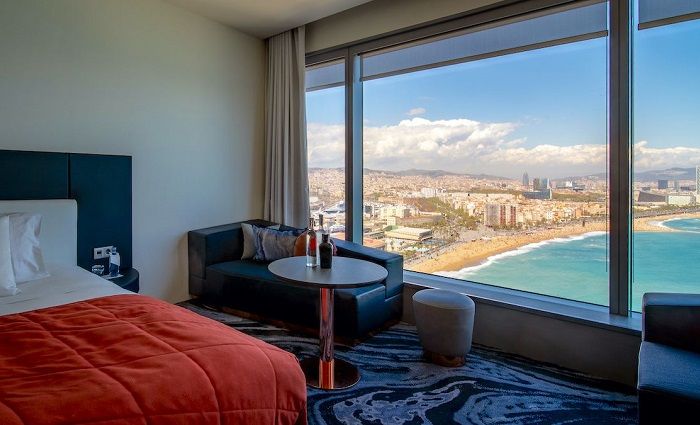
Where To Stay in Barcelona
Barcelona has a small historical center packed with iconic landmarks to explore. Plan where to stay in the best neighborhoods in this beautiful city.
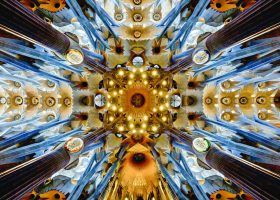
Explore More of the Blog
Reader interactions, leave a comment cancel reply.
Your email address will not be published. Required fields are marked *
- Travel Guide
- In The Press
POLICY & TERMS
- Cancellation Policy
- Terms & Conditions
- Privacy Policy


- Get a Discount Pass
- Buy My Digital Pass
- Buy My Hola BCN Card
- Book Paella at Bodega Joan
- Book My Bus Turistic Ticket
- See a flamenco show
- Attractions Tickets
- Itineraries
- Digital Pass
- Sagrada Familia
- Barcelona Card
- Restaurants
- Casa Batllo
- Hop on Hop off
- Magic Fountain
6 Essential Tips for Visiting Sagrada Familia in 2024
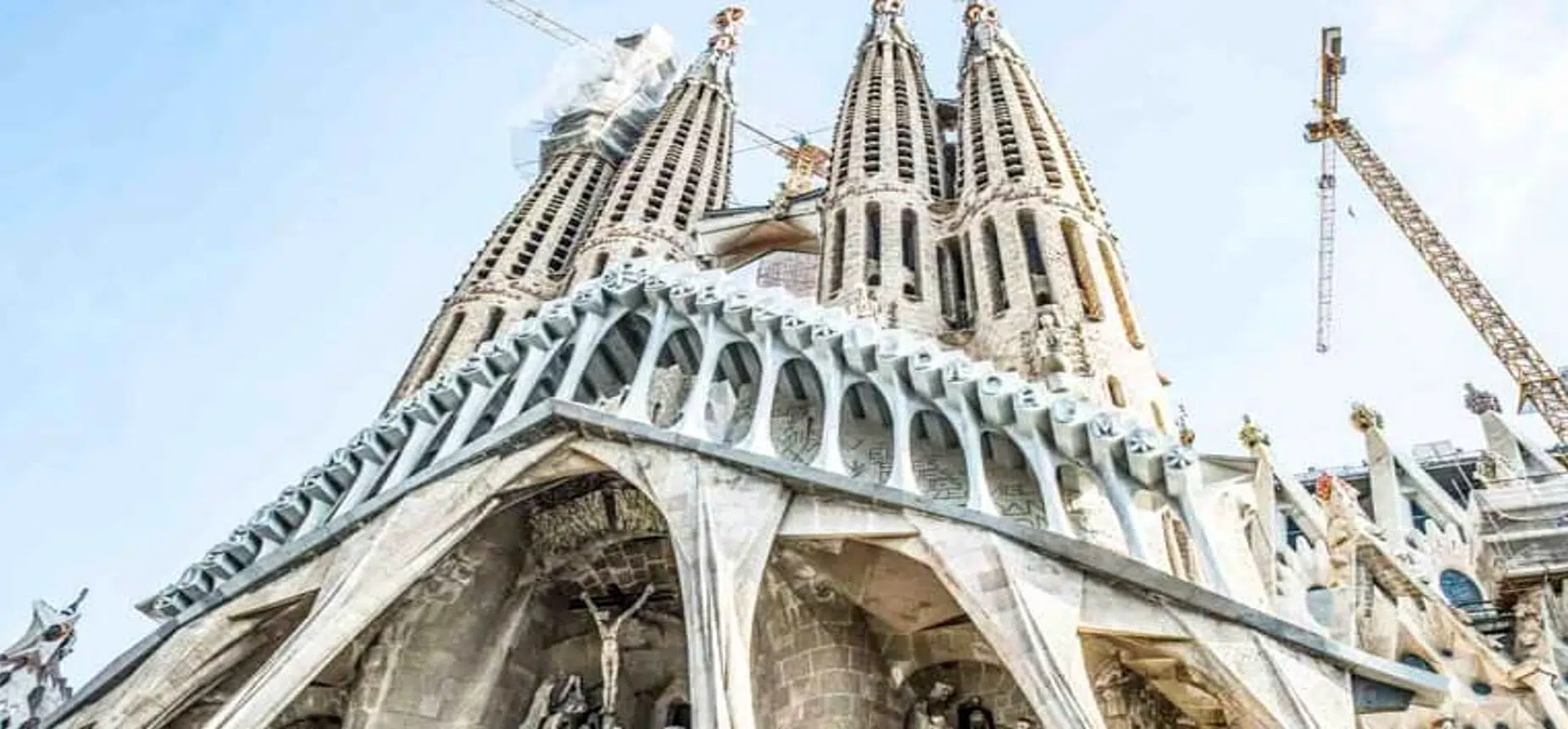
Booking tickets to this world famous attraction is automatic on holiday, but are there any tips for visiting Sagrada Familia?
To make your experience go more smoothly, I’m going to break down some visiting tips here.
Tips for Visiting Sagrada Familia
Tip #1: buy your tickets in advance.
Simply put, you cannot enter the Sagrada Familia without booking tickets online in advance.
If you don’t have them you’ll be asked to book with your phone, though especially in summer you’re likely to encounter sellouts.
Luckily, you can buy them conveniently from our trusted partner Tiqets.
Here you will find all the options available, including simple admission, tours, towers, packages and more. That way, you can intuitively weigh your options:
Tip #2: Consider Climbing the Towers
Yes, I’ve lived in Barcelona for 12 years and have yet to climb the towers.
My excuse? I’m not the biggest fan of enclosed spaces. According to the guidelines, it’s not recommended for people like myself – or people of a large size.
Sure, you can go up to the towers comfortably in an elevator. But you’ll be forced to go down in single file along a very narrow set of stairs.
Nevertheless, if you’re braver than me, remember to purchase an additional ticket to climb the towers (not included in general admission). The views are fantastic.
Tip #3: Book the Best Time to Visit
While Gaudi’s masterpiece is beautiful at all times, I recommend visiting between 9:00 and 10:30 am.
It is the perfect time to visit the Sagrada Familia , as you’ll encounter the perfect array of light and colour that makes the cathedral unique.
I cover this more in depth in my post on how to get last minute tickets to Sagrada Familia .
Related : Best Time to Visit Sagrada Familia

Tip#4: Get a Guided Tour
Sagrada Familia guided tour tickets should be mandatory for a first visit.
Before I took this tour, I was never able to appreciate the genius mind of architect Antoni Gaudi – as every nook and cranny of the church gets brought to life by an experienced guide.
These Sagrada Familia guided tour tickets have a 97% 5-star rating and run seven days a week.
Tip #5: Don’t Get Sucked Into Tourist Restaurants Nearby
Due to its popularity, restaurants for all tastes exist near the Sagrada Familia! If you’re looking for a convenient and quick bite before or after your visit, I’d recommend Buenas Migas .
This delightful cafe offers light Italian-style fare at all hours of the day. It’s located at the crossroads of Calle Mallorca and Valencia, opposite the Passion Facade.
Related : Are There Sagrada Familia Discounts?
Related : Best Tapas Restaurants Near Sagrada Familia
Tip #6: Know Where You’re Going
The Sagrada is easily accessible from every corner of Barcelona, thanks to several bus lines and metro stops (L2 Purple & L5 Blu) that’ll leave you right before the attraction’s famous spires.
For directions from your place of lodging, use Google Maps for the most convenient route. Alternatively, the city center can be reached on foot in 20-30 minutes.
⚠️ 2024 Warning ⚠️ : It’s now mandatory to book your Sagrada Familia tickets in advance .
The only way to guarantee your spot is by booking Sagrada Familia tickets online.
Using the links below, you can even get no-risk free cancellation tickets :
- 🎟️ Buy now: Sagrada Familia Fast Track Admission (skip the lines)
- 👨✈️ Buy now: Sagrada Familia Guided Tours in English (90 minute guided tour – double the length!)
- 🗼 Buy now: Sagrada Familia Entrance + Towers (access all five floors)
The location also makes it easy to reach Park Guell from Sagrada Familia and combine the two attractions.
Looking to lock in your tickets? I’ll leave you with this booking calendar below:
Remember: booking online is mandatory post-COVID.
Still Looking for Sagrada Familia Visit Tips?
Did you like my tips for visiting Sagrada?
Let me know in the comments below, and I can address any additional concerns!
🧑🎨 Want more of Gaudi? Unlock his masterpieces with the top Gaudi tours in Barcelona .
You might be interested in:

Being one of Barcelona’s main transport hubs, it’s not uncommon to find yourself with the common crosstown challenge of getting from Placa Espanya to Sagrada Familia. The 4.2 km trip requires a bit of attention since it involves multiple changes. That said, as with most Barcelona transport dilemmas I’m going to recommend the metro here: […]

Is it worth going inside Sagrada Familia? This is a question that most visitors to Catalonia are sure to grapple with. Well, with over 20 million annual visitors, Sagrada Familia is easily the top attraction in Barcelona. But does the grandeur of the inside match its much-vaunted exterior? Let’s look into the particulars to see […]

Sagrada Familia Church is a UNESCO Heritage Site, the most visited church in Europe behind the Vatican, and Spain’s biggest tourist attraction by numbers. Yup, this famous church in Barcelona just might be the most beautiful ever – and it’s not even finished yet! Let’s figure out how to visit La Sagrada Familia like it’s […]
To offer the best experiences, we use technologies such as cookies to store and/or access device information. Consent to these technologies will allow us to process data such as browsing behavior or unique identifiers on this site. Failing to consent or withdrawing consent may adversely affect certain features and functions.
BOOK YOUR ATTRACTION TICKETS RIGHT AWAY TO LOCK IN YOUR SPOT!
SAGRADA FAMILIA, PARK GUELL, and CASA BATLLO sell out way in advance.
Don’t wait till you’re in Barcelona before booking or you could be left without tickets.


The Ultimate Insider’s Self-Guided Tour of Gaudi’s Sagrada Familia in Barcelona
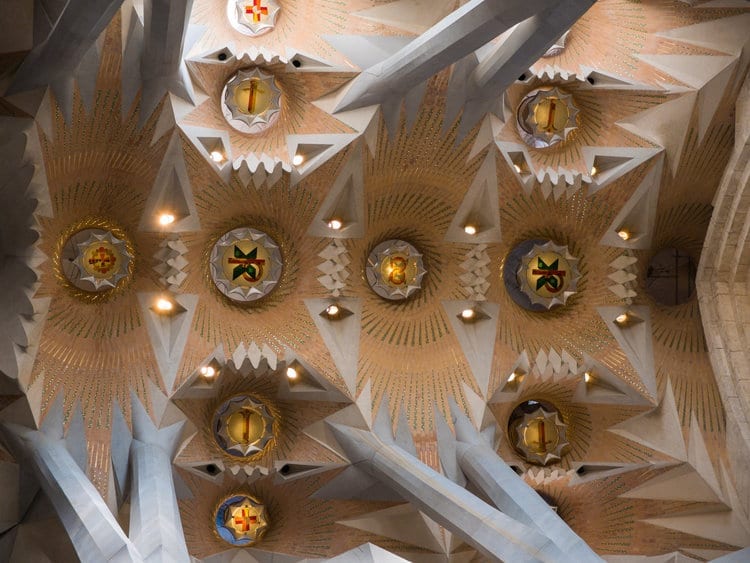
La Sagrada Familia is the beating heart of the city of Barcelona. It can be seen across the skyline almost anywhere you go. The top of the spires peaking out, watching over the city at all times. Designed by Catalan architect Antoni Gaudí , construction began in 1882. And you might be surprised to learn that development is still occurring today. Currently, the best projection for its completion is 2026! A significant year that marks the centenary of the death of Gaudí. Despite its incomplete nature, this is THE MOST important sight to see when visiting Barcelona. Its history, design and the feeling you get upon stepping inside are unparalleled. The church feels like a summation of what Barcelona is all about. And understanding it before visiting or while you tour is essential to better enjoying this fantastic monument.
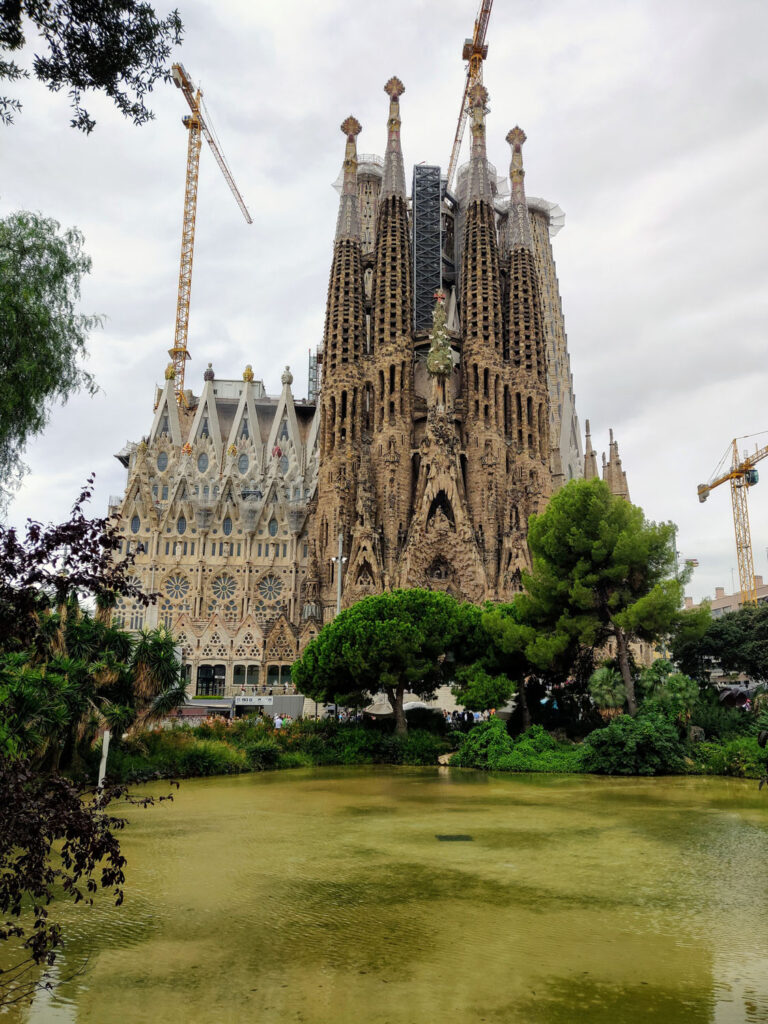
This is a very detailed guide, so I’ve been sure to make a table of contents for you in case you want to jump to a particular church area. This works great if you’re visiting and need more clarification on a certain area. If you’re looking for a shorter summary of what to see, check out my post on the ‘ Top 12 Things to See.’ That guide is ideal if you’re pressed for time and want just the highlights tour !
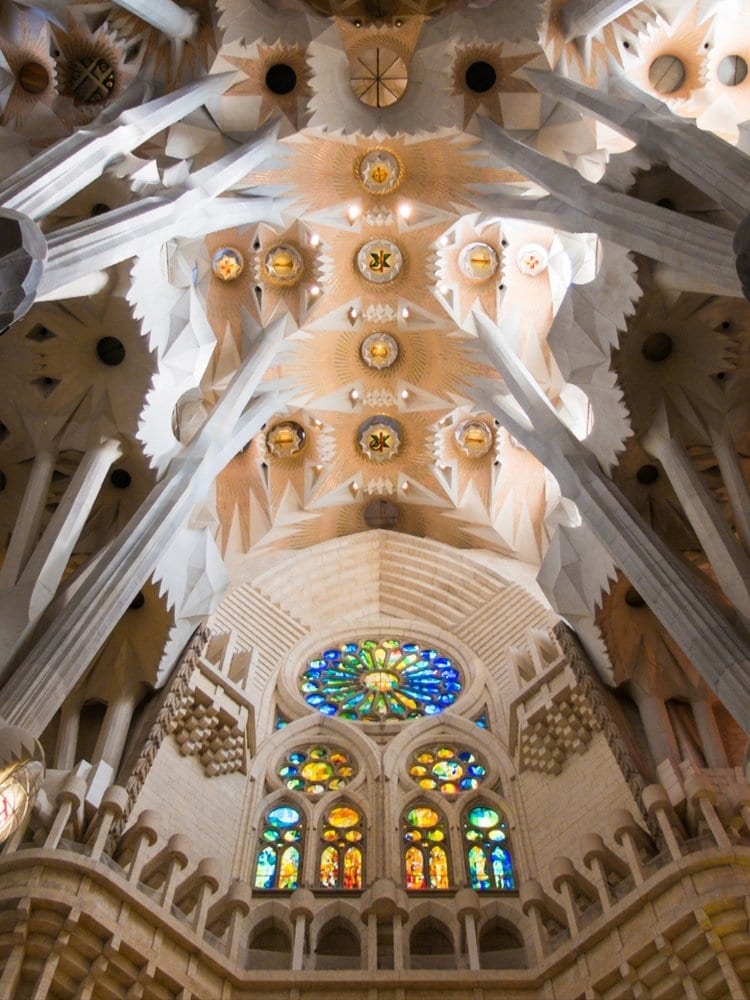
Access & Admission
The Sagrada Familia is pretty easily accessible since it’s located in the centre of town. By metro, you just need to hop on the L5 line towards Sants Station . Upon getting out of the metro, simply follow the signs for the ‘ Sagrada Familia.’ If you are arriving by bus, get on the H10 and get off at the València, Lepant stop. If you bought a Hop-On Hop-Off Bus ticket, these also all stop right in front of the church.
When to Go?
When booking your ticket, you need to select a specific entry time . I’d recommend not leaving it too late. You want to give yourself plenty of time to explore before the church closes. I’d recommend booking your ticket an hour or two before sunset. That way, you can see the building in the light of day and enjoy the magnificent lighting effect of the sunset across the structure. The golden light inside the church casts the most magical glow over the entire nave. And it feels like being transported to another earthly plane of existence.
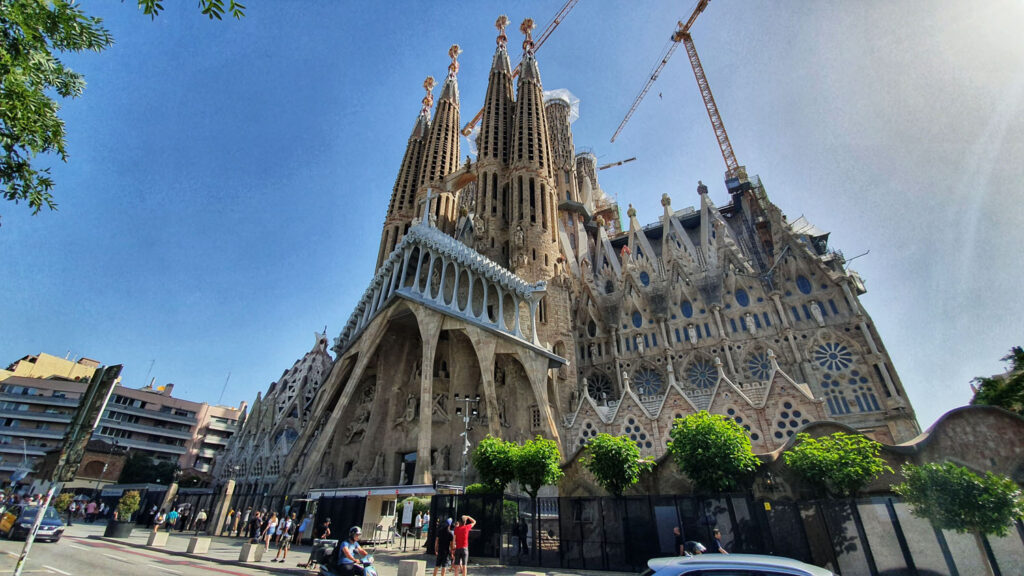
As the Sagrada Familia is the most famous landmark in Barcelona, it draws in some shocking numbers daily. It’s no surprise that thousands of people enter their doors daily. Booking your tickets in advance is always best to ensure you can experience this church easily. You can buy your tickets online up to two months in advance. But I’d advise that you only book them about a week or two before your arrival unless you’re visiting during the holiday season.
Which ticket to buy?
There are basically four ticket types for visiting the Sagrada Familia :
- Basic Ticket 17€
- Audio Guide Ticket 25€
- Guided Tour Ticket 26€
- Audio Guide and Towers Ticket 32€
While I did enjoy my guided tour, and I’d usually strongly recommend them, I felt like the guide rushed us through the church. Fair enough, there is so much to see, and you only have them for an hour. But even still, it felt incomplete. Even though I could go back to what I felt I’d missed after the guided tour, there was so much to see that I wished I could have understood better. That’s why I created this blog!
This self-guided tour allows you to go at your own pace. You can sit and absorb what you’re seeing. Take a moment to just listen to the sounds around you. And learn about all the facets of the church. Plus, this free tour will save you a bit of money. While the towers are interesting to see and give a nice view over the city, there are betters views to be found for a much lower price. So I’d advise skipping them and instead focusing on looking into the building instead of out of it.
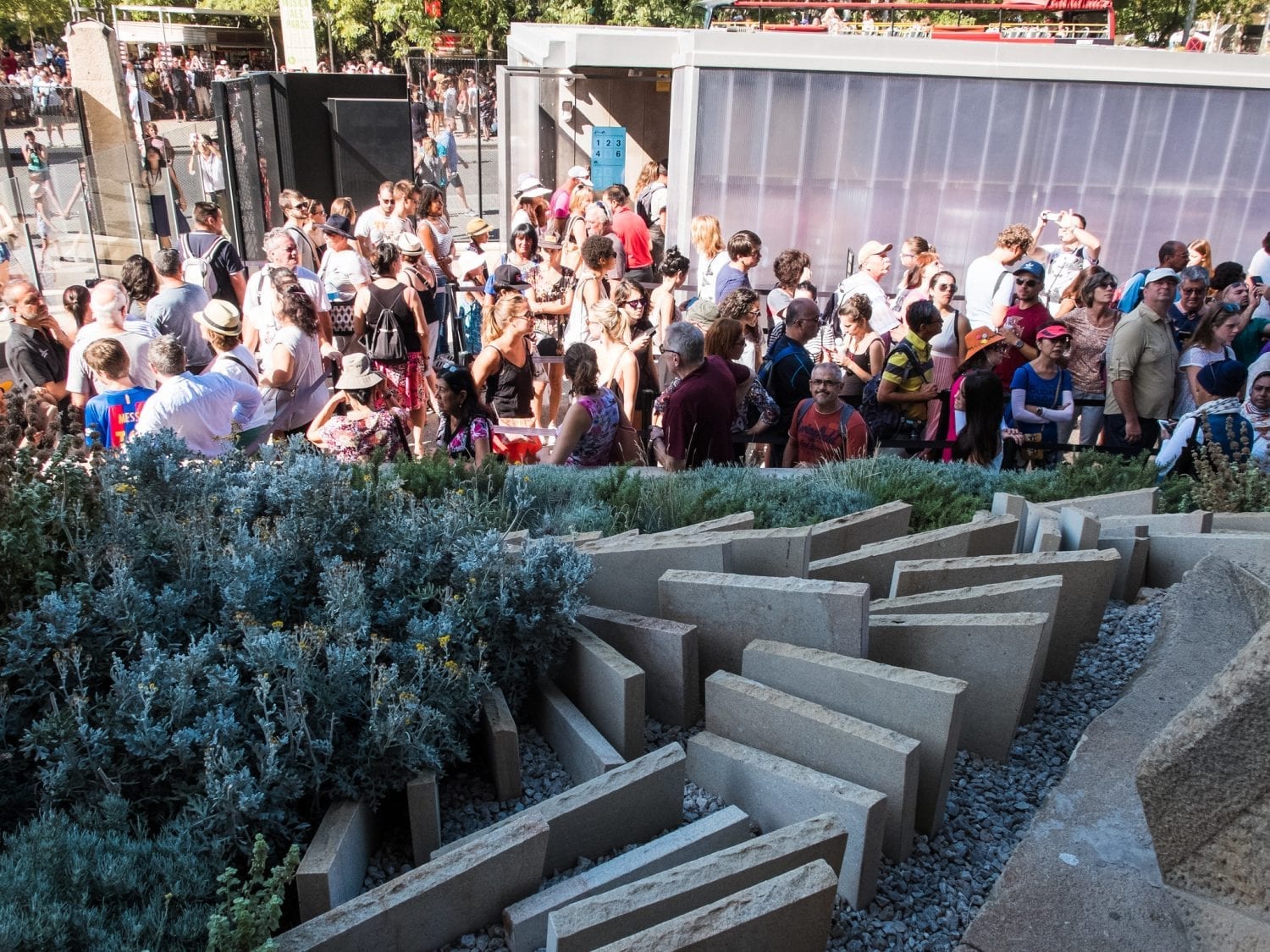
During the 19th century Barcelona, along with the rest of Europe, was undergoing a significant change. The church, which had once held such immense power and authority over cities, now lost its cultural influence with the growth of independent governments. Urban lifestyles were changing the way that Catalonians lived, and more and more, the church was becoming less and less a central part of their daily routine.
In 1866 the Spanish clergy created the Association of Devotees of Saint Joseph . They took it upon themselves to help bring back the relevance of faith and spirituality in Catalonia. They raised enough money to start construction on a wondrous temple. A church is so spectacular and eye-catching that it would be the spot where pilgrims from all over the world would travel and which would encourage locals to come back into the fold. The church was dedicated to the Holy Family. The first architect of the church was Francisco de Paula del Villar y Lozano . But soon after construction started, he resigned. They then enlisted Catalan architect Antoni Gaudí . And that one decision would be the catalyst for the creation of what is now one of the greatest man-made wonders of the world.
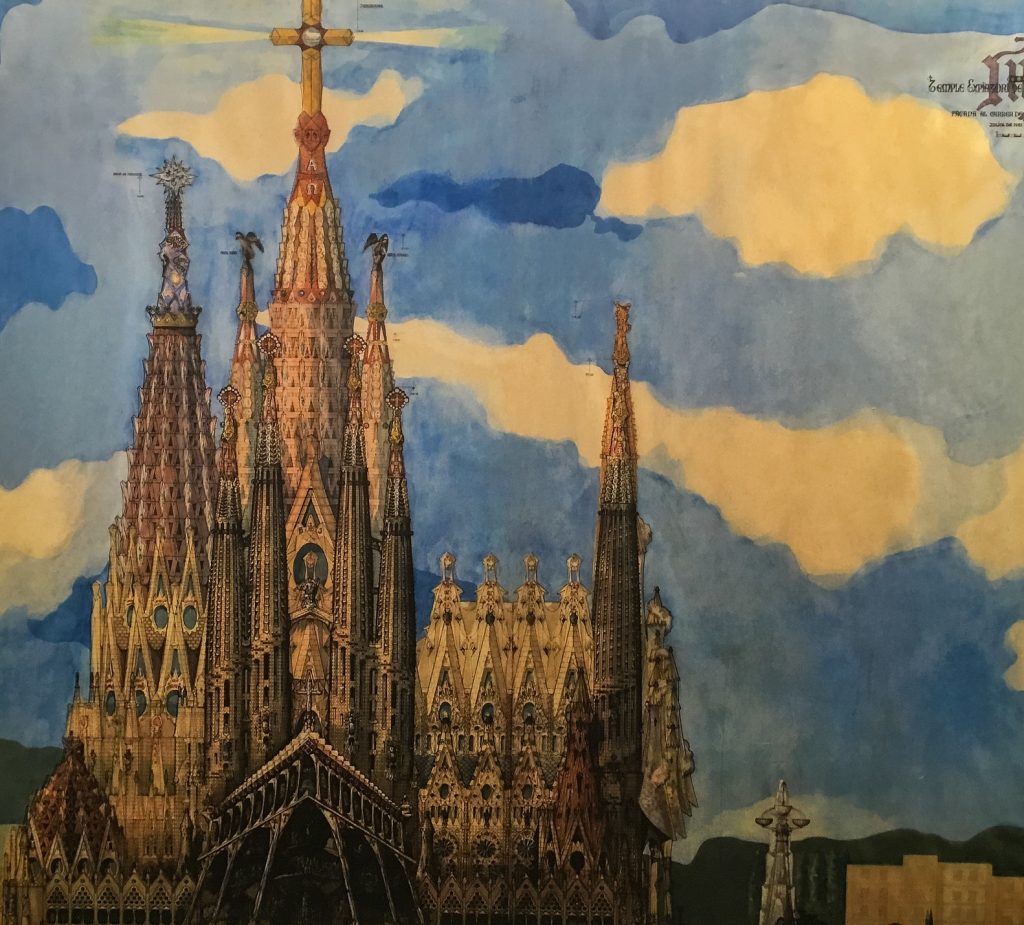
Master Architect Antoni Gaudi
Antoni Gaudí is the mastermind behind this incredible church design. Gaudí’s works can be seen all across Barcelona. And he was one, if not the most, influential artist who helped create the Modernism movement in Catalonia. Gaudí was inspired by neo-Gothic art, organic forms, and Oriental techniques, which can be seen throughout.
Gaudí’s style formed the artistic style of the city, and the critical piece to his portfolio is the Sagrada Familia. Gaudí’s greatest inspirations were nature and religion. In designing the Sagrada Familia, he combines these elements to near perfection. Gaudí’s aim in creating this Basilica was to link heaven and earth together. He was inspired by the nearby Montjuic Mountains’ shape and power over the valley. He wanted the church to feel like a new mountain sprung from the ground.
Gaudi’s Death
Gaudí was run down by a streetcar and died in 1926. Only a small portion of the Basilica had been built when he passed. Although his life was cut short, Gaudí knew he would never see the church finished. He looked back to the great medieval cathedrals which took hundreds of years to create. Some take over 100 years from start to completion. He put every ounce of creativity, innovation and imagination into the temple’s design. When he died, his revolutionary work would inspire the next architect who took over. Many people were surprised that Gaudí would set out to create something which would take so long to build; when asked why, Gaudí would always say, “ My client is not in a hurry.” This is where he got the nickname “God’s Architect.”
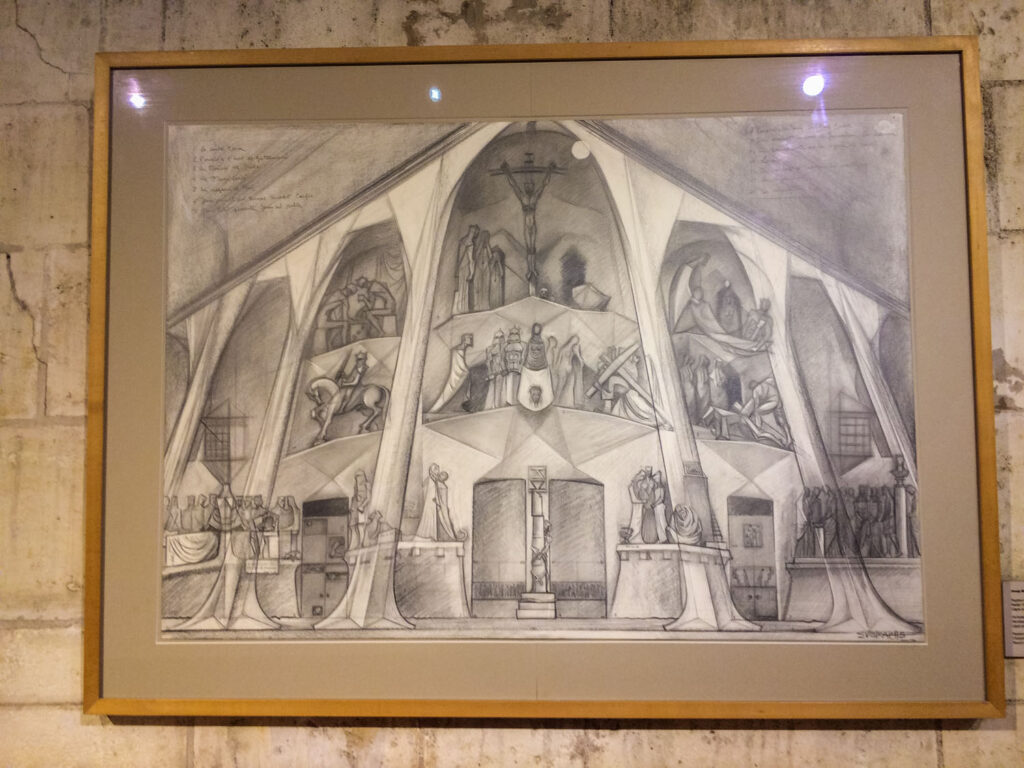
Sagrada Familia Design
The Sagrada Familia is 4,500 square meters large. It’s the size of an American football field. And when you see it in person, you can truly understand how big it is. The Basilica’s layout is that of a traditional Latin cross design. The Latin cross design features five naves, a crossing, an apse and an exterior cloister-style ambulatory. The exterior has three different facades, each a varied work of art whose imagery tells a story. Although not yet built, the tallest part of the church will be 172.5 meters tall. The highest point in the city but just shorter than Montjuic Mountain (because no man-made building should exceed what God created). The church can hold 14,000 worshippers! That’s the size of a small city. Gaudí wanted to create a place where everyone in the city could gather. Making it feel like it was always open to whoever wanted to come in. A small church just wouldn’t have had the same effect.
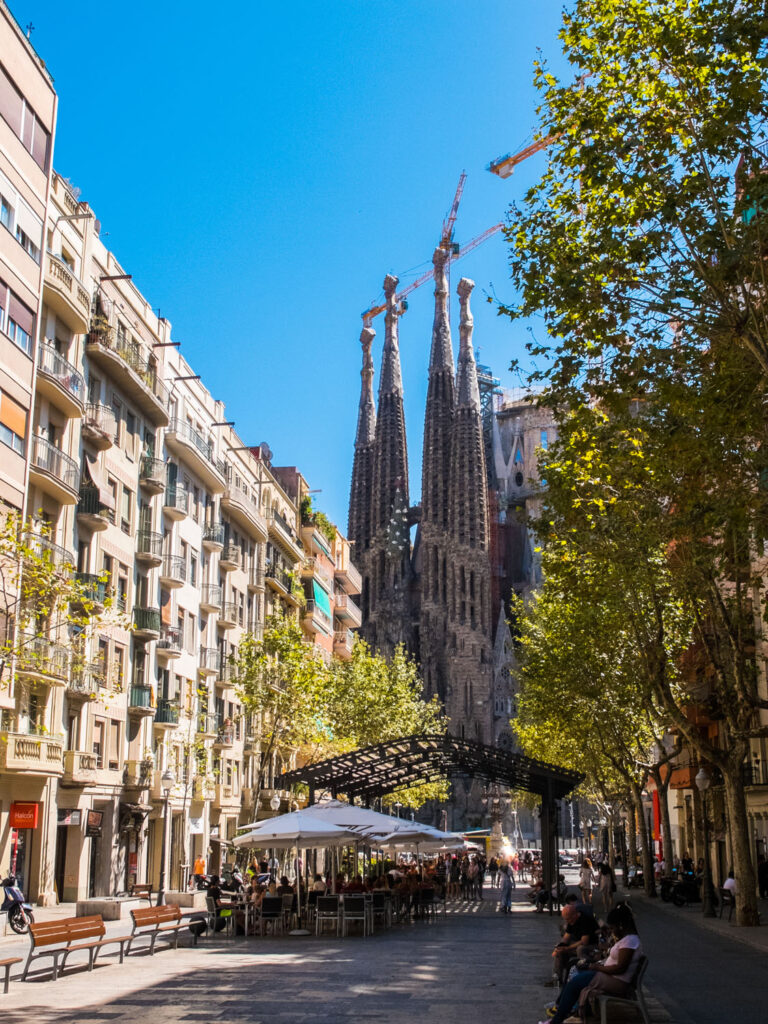
It’s important to highlight that, for our readers to understand Gaudi’s vision and references, we will be talking broadly about stories from the bible. And while not everyone who visits this church will be religious, the context will help you understand the meaning behind the construction. If you aren’t spiritual, just think of these citations as stories (or consider the real people who inspired those characters).
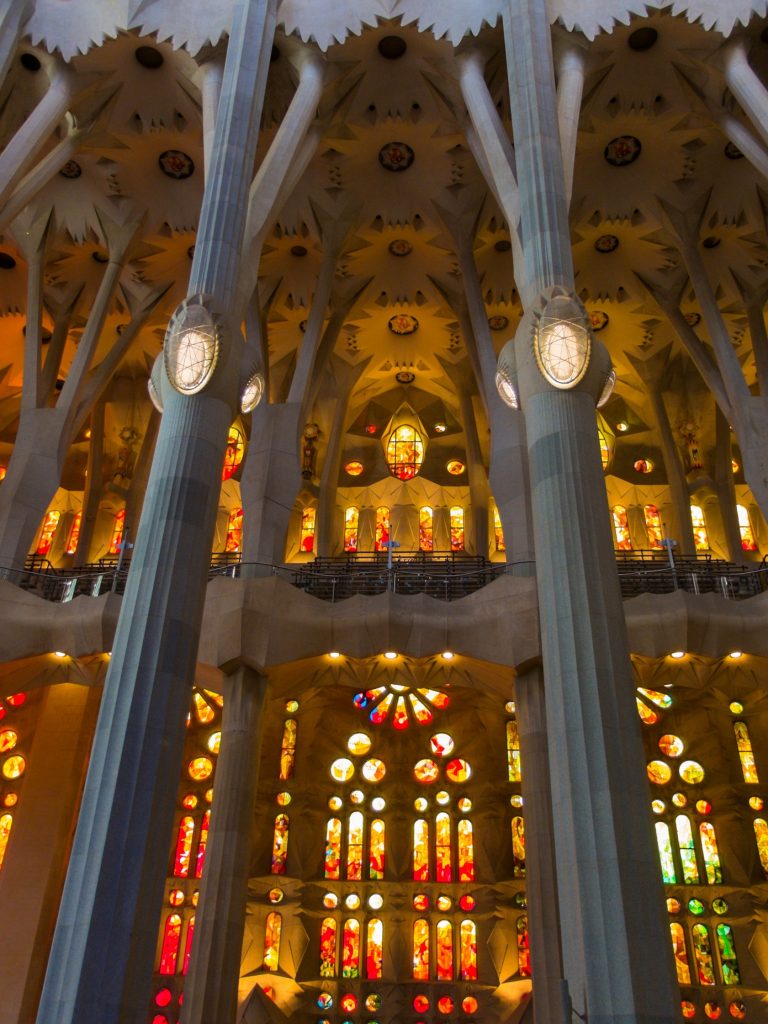
The Nativity Facade
To enter the Sagrada Familia these days, you’ll approach via the Nativity Facade. This was the only part of the church entirely designed by Gaudí. And he almost saw it finished as it was completed in 1935, just after his death. He was there almost daily overseeing the work, and it feels like the part of the church which is the most personal. The Nativity Facade has three entrances. One central and two lateral topped with four hollow bell towers, representing the four stripes of the Catalan flag. The Nativity facade faces the rising sun, as it represents the dawn of the life of Jesus Christ.
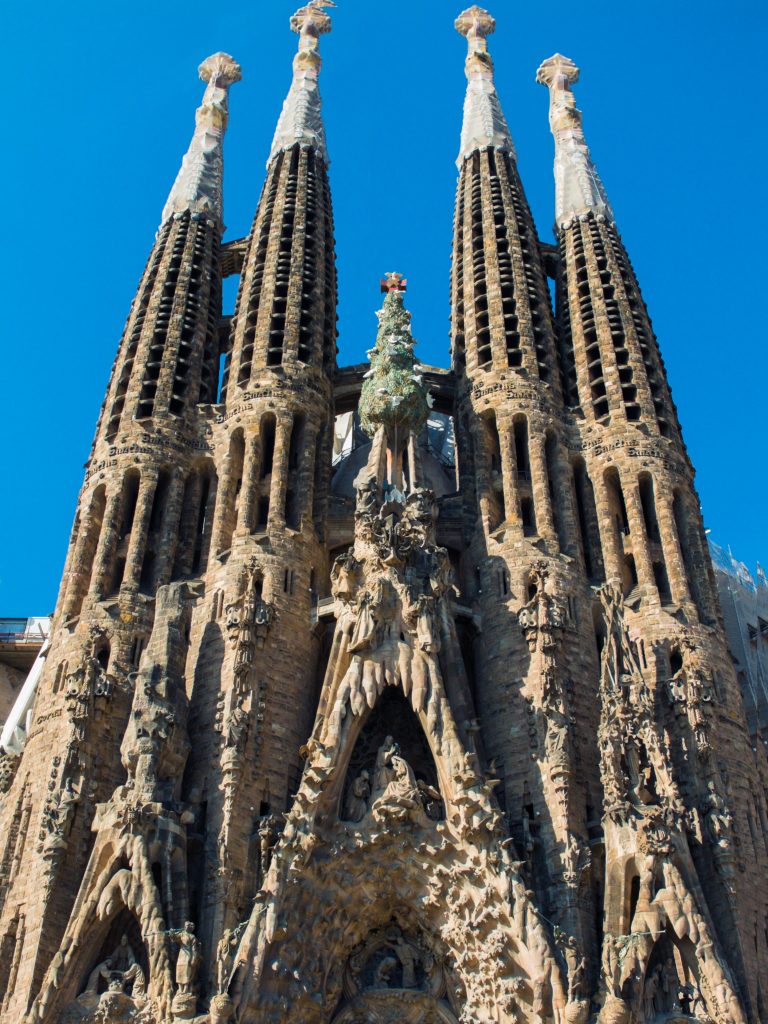
The three entrances on the Nativity facade are each dedicated to a theological virtue of the three members of the Holy Family; Hope, Charity and Faith. A portico is a triangular porch hanging over the church’s entrance. One of the most delightful little aspects of these entrances is the little details you might miss, so keep your eyes peeled.
One of these small details to notice when looking at the entire facade are the snowcaps carved into the stone. The snow is meant to look like it is melting off the tops of the hollows of the entrances. Gaudí used snow to remind the people of the festive Christmas season. So many aspects of Gaudí’s plans were drawn from historical architectural references. But others were meant to evoke a response for the common man. Something everyone can understand and evokes something within them.
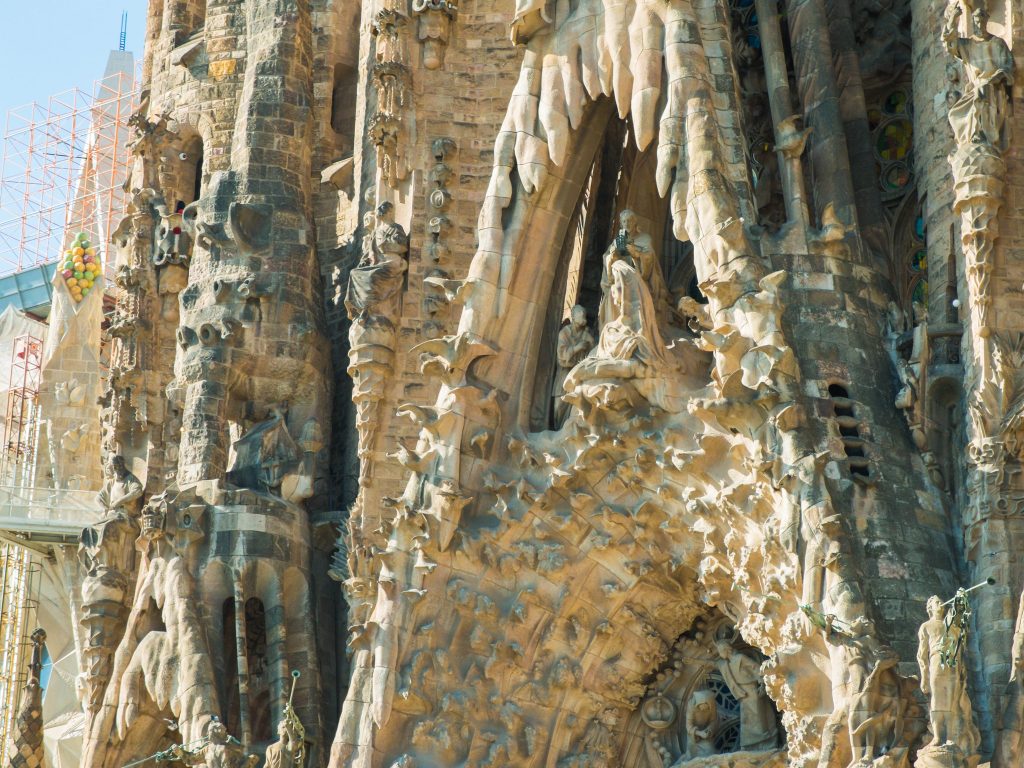
Gaudi’s Gargoyles
Instead of gargoyles, which are so prevalent in neo-gothic architecture, you’ll find a different kind of creature which caps the various edges of the roofline on the Sagrada Familia. Gaudí chose to use reptiles and amphibians (like snails, frogs, chameleons and lizards.) These creatures crawl on the edges of the building. While gargoyles are mythical creatures, Gaudí chose to pick beasts from our world who are biblically associated with the lower ranks. Gaudi believed they served the same monstrous purpose as the gargoyles in Gothic churches. They are not decorative, but their open mouths are used to drain rainwater from the temple’s roof.
The Hope Portico
The Hope Portico, dedicated to Saint Joseph, is on the far left side of the facade. This portico depicts scenes of virtue in times of adversity. We’ll study this piece from the top of the entrance, continuing downwards, beginning with St. Joseph’s Pinnacle.
St. Joseph’s Pinnacle
St. Joseph’s Pinnacle is almost hard to make out. It’s so high up, and sculptures blend in with the rest of the stonework. The textures given to the exterior are designed to reflect the crags you find on Montserrat, the sacred mountain of Catalonia. Just below the climax of the Hope Portico, you’ll see the figure of Saint Joseph sitting inside a small boat. The boat is an important symbol. Saint Joseph helped navigate the Catholic church as the patriarch of the Holy Family.
On the ship’s helm are three emblematic objects; a dove, an anchor and a lantern. The dove symbolizes the holy spirit, the anchor signifies faith’s constant grounding, and the lamp implies the light the word of Jesus Christ provided to the faithful. It’s important to note that this carving of Saint Joseph is thought to resemble Gaudí himself. The sculptors decided after his untimely death to immortalize Gaudí in the church. Gaudí himself feels like a patriarchal figure to all those architects who would follow in his footsteps.
The Holy Marriage
Below the pinnacle, in the hollow of the top arch, we find a grouping of three people. This is the scene of the marriage of Saint Joseph to the Virgin Mary carried out by a high priest who stands in the centre. They kneel over a basket of roses that symbolize God’s love at work in the world. Blossoming below this sculptural group are luscious flowers reminiscent of those growing on the Nile banks. Egypt was where the holy family experienced so much fear and terror; eventually, they had to flee the country. But they fled not without hope, which is what this entrance is dedicated to remembering. Hanging amongst the flowers are stone-carved rosary beads. 59 beads surround most of the windows on the porticos. Another way in which Gaudí combined the physical act of prayer into his church.
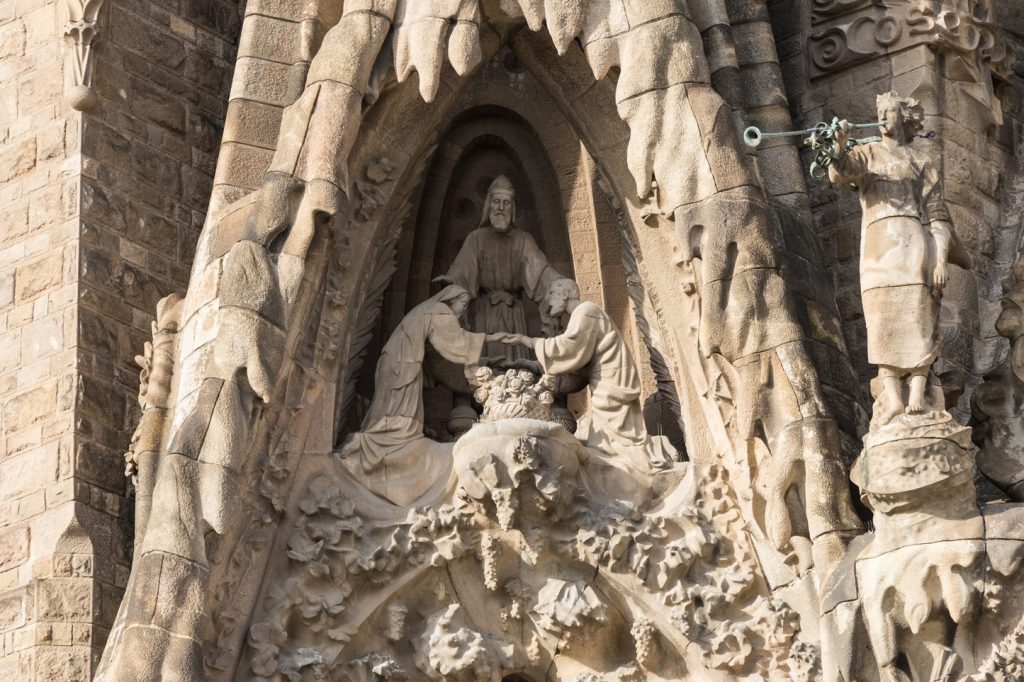
The Tympanum
Above the doorway, in the Hope Portico, we have the tympanum, which contains scenes from Jesus’ childhood. These tender moments between the young Jesus make him much more human rather than godly. On the bottom right, we see the Holy Family with Mary and Joseph and an angel guide fleeing Egypt. In the centre, we see the child Jesus in his father’s arms. A single dove flies off into the distance below them. Amidst this scene of father and son is something which you might miss. A set of carpentry tools carved in stone. Jesus’ adolescence was spent being a carpenter’s apprentice. And it was lovely to see that human side of his life immortalized in stone.
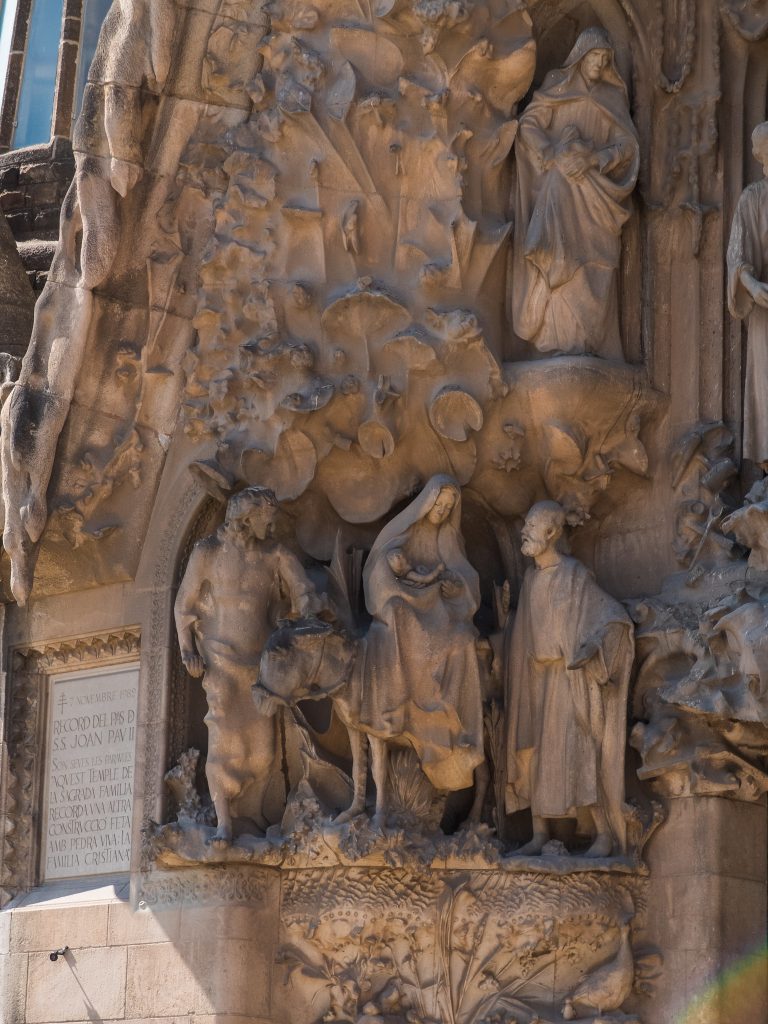
Slaughter of the Innocents
On the right, we have one of the most violent scenes from the bible: the Slaughter of the Innocents. This display shows a Roman soldier tearing a child from their mother’s arms. Under the soldier’s feet are babies’ bodies who have already fallen to the soldier’s sword. Although this is hard to see, if you manage to look closely, you can see that the Roman soldier has six toes on one foot. A small detail but one denoting his monstrosity.
Although this is a sad scene, it’s an important historical moment. When hope was all that these people had to cling to survive. On this side, the edges of the entrance are formed into the shape of a chameleon. The chameleon is an animal that represents change, and change is what hope is based upon. The fact is that even in the darkest times, there will be light. Light is representative of change, and the turning of tides gives even the most lost hope.
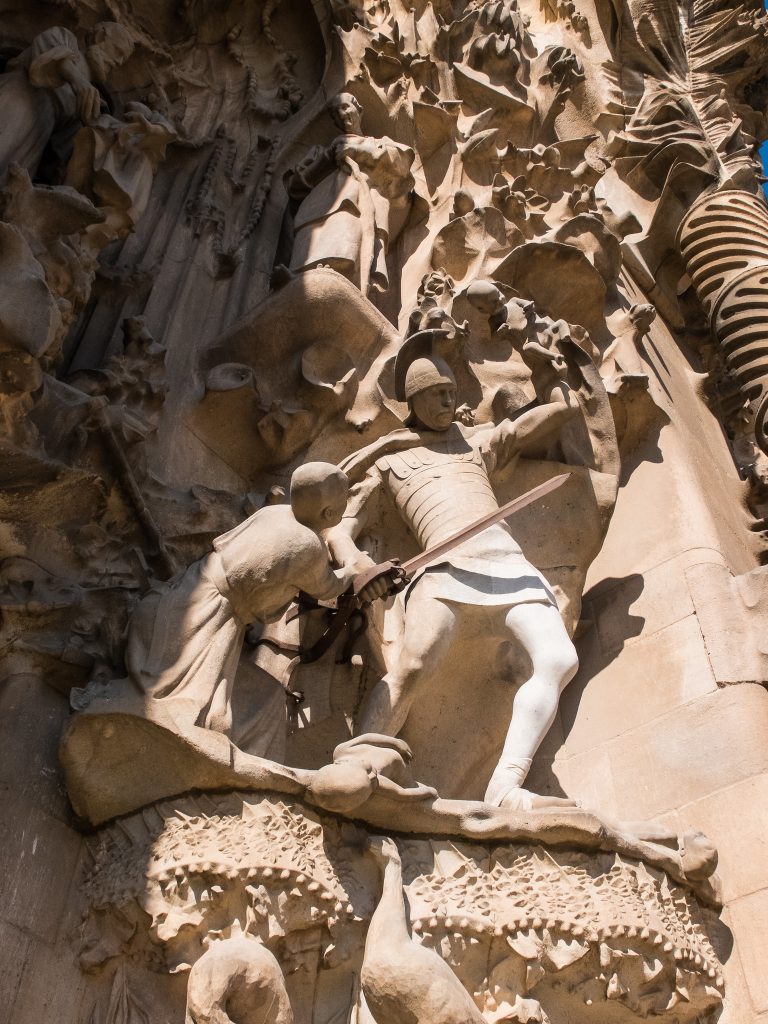
The Charity Portico
The central and most crucial portico on the Nativity Facade is the Charity Portico. Jesus’ charitable nature was one of his most notable characteristics, yet this entrance is filled with scenes of the Virgin Mary. This reflects how those who nurture us pass on their core values and attributes. The textural treatment of this portico is slightly different than the others. The exterior is covered in design elements that resemble or call back to the stable in which Jesus was born. Animals, birds and various plants are hidden throughout the mass of ornamentations that swell over the pointed portico.
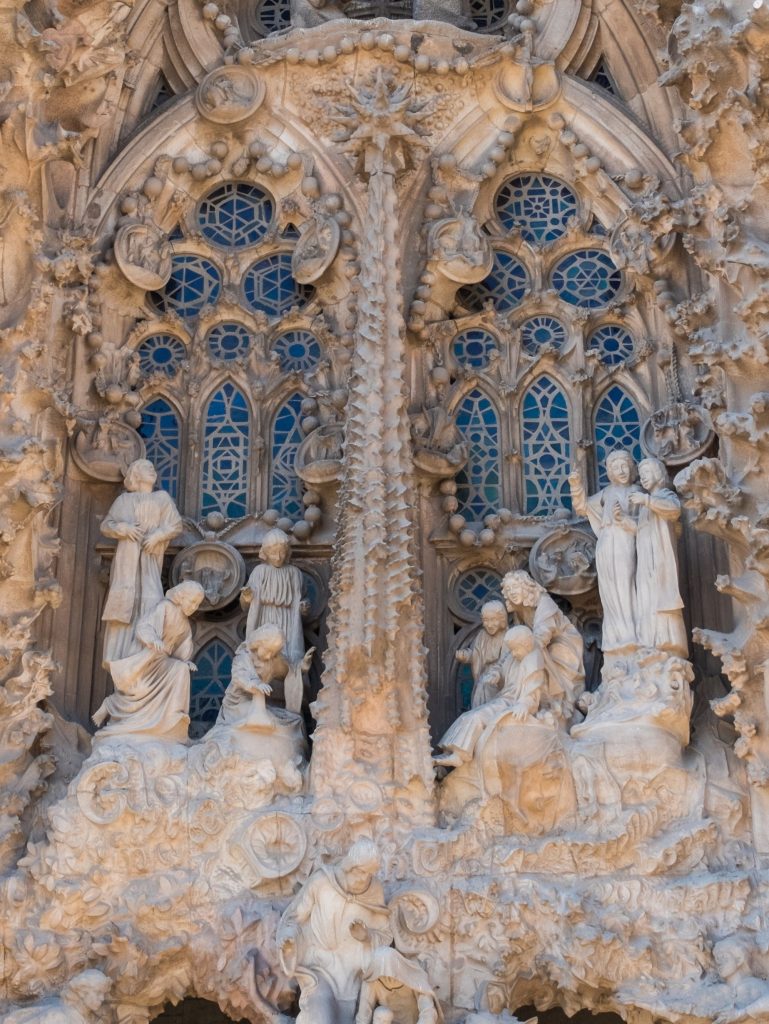
The Tree of Life
Again, starting from the top down, let’s first focus on the Tree of Life . The culminating part of this portico is capped with a polychrome-coated green cypress tree. Polychrome decorates architectural elements, like pottery or sculpture, in various colours. Gaudí originally intended for the entire Nativity facade to be polychromed. He believed that if every sculpture, face, plant and animal were painted, they would come to life in a much more realistic way. Unfortunately, the cost of this much exceeded the budget! And so, polychrome was used sparingly. But therein making where you see those colours that much more impactful.
Symbolism on the Tree
The cypress tree symbolizes eternity since it’s an evergreen plant and never loses its leaves. Covering the tree are 21 white doves that fly out of their nests and into the sky. On the top of the tree, like a Christmas Star, is the red and white symbol of the holy trinity. The Greek cross formed the base of this symbol. The Greek cross combines the letters’ alpha’ and ‘omega,’ which mean the beginning and the end. Atop the cross is the last white dove, its arms spread wide, resembling the shape of Jesus on the cross.
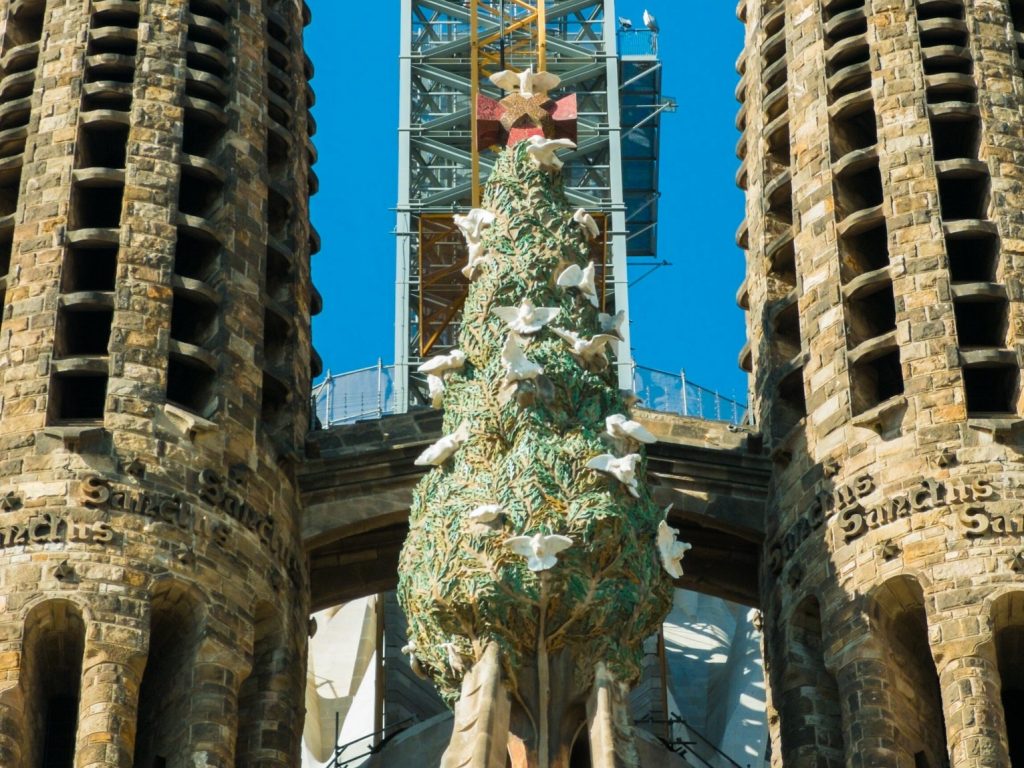
Two ladders are placed below the tree, representing our mortal desire to reach eternal life. Below the tree, you’ll see a pelican perched, her beak angeled toward two baby birds, ready to be fed. The pelican was once believed to be a symbol of the Eucharist as in ancient times, people thought the pelican opened its chest to feed its young, just like Christ offered up his own body to feed his disciples. Hidden beneath the young pelicans is a brightly coloured egg adorned with red and yellow glass. The egg is thought to represent either the birth of the universe or the symbol of Jesus’ resurrection.
Below the tree is a group of angels burning incense inside old vessels called ‘centers.’ Burning incense in the church is an ancient tradition representing the faithful’s prayers rising to heaven. The pinnacle’s stonework is covered in little bubbles, thought to represent the incense floating up toward the sky. It’s important to note that the angels here were actually sculpted by Gaudí himself.
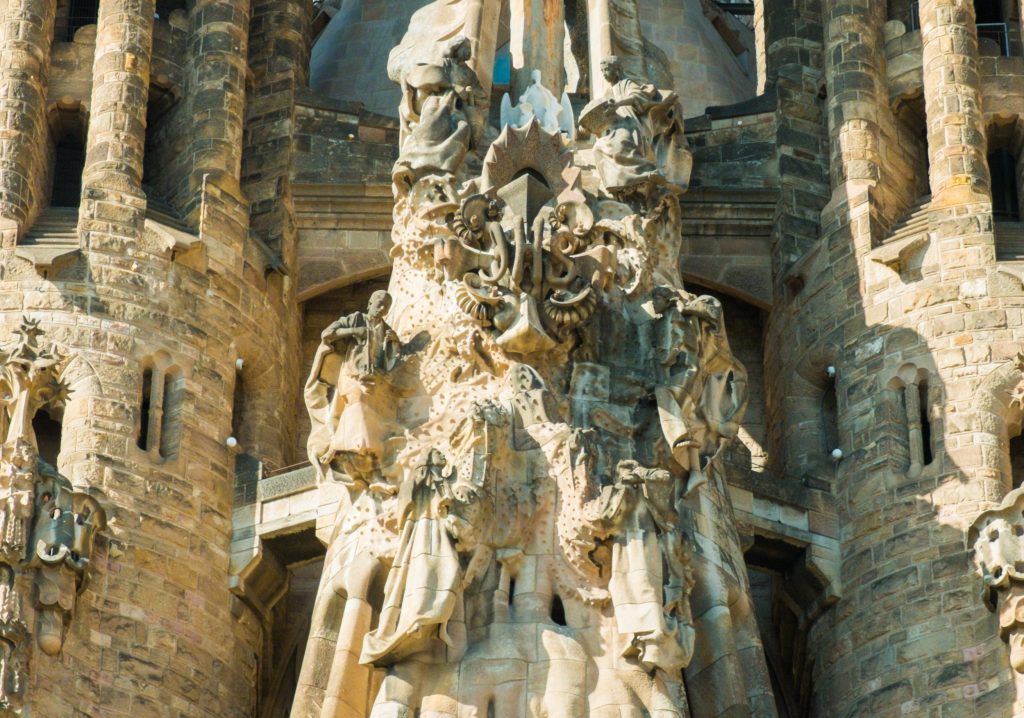
The Crowning of Mary
Below the tree of life, we come to a small cave. Here we can see a little intimate scene of Jesus placing a copper crown atop the Virgin Mary’s head. Crowning her the Queen of Heaven on Earth. This was her reward for her ceaseless love for God and humanity. Despite what they had done to her beloved son. On the left, we see Saint Joseph there to witness the event. And on the right, we see the Holy Spirit represented as a man. The entire scene is set in front of one of the incredibly colourful stained glass rose windows. At certain times of the day, the glass seems to set the entire scene aglow with mystical light.
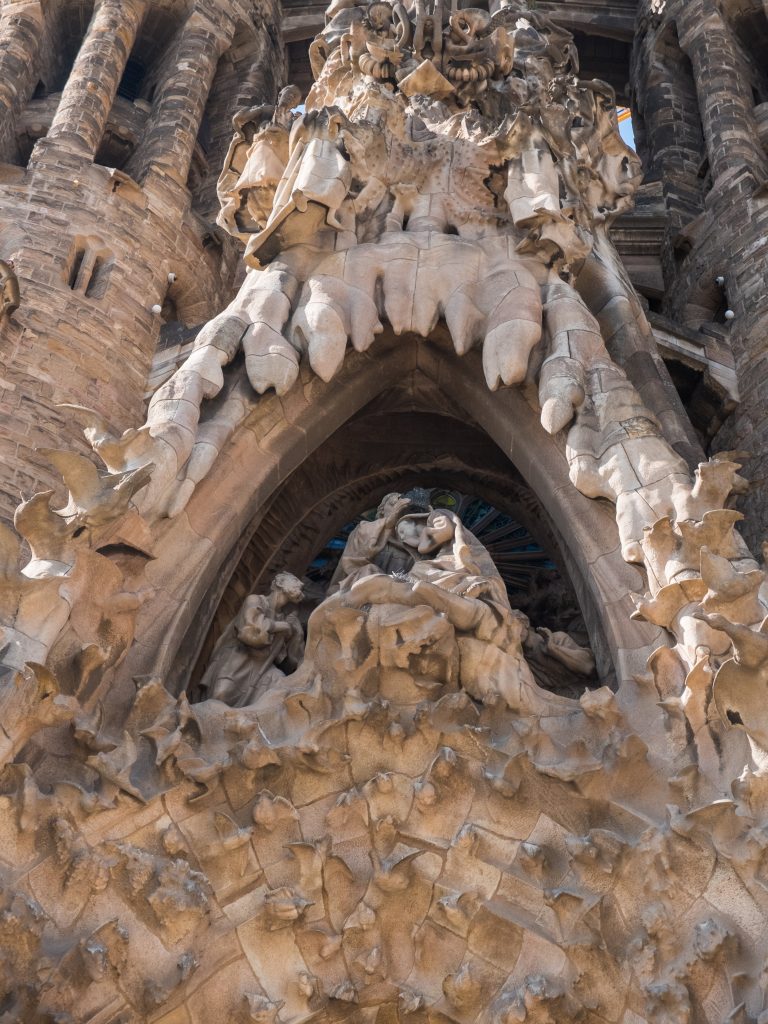
The Charity Vault
The vault in the Charity portico contains the scene of the Annunciation. We find the archangel Gabriel told Mary that she is the chosen one. Who will bring the son of God into this world? Surrounding this petite scene are the signs of the zodiac. And depictions of constellations across the sky. Just as they would have been on the night Jesus was born. Bands of rosary beads surround the scene. Hanging around the rosary are medallions carved in stone representing the ‘Miraculous Medals,’ which you find around rosary bracelets.
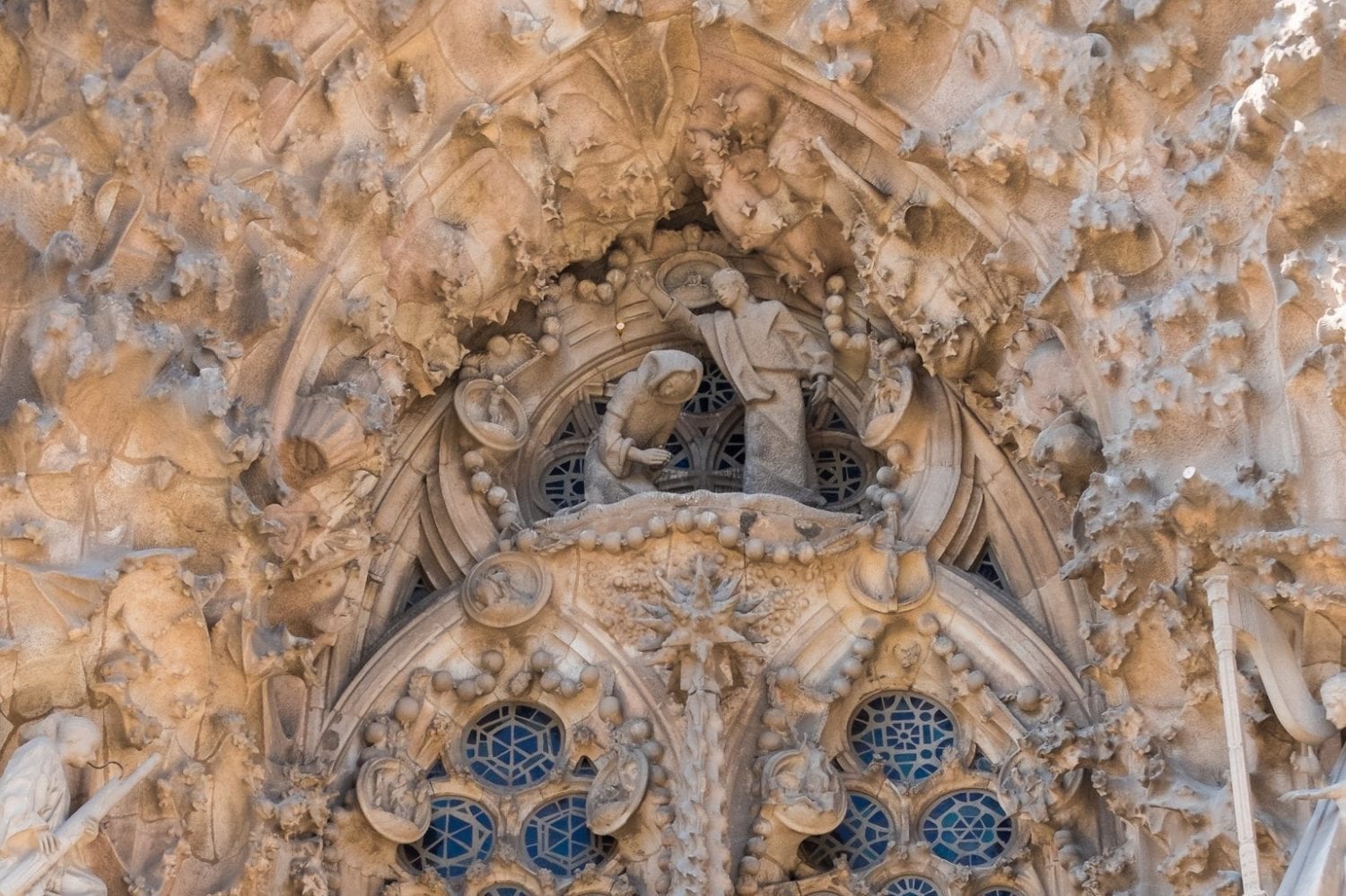
The Chorus of Angels
Above the Charity doorways, here is a chorus of angels. Each angel is a musician, playing popular instruments in religious settings. Instruments like the lute, the violin and the harp, the more common guitar, the bagpipes and the tambourine can all be found here. Once more, this was a way of the common fold being able to see themselves in the divine. Running up between the two sets of stained glass windows behind the angels is the multi-pointed star of Bethlehem. This was the star that shone in the sky to announce the birth of Jesus.
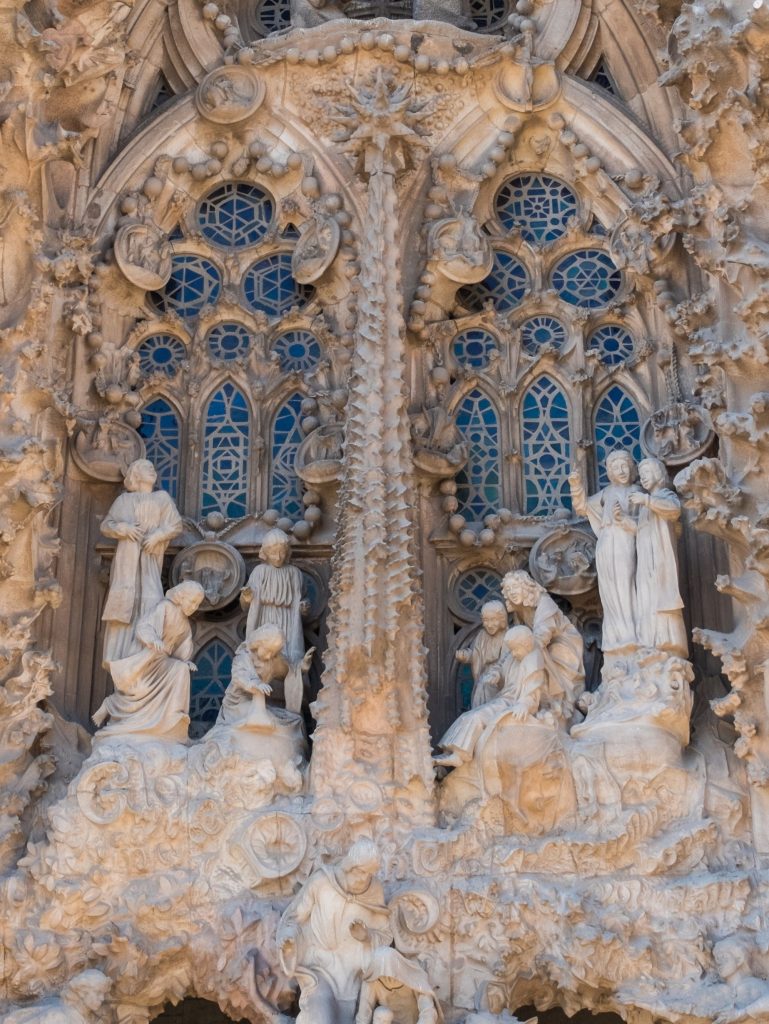
The Adorations
To the left of the double doorway, we can see sculptures of the Adoration of the Magi. And on the right, we have the Adorations of the Shepherds. Some scenes from the Nativity represent how Jesus’ arrival brought people from such disparate groups together. For me, this scene is especially poignant since I feel Gaudí achieved a similar reaction in the construction of this church. No matter if you are religious, spiritual or neither, this building still draws people from far and wide into its arms. And once they behold it for themselves, there is never a question of its outstanding cultural value.
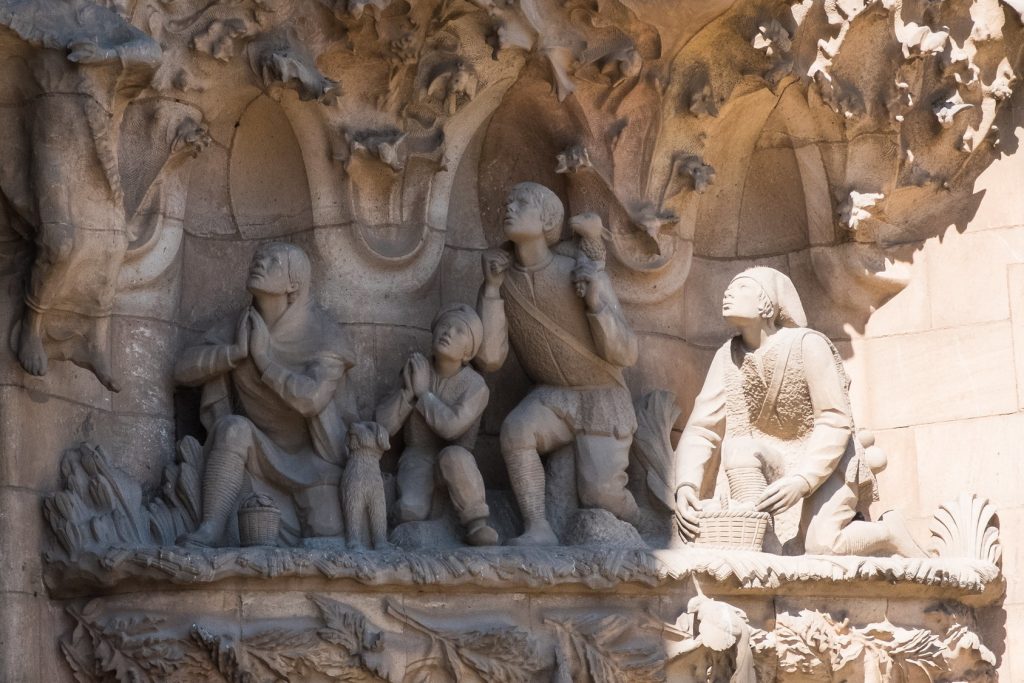
The Monumental Columns
Three primary columns are located at the base of the church, each representing a member of the holy family. The one in the centre of the two charity doors is the Jesus’ Column, and the other two flanking the charity portico are dedicated to the Virgin Mary and Saint Joseph. On the very top of the central column is baby Jesus, being placed into a bassinet by his mother. His father looks on, as do an ox and mule, just like the Christmas carol. To the left of this scene is a small text inscription expressing “Gloria in Excelsis Deo,” a phrase spoken by the angels on the night Jesus was born.
Large palm leaves look like they’re supporting the group atop the column. Palm leaves are a symbol of victory in Roman culture, and the date fruits hanging from the leaves symbolize faith. Surrounding the column is a thick ribbon with inscriptions inlaid upon it. The form of ribbon almost looks like one side of a DNA strand. Fittingly, it is thought that the inscriptions on the fabric are Jesus’ genealogy dating back to Abraham. Halfway down the column, the stone is surrounded by dense iron mesh. If you peek through the mesh, you can make out the shape of the snake biting an apple, the symbol of original sin. The iron mesh traps the reptile from fleeing the garden and invading the pious world.
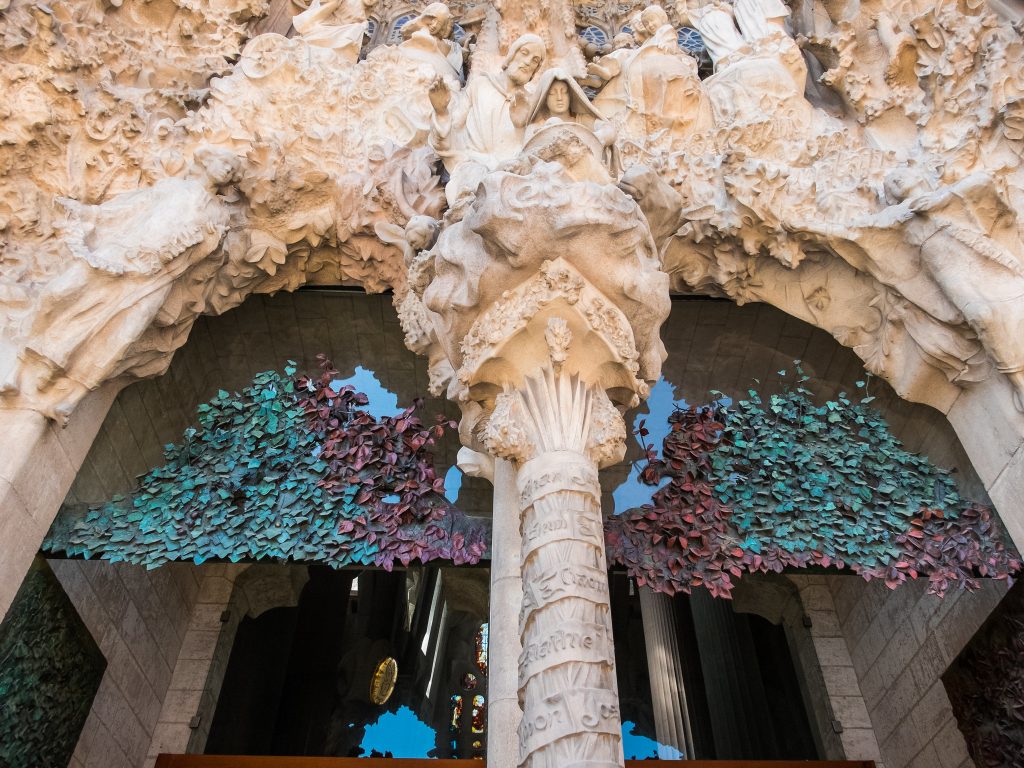
Carvings on the Column
Atop the two remaining columns flanking the sides of the Charity portico are a pair of angels playing long bronze trumpets announcing the birth of Jesus. The models for these sculptures were a group of military musicians who were good friends with Gaudi. The angels stand atop more palm leaves, covered in snow and dates. The centre of the columns is marked with an inscription, each inscribed with the names of those to whom they are dedicated to. At the bottom of the columns are carvings of a tortoise and a turtle, holding the entire weight of the column up. The turtle represents the land, and the tortoise the sea. Both of these animals are unchanging and, as such, are capable of being the foundation upon which this church is built.
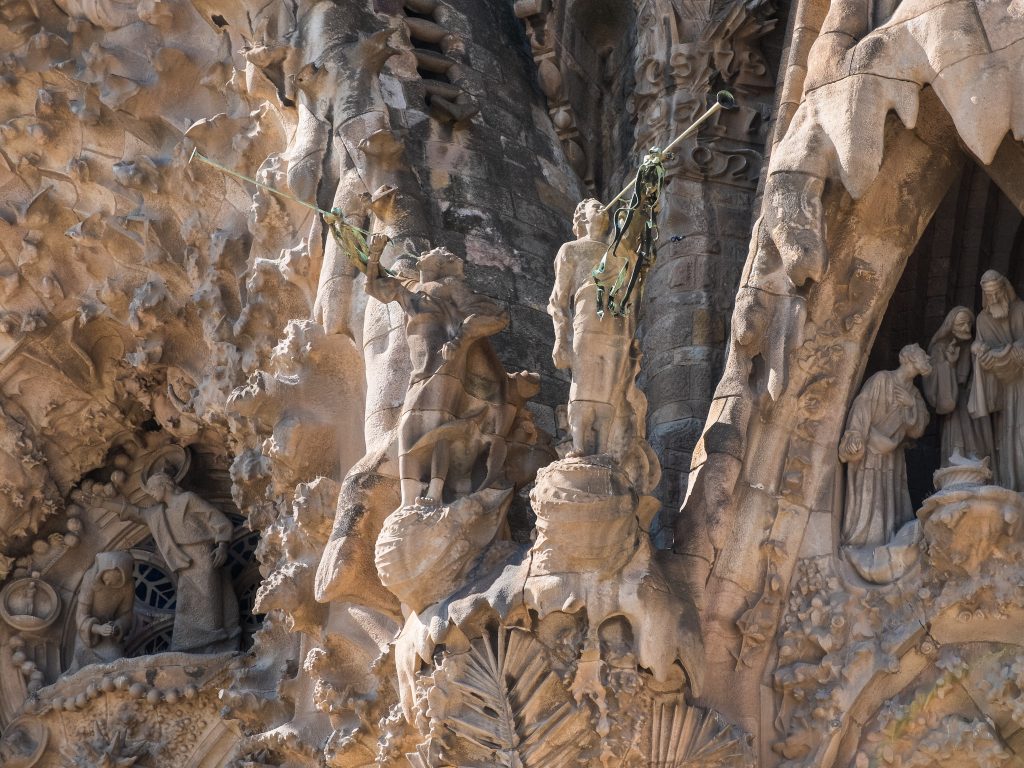
At the bottom of the columns is the carving of a tortoise and, on the other, a turtle, holding the entire weight of the column up. The turtle represents the land, and the tortoise the sea. Both of these animals are unchanging and, as such, are capable of being the foundation upon which this church is built.
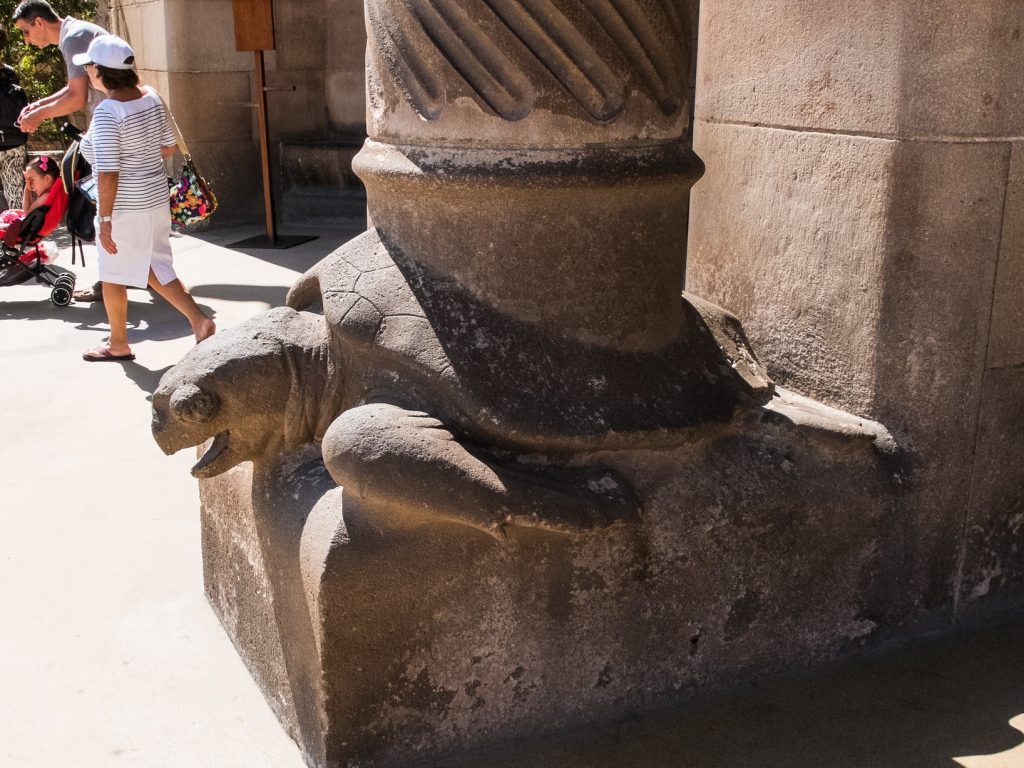
Faith Portico
The last of the tree porticos is on the far right-hand side, called the Faith Portico. This portico is dedicated to the Virgin Mary, yet most of the scenes here actually feature her son when he was a young boy and his life during adolescence.
While centred around Jesus, these scenes show Mary’s faith in God. Imagine being a mother and seeing your son grow up so innocent and kind, all the while knowing he will die for the sins of humanity, and you’ll be the one to bury him. It takes a strong woman to keep faith in this knowledge, and yet she persevered and, not only that, made sure to be the best mother she could be against all the odds. I think everyone can take something from this story into their own lives at times when they feel they perhaps have lost faith in themselves or the direction their lives are going.
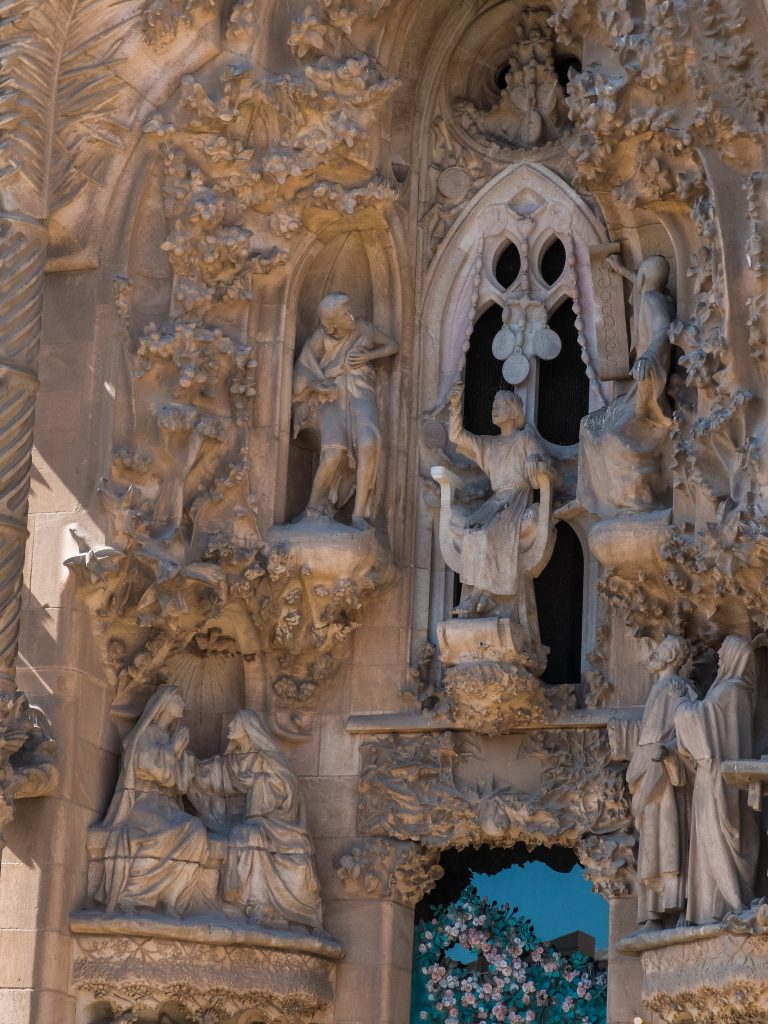
Blessed Virgin’s Pinnacle
At the very top of the portico is the Blessed Virgin’s Pinnacle. The head of the pinnacle is capped with ears of wheat springing forth. These symbolize the bread Jesus shares with his disciples in the Last Supper. Below, in a small hollow cave, is a carving of a hand with an open eye in the centre. This is the symbol of divine providence, which represents God, who can see all and even perhaps influence the destiny of humankind. Vines and grapes intertwine all over this pinnacle, another symbolic element of the Last Supper.
In the centre of these vines is the figure of the Virgin Mary, her hands crossed over her chest and head leaning back, utter vulnerability and trust emitting through her language. Mary stands upon a three-pointed lamp, representing the light of the holy trinity. Below her figure, we can see Saint Joseph’s anagram, another little detail tieing these two people together consistently through the design, even when they are not physically together.
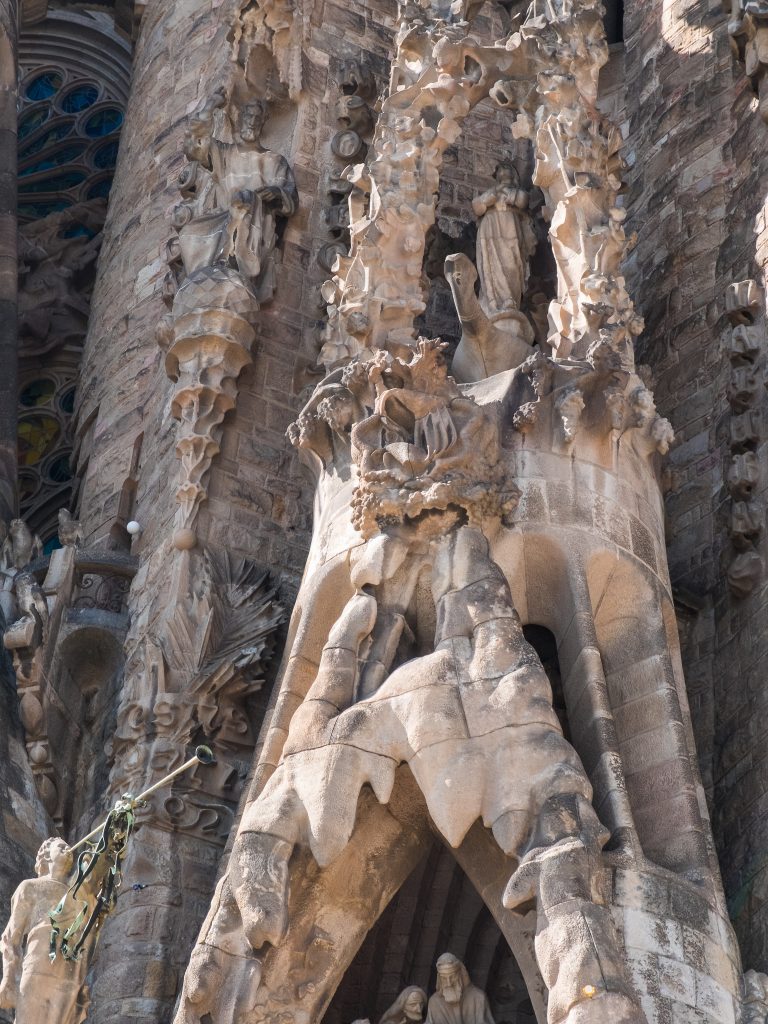
Jesus in Simon’s Arms
In the hollow at the top of the portico is Jesus in Simon’s arms in the temple of Jerusalem. Many parents would bring their children to the temple to be blessed. A bowl is at the bottom of the scene, and within it are two birds. But these are not doves as we’ve seen before, but are pigeons. Every parent needed to bring a sacrifice to the temple for their child to be blessed. Most people would bring a lamb to display wealth, but as Mary and Joseph were poor, they could only afford to bring two meagre pigeons.
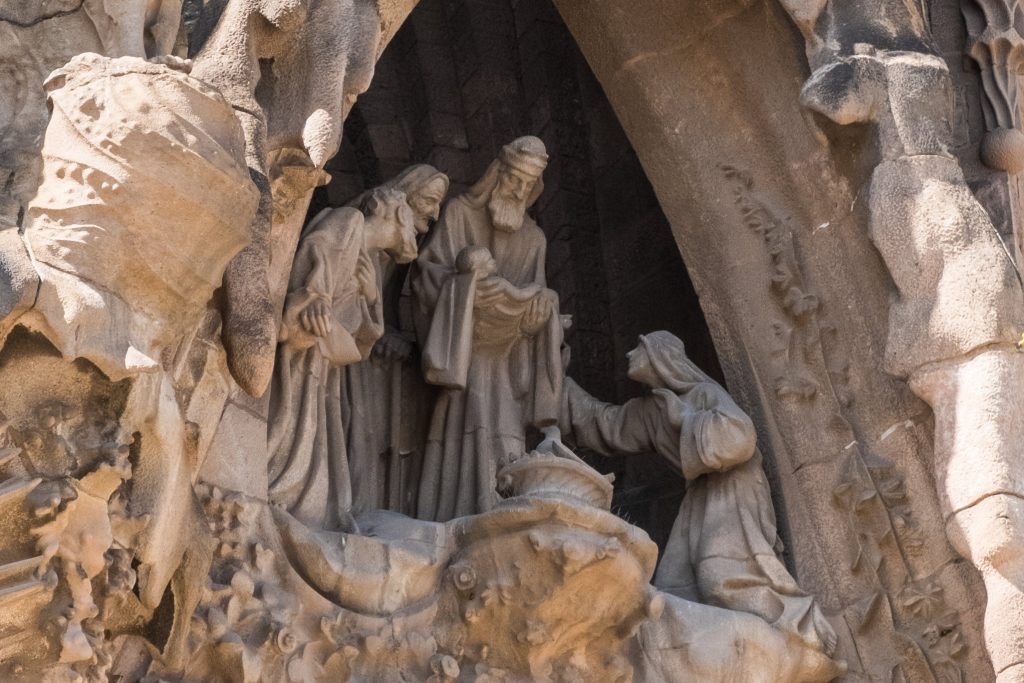
Central Scene on the Faith Portico
Under the vault on the Faith portico is a beautiful rose window made up of multicoloured glass. Looking up from underneath the vault is the figure of Jesus seated in a chair, his hands raised towards the sky. On his left side is Saint John the Baptist. On the right is Saint Zachariah. These two scholars were some of Jesus’ best teachers and would shape how he would preach. Despite being his elders, they are seen here looking at Jesus with admiration and wonder. Below the scholars, right above the doorway, is the symbol of the heart of Jesus, surrounded by thorns and covered in bees who feast on the blood. A morbid foreshadowing of things to come.
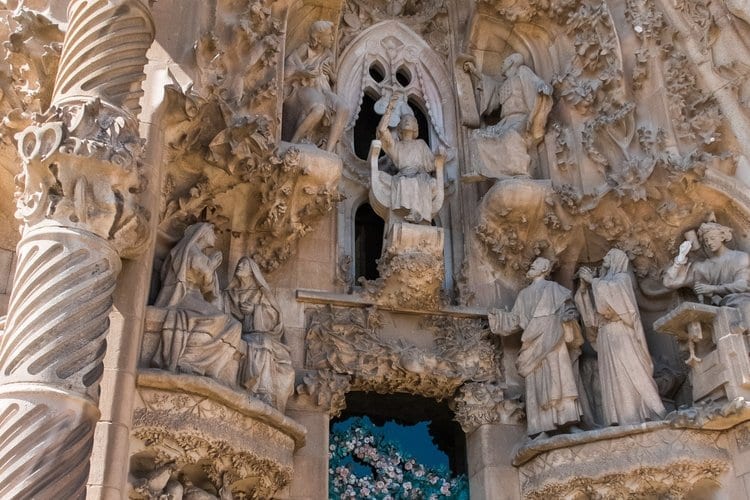
On the left-hand side of the doorway, we can see the scene of the visitation of the Virgin Mary. Here we have Mary, pregnant with baby Jesus, visiting her cousin who at the same time was pregnant with the would-be Saint John the Baptist. In the scene on the right, we find Jesus as a young carpenter at his work table. In front of him are the figures of Mary and Joseph. Their faces are that of surprise, anguish and denial as they learn of their son’s fate for the first time. But Jesus remains unphased, working quietly on his carpentry, his posture slightly slumped, mirroring a more human figure who knows not yet of his divine destiny.
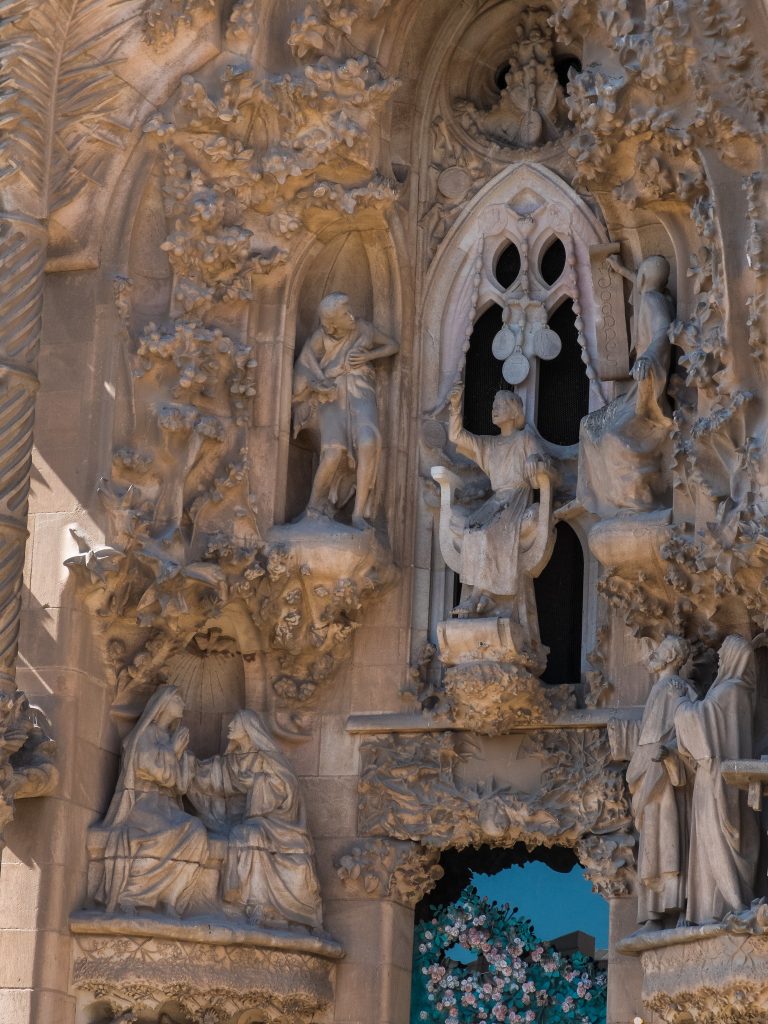
The Spires and Towers
Gaudi desired to make the Sagrada Familiar as the tallest building in Barcelona. He was inspired by stories of architects in medieval times who built their churches as the central figure in the city. These churches needed to be tall as they were often used as meeting points, a guiding light to those travelling into town. Their bell towers signal the beginning of the workday or even warn people of fires, earthquakes or other devastating events. Gaudi wanted to implement this same idea, but just one tower wouldn’t suffice. He decided to far and away exceed anything created for basilicas before.
Gaudi’s design called for eighteen spires, reaching up toward the heavens. The hollow and hole-filled design of the spires makes them look like a sort of beehive or anthill, as the stone’s colour so closely resembles the earth. But the hollow design was actually a form of lanterning, an architectural element that illuminates the church while also giving it enormous height and grandeur.
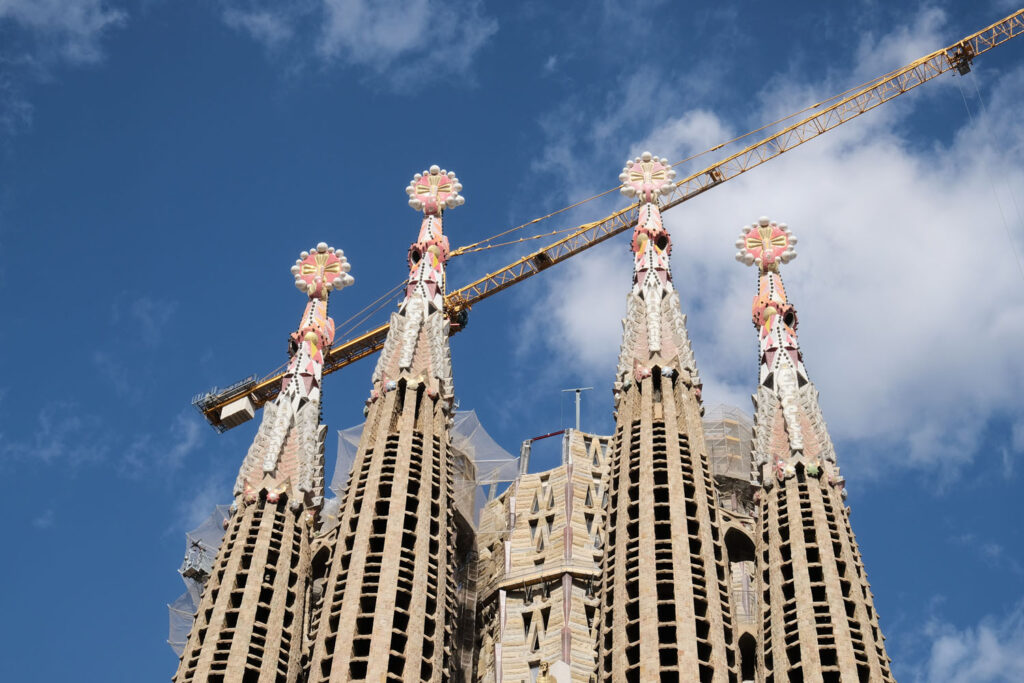
The spires are representative, in ascending order of elevation, of the Twelve Apostles, the Virgin Mary, the four Evangelists and, tallest of all, Jesus Christ. The Evangelists’ spires were designed to be topped by sculptures of their corresponding symbols. A bull for Saint Luke, symbolizing sacrifice, service and strength. An angel stands for Saint Matthew, who represents Jesus’ human Incarnation, who, upon his death, became divine. An eagle sets off to soar in the representation of Saint John, as the eagle symbolizes a figure of the sky and the fact that Christians should look to their eternal fate instead of their mortal one. And finally, we have Saint Mark represented by a lion. Saint Mark’s beautiful gospels were thought to be the “voice of the one who cries in the wilderness,” like the roar of a lion.
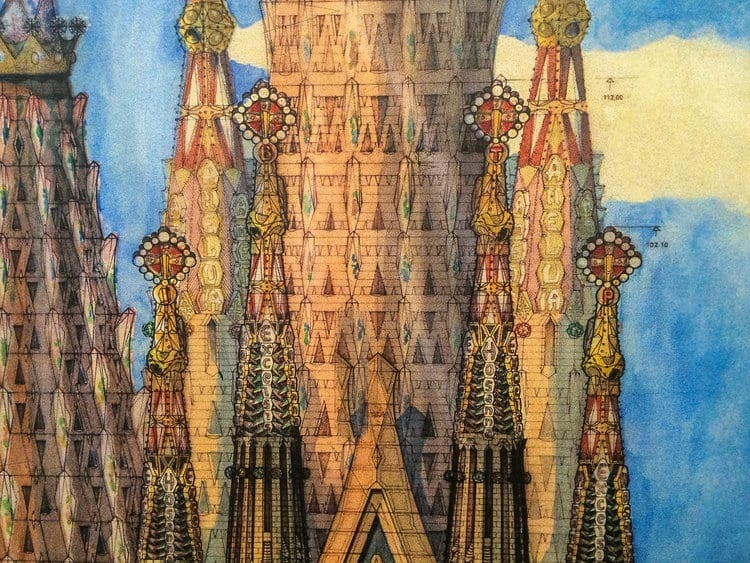
Atop each of the spires along the perimeter of the church, over top of the cloisters, are a set of pinnacles. These are in various shapes, abstractions of elements of the bishop’s attire, such as the mitre, the ring, the cross and the staff. They are all decorated in rich tones of Murano glass which is much stronger than ceramics, so they can withstand the elements up high.
Jesus and Mary Towers
The Virgin Mary tower will be the widest right over the high altar. Her tower is currently finished, but its shape has already been a form of a cathedral. Her tower, once completed, will be crowned by the ‘morning star.’ This star is the guiding light that travellers use to find their way even in darkness, and the star is still visible even when the sun has risen at dawn.
The interior of her tower is made up of a large hyperboloid skylight which brings natural light into the presbytery. The hyperboloid will be covered in white tiles, the colour of purity, looking like a divine cyclone sucking in the light from above. The largest and tallest of the towers, the Jesus Christ Tower, has yet to be built, but once completed will be the most impressive of them all, reaching a height of 172.5 meters, capped with a Gaudí-style four-armed cross. The tower’s interior will act as a giant lantern since Gaudi wanted this part of the church to reflect the phrase Jesus spoke, “I am the light of the world.”
The Cimborio
At the top of the spires, you’ll find elaborately coloured and designed cimborio. A cimborio is a dome or a cupola from traditional Spanish architecture. Gaudi’s cimborio is more sculptural, with images of plants decorating the surface, specifically those plants connected to the Christian faith. We see ears of corn, wheat, cedar and lavender all swirling around. Gaudi also chose plants native to the Mediterranean or that once grew on the site where the church was built. Gaudi used his technique of trencadis cladding to ensure the tops were as colourful as possible so you could see them across the sky from all over town.
The Cloisters
As you enter the Nativity facade, you pass through those large doors and enter the cloisters surrounding the entire church. A traditional cloister was first used in monasteries and was meant “enclosure.” It was a covered walkway for the monks to use as a space of private contemplation. When cloisters were incorporated into cathedrals, they would run along one side of the church.
Gaudi used his cloisters in a revolutionary way; instead of just placing them on one side of the church, he wrapped them around the entirety of the Basilica. This was his solution to create separation or barrier between the church’s interior and the loud and obnoxious outside world. This resulted in a quieter interior and an almost zen-like atmosphere. A conventional monastery cloister would surround a garden. Because the interior here would be the church’s apse, Gaudi made sure that his interior still felt like a garden, like the of Eden. A mythical forest in the centre of town.
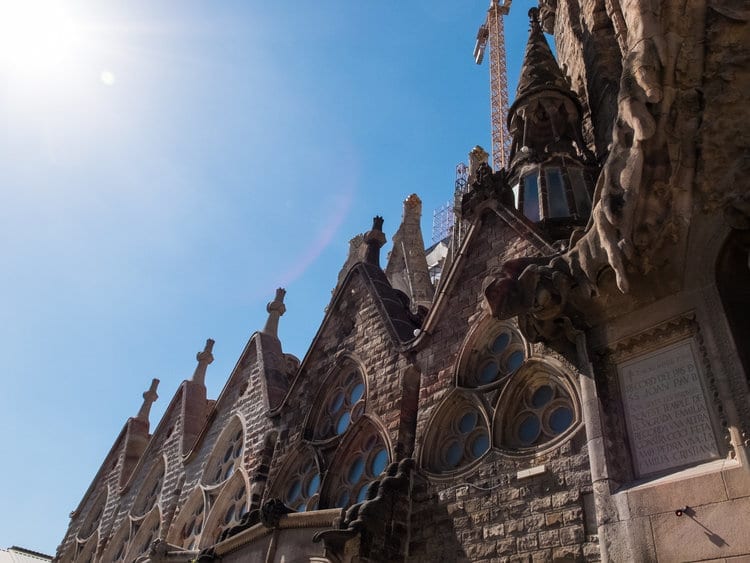
Cloisters and Light
Gaudi wanted to find a way to bring natural light into the interior of the church even though there were no windows that faced directly outside the apse. He did this through his ingenious redesign of the cloister windows. Gaudi went through two different variations in his light experiments. Both of which are still present to this day. The first was designed in 1890 and was based on the three ogival modules inspired by traditional Gothic architecture.
The secondary design done in 1919 was a more modern interpretation of Gaudi’s which looked less like Gothic art and was more inspired by nature. These circular windows, stacked in a triangular pyramid, looked like a honeycomb and fit better with the rest of the naturalist design across the temple. The cloisters also served another purpose. By having this area around the entirety of the church, Gaudi made it so that these galleries could be an area where people could move throughout the church quickly without interrupting the worship that was taking place inside.
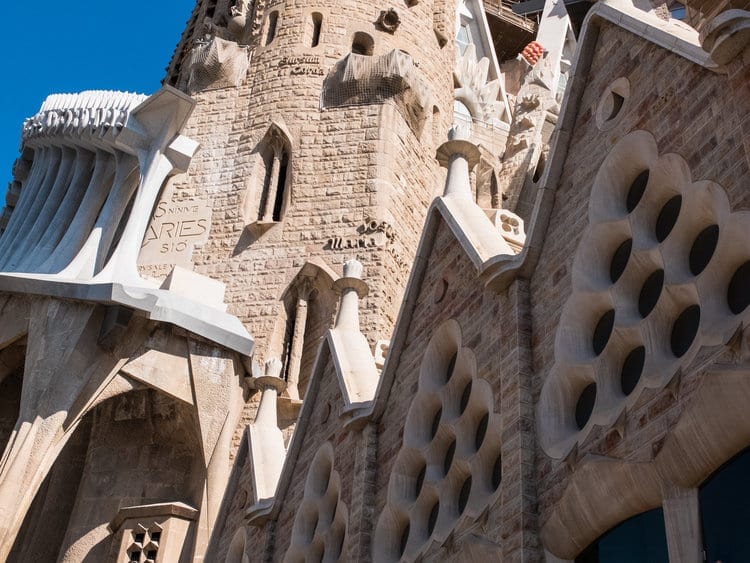
The Bronze floral Doors
To enter the church, we must head back to the Charity portico and walk through the archway. The doors you pass on your way are made from polychrome bronze and designed by various plant species and covers and are ed in highly realistic insects. The paintwork on these doors is breathtaking and an introduction to the colours you’ll be wowed with inside.
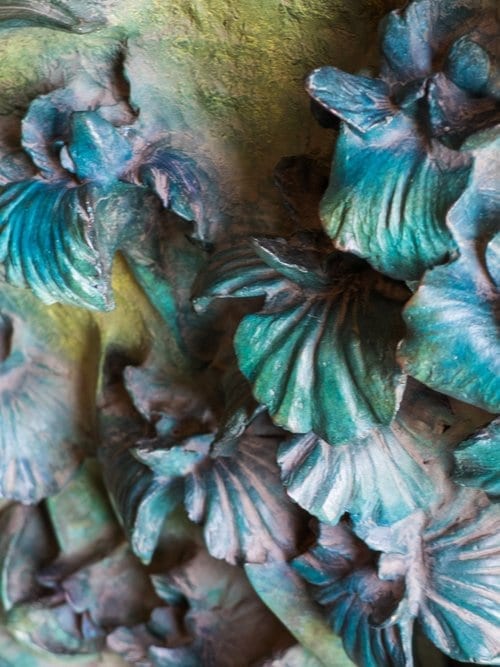
The Rosary Portal
You’ll first pass through the Rosary Portal to enter the church’s interior. This incredible doorway is called the door of Our Lady of the Rosary . In the tympanum above the doorway is the sculpture of the Virgin Mary holding a crowed baby Jesus. Mary also wears a crown, as she is the Queen of Heaven on Earth, but she is also symbolically crowned with an archway of roses on the portal above her. Since the rose is the symbol of purity is almost always hidden somewhere in depictions of the Virgin Mary.
Above this doorway is a cupola lantern which perfectly lets in a ray of light that highlights Mary’s face. This effect is almost too beautiful, and if you didn’t know the cupola was there, it takes on looks heavenly side of the doorways are various sculptures of characters from the old testament.
On the bottom of the arches around the door are scenes dedicated to the theme of temptation. We see the temptation of woman, the death of Judas and the temptation of man. The temptation of man is the most surprising as it is symbolized by a fish-like devil offering a bomb to man. While you might not always associate the devil with bombs, this scene was of particular significance to the people of Barcelona. Bombs were heavily used during the Spanish civil war, and this particular artist was inspired to make this alteration after the bombing of Barcelona’s Liceo Theatre in 1893.
The Interior Apse
The floorplan of the Sagrada Familia is designed to replicate the traditional Latin cross, but Gaudi’s floorplan featured five naves, a large central one and four lateral naves. He also took it upon himself to widen the naves, therein creating an unparalleled vastness of space, which feels impossible to have in such a lavish interior. But with all this space, there had to be structure. Some way to keep the building from falling down without sacrificing that ethereal atmosphere.
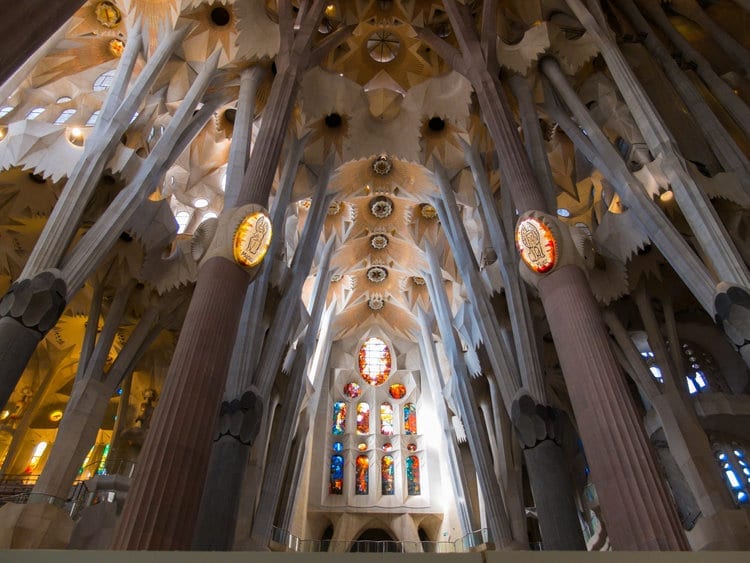
The Arborescent Columns
The interior of the church was meant to resemble a spiritual forest. Gaudi wanted it to feel like a retreat into nature. Gothic churches were revolutionary in creating openness and space; they wanted the interior to feel light and the high ceilings as if they were reaching up toward the heavens. Gaudi once more wanted to take this to the next level. He wanted to incorporate huge stained glass windows on either side, which meant they could not be load-bearing, so that load had to be carried elsewhere.
Gaudi researched for years to develop this new concept he called the ‘Arborescent Columns.’ Inspired by the strength and beauty of large trees, the columns tilt slightly about their height so they can withstand the roof load. They also split off in two directions, like the branches of a tree and also like a flying buttress to better support the vaults. At any time, you expect to see birds flying from branch to branch, making a nest for themselves. And what better place to do it?!
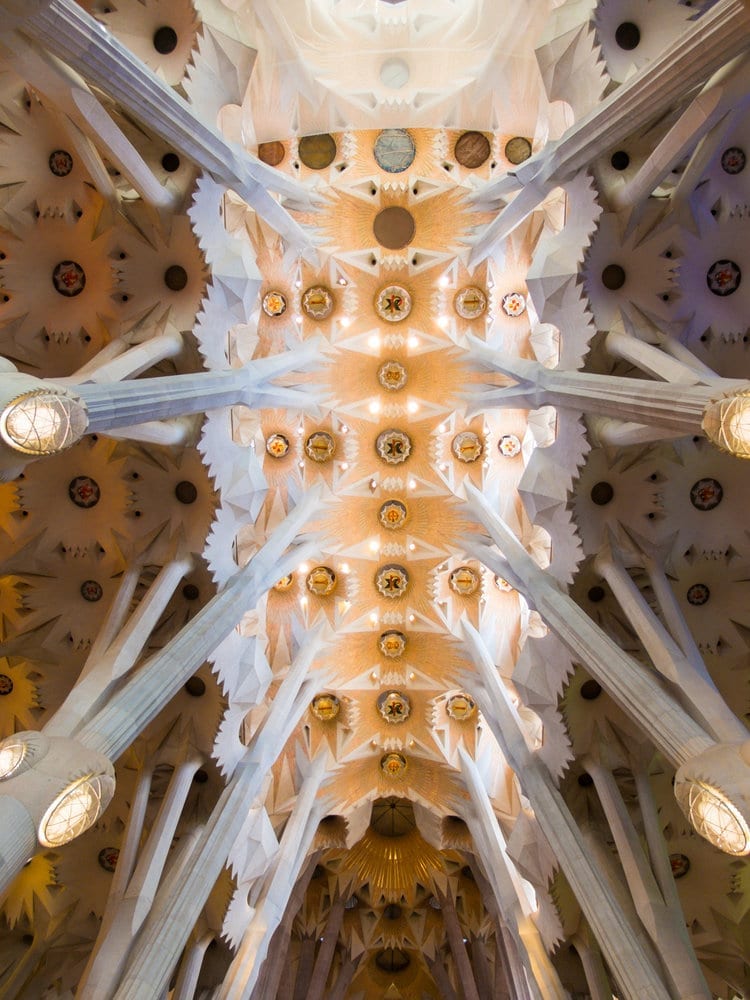
36 Tree Columns
There are 36 columns in total with different heights and widths. The variation of these sizes makes them seem more unique and less man-made. Four materials were used to create the columns; porphyry, basalt, granite and Montjuic stone. The Porphyry columns support the vaults over the crossing and are the widest in diameter. They are the red-coloured columns which contain the Evangelists’ lights. The basalt columns have ten sides and are one of the most durable materials. The granite columns are blueish-grey in colour and are only eight-sided. The final columns are made from Montjuic stone and are the thinnest.
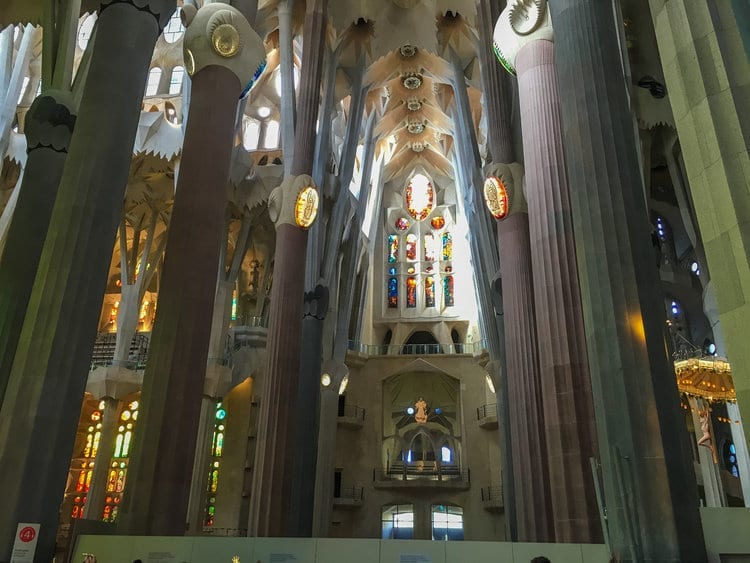
Gaudi combined classical Gothic architecture and Catalan art to create these star-like vaults on the roof, which light could easily pass through. The stars are formed by combining concave and convex hyperboloid shapes, which are systems used to disperse light and spread out the roof load of the stars also closely resemble the form of palm leaves, a powerful symbol in Christianity. Each vault centre is filled with a light diffuser decorated with colourful stained glass in various Christian symbols.

Natural Light
Light is one of the strongest symbols of faith in Christianity, so it was crucial to Gaudi to bring as much natural light as possible, the light of God, into the Basilica. Gaudi developed a new way of creating stained glass, comprised of three panes resulting in a mixture of tones and colours to cast a magical glow into the nave. The leading artist who created these windows was Vila-Grau. Vila-Grau used curved shapes to create abstract forms and ensured that the warm and cool tones were kept separate, resulting in this consistent light flow.
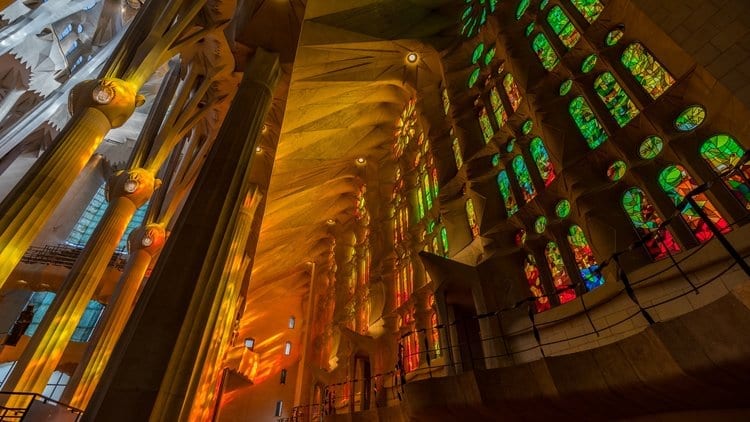
The Evangelist Capitals
Four Porphyry columns are capped with the Evangelists’ symbols, two on each side of the transept. The capitals are decorated with tetramorphs , the four angelic beings from Babylonian symbolism, which describe the vision of the Hebrew Prophet Ezekiel of the Evangelists. “As for the likeness of their faces, they four had the face of a man, and the face of a lion, on the right side: and they four had the face of an ox on the left side; they four also had the face of an eagle.” These capitals are lit from within to ensure they are always illuminated even when there isn’t any natural light.
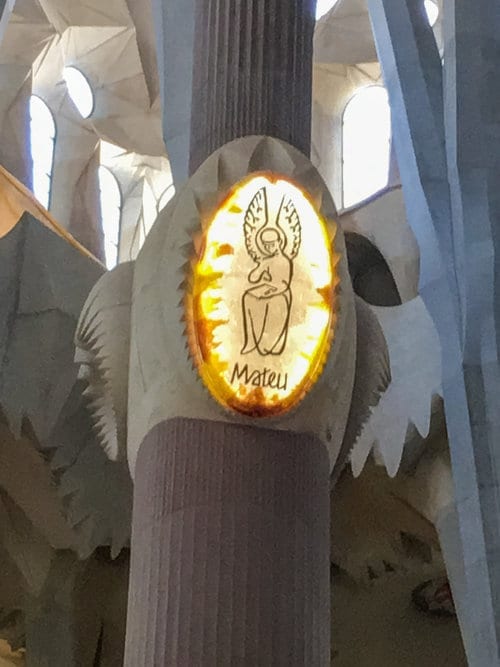
The High Altar
When you enter the church, before looking up (although I know that’s really hard), take a look at the flooring. The shimmery golden tiles are accented with two thick red lines. One of the lines symbolizes the ‘Path of Humanity,’ which runs from the Glory facade to the apse, and the ‘Path of Jesus Christ,’ which runs from the Nativity to the Passion facade. Where the two lines meet is where we find the high altar. The meeting of the divine and the human in one place here inside the church. The high altar has a ceiling two meters taller than the rest of the nave to give it that little extra touch of gravitas.
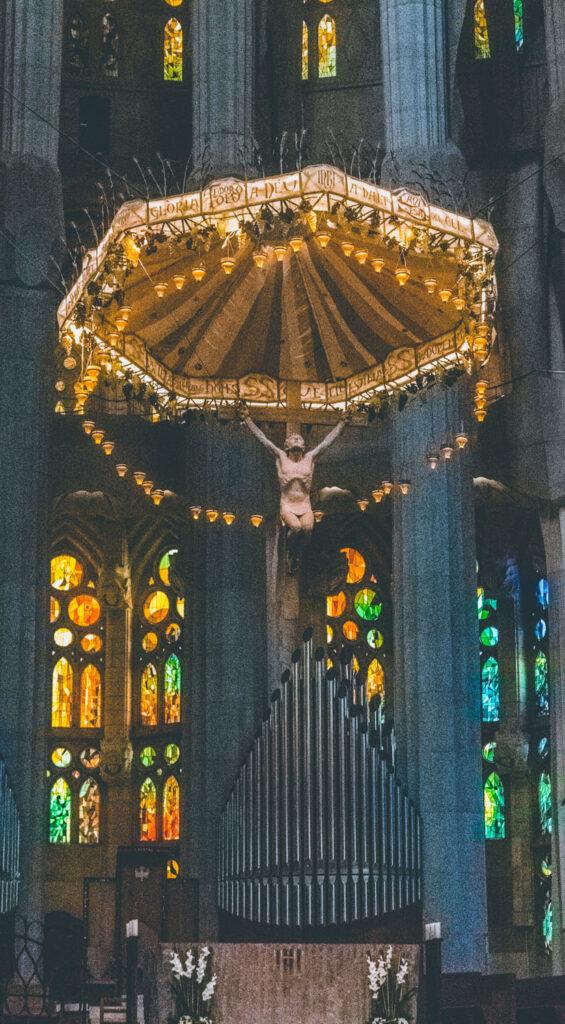
Over the high altar, we find the incredible sculptural masterpiece called a baldachin . A baldachin is a large canopy in a heptagon shape with seven edges, traditionally placed over an altar. These sever corners represent the seven gifts of the Holy Spirit; wisdom, understanding, counsel, fortitude, knowledge, piety and fear of the Lord. Fifty little hanging lights illuminate the rim of the canopy. Around the rim springs grape vines and wheat, the symbols of the Eucharist. A ribbon around the baldachin writes out the Prayer of Glory in back-lit red and Gaudí-style lettering.
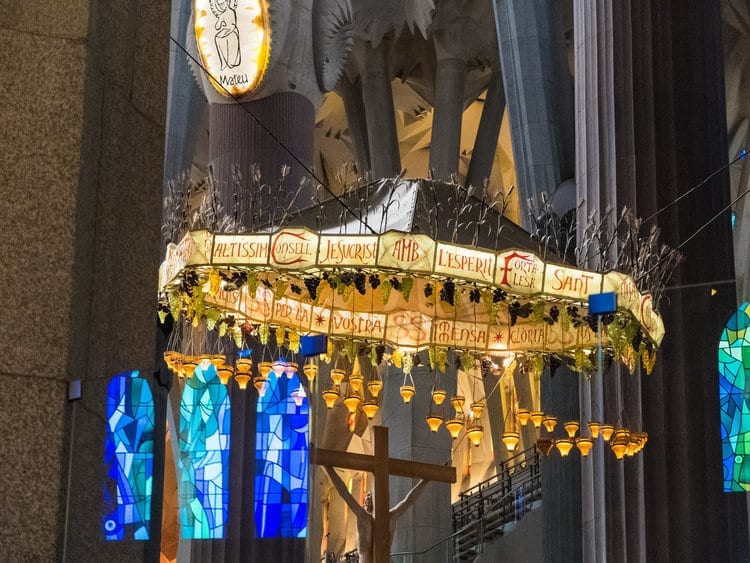
Saint Joseph Transept
Located on the Nativity side of the church is the Saint Joseph Transept, presided over by a large sculpture of Joseph himself. Joseph stands there prominently with a sceptre of lilies in his hand. Lilies represent his holiness and his celibate marriage to the Blessed Virgin. The walkway above the transept is made of dozens of Roman columns and is an easy way for the clergy to get around the church without interrupting the service. The stained glass windows featured on this wall are made of cool tones, and the morning light pours through this portion of the church.
One interesting aspect of studying stained glass is that the colours become denser and denser as we descend from the top down, letting in less and less light. This is so that the light is the brightest at the top, where you’ll find the divine, and lower to the ground, where we have humanity and slightly less light, creating a perfect space for meditation and reflection.
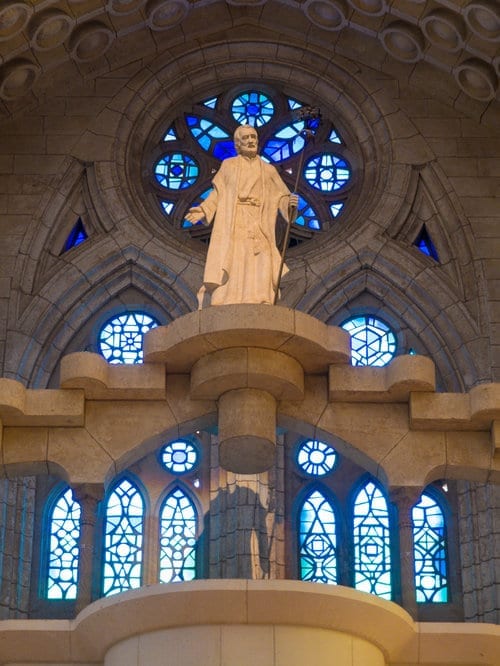
On the opposite side, facing the Passion Facade, is the Virgin Mary Transept. In the centre is the figure of the Virgin Mary under a simplistic, geometric star-shaped vault. Behind her is a beautiful example of abstract stained glass made by Joan Vila-Grau entitled ‘The Resurrection.’ This side faces the setting sun and is coloured with entirely warm tones, warm tones which make the heart feel full and content, expressing hope upon Jesus’ Resurrection.
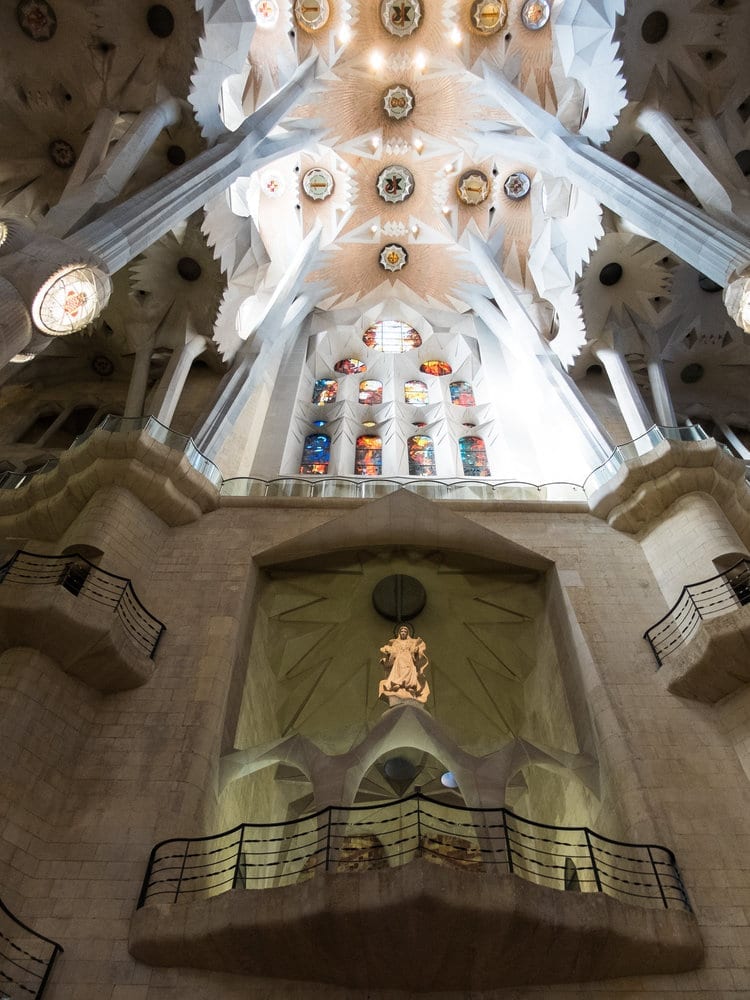
The Apsidal Chapels
The apse has seven chapels dedicated to the seven gospels of Saint Joseph. These chapels are lit from above and by impressive stained glass windows. In between these panels are the adorable carving of angel heads peeking out from the walls.
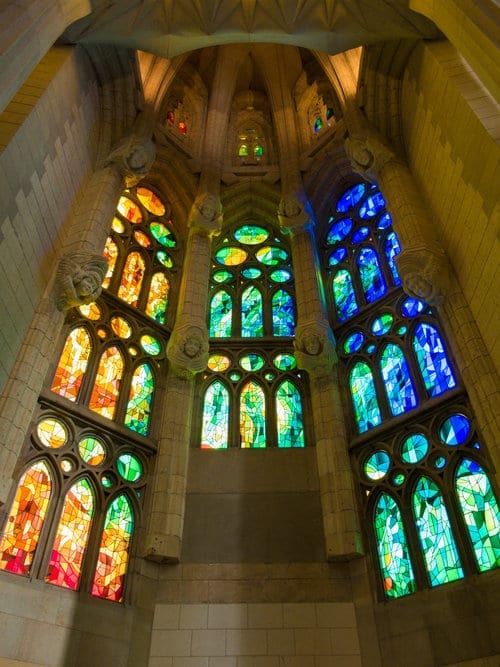
The Great Doorway
This entrance, called the Great Doorway, will eventually be the main entrance into the church once the Glory facade is finished construction. The two solid bronze doors will open out into the facade, weighing over two thousand kilos! The designer of these doors is the same one who made the Passion Facade, Josep Maria Subirachs . The doorways are inscribed with the words “Give us this day our daily bread” in fifty different languages. Above the door is the abstracted sculpture of Saint Geroge, the patron saint of Catalonia.
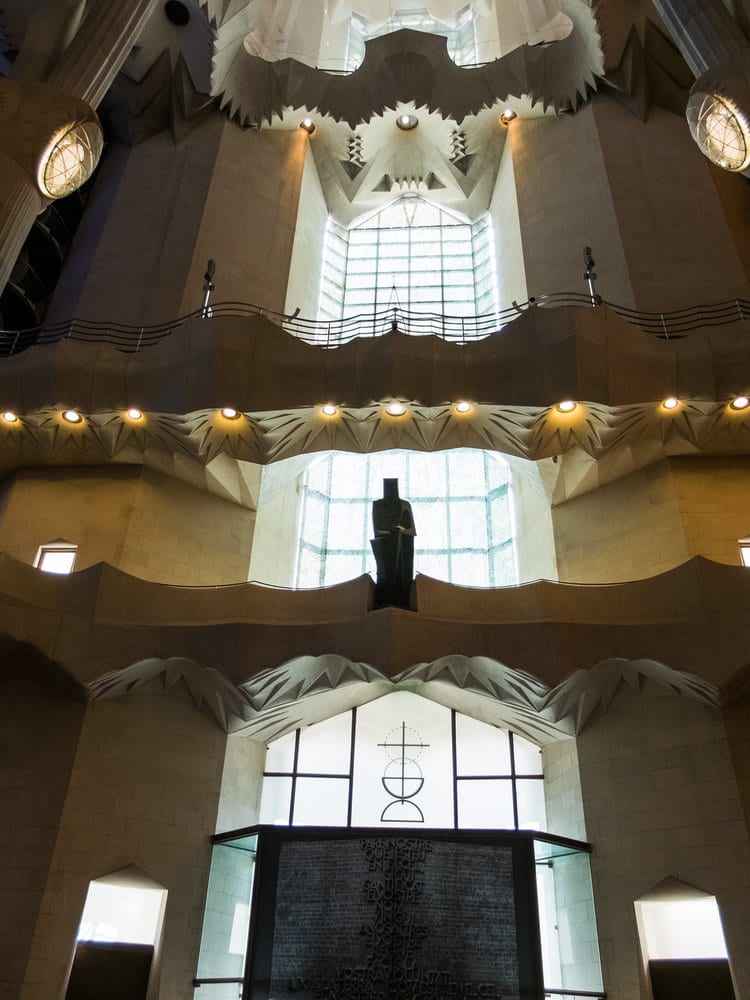
The Choir Galleries
Above the nave is a separate space that houses the choir during church services. This area can hold over 1000 singers since Gaudi wanted their voices to fill this enormous temple. Gaudi thought the importance of acoustics in the building to be of the utmost importance as he loved music so much. It was one of the few ways he could unwind and relax. The hyperbolic vaulting he used throughout the church was made to reverberate the sound throughout the church in a harmonious way and provide light.
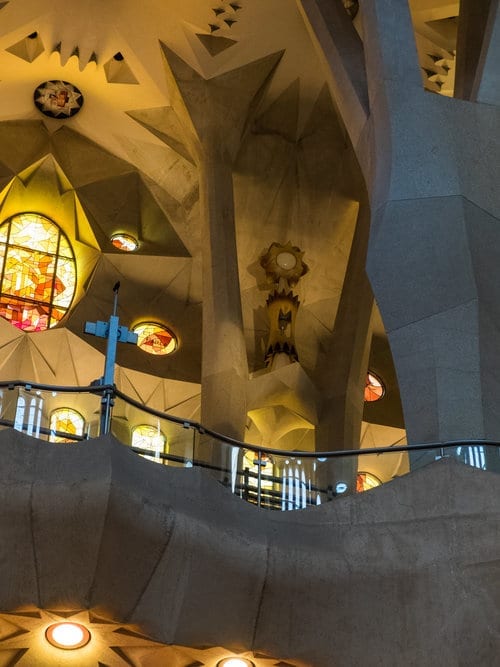
The large pipe organ looks almost holographic in certain lights and has over 1,492 pipes. And what a sound it makes when played. Gaudi wanted this organ and the music of God it created to fill the nave like the ocean. Washing across the worshippers and visitors alike.
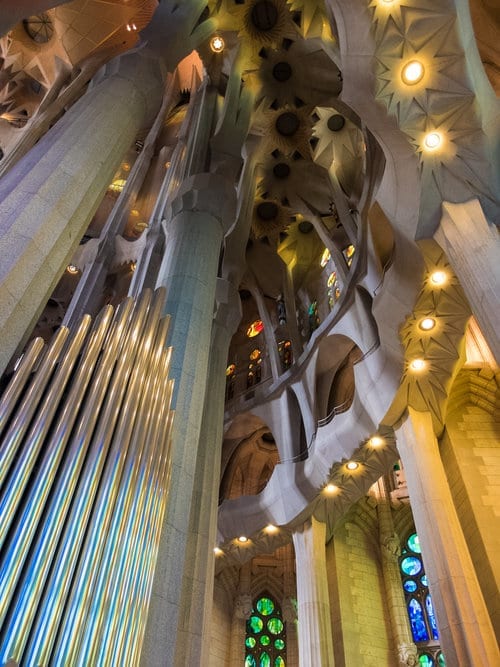
Winding Staircase
Gaudi didn’t ever want to break up the natural movement of the Basilica. No straight set of stairs would be acceptable. So Gaudi created these sets of winding staircases which the clergy could use to access the upper levels. The staircases are almost completely open, with some circular cutouts, similar to those in the cloisters, to ensure they are perfectly lit without artificial light.
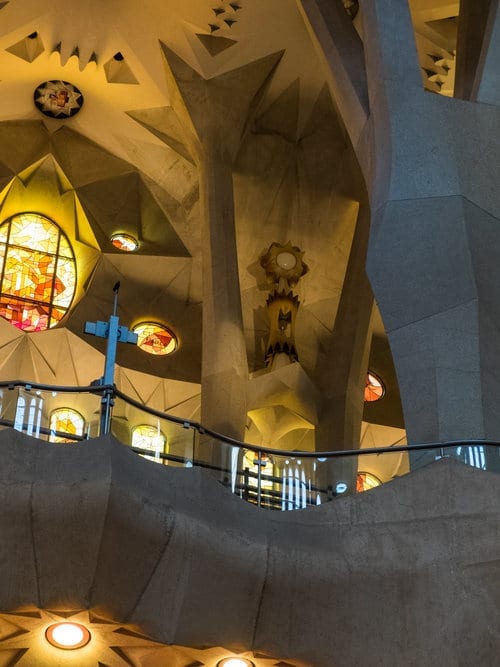
As you walk along the back of the nave, behind the altar, be sure to look down and see if you can peek into the small peepholes which open up into the crypt. Head down to see the interior of this hidden part of the church. The crypt, located under the nave and high altar, holds 12 chapels. The roof of the crypt is supported by 22 ribbed cross vaults, each decorated with shimmering keystones. Some of the keystones are adorned with scenes from the bible. The central keystone with the gold-leafed carving of Mary’s Annunciation is the most impressive. The bright gold brings the smallest details to life, making this image shine like a star underground.
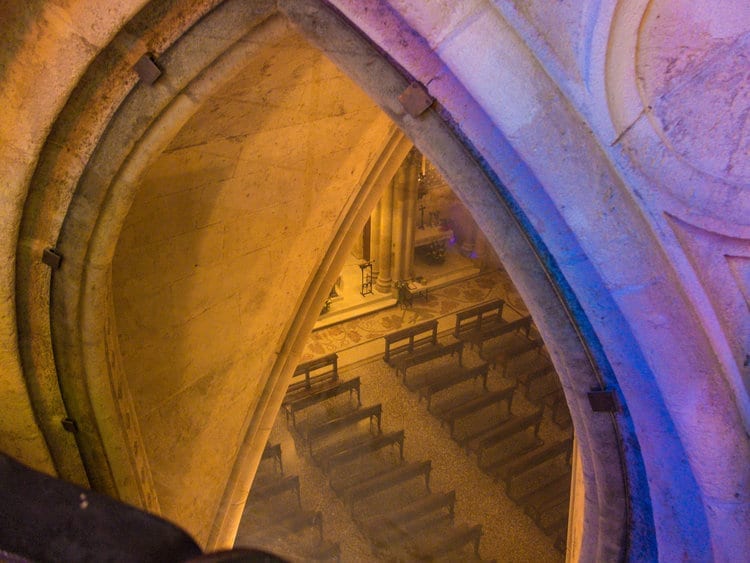
Chapel of Our Lady of Mount Carmel
You’ll find the Chapel of Our Lady of Mount Carmel inside the crypt. This chapel is of particular significance since it is where you’ll find Gaudi’s final resting place. Located on the far left-hand side of the front wall, his tomb is presided over by the Lady of Mount Carmel. Gaudi is laid to rest under a simple, jet-black tombstone.
Gaudi made it his mission to bring natural light into the otherwise darkened crypts. And he did so through those small holes in the vaults which bring light in from the nave. He also made sure to include a lot of vibrant stained glass. This created a feeling of lightness and brightness despite being underground. It is unlike any other crypt I’ve visited around the world. The stained glass within the crypt is decorated with images of angels, another interesting juxtaposition for a crypt since angels are generally found in the sky, whereas these ones are found buried under the foundation.
View this post on Instagram A post shared by José Luis Rodríguez Pineda (@joseluis661959)
The Passion Facade
The final portion of the tour of the church is the Passion Facade. This facade is located on the side of the building where the sun sets. The darkness reflects the ultimate sacrifice and death Jesus would incur. Compared with the ornate, natural forms of the Nativity Facade, the Passion Facade is gloomy, stark and restrained. Gaudi made sketches for this part of the church when he fell ill with a terrible sickness and almost passed away. This illness was the closest to death Gaudi would ever come since his eventual death would sneak up on him. During this sickness, he was consumed with fear. And he poured all these emotions into the design of this part of the temple.
While Gaudi died long before this part of the church began construction, architect Josep Maria Subirachs took up his mantle and made it his mission to create precisely what Gaudi had envisioned. Subirach’s figures are inspired by expressionism, in contrast to the realistic figures on the Nativity portal. There are over 100 figures depicted, grouped into 13 different scenes. They rise upwards in an S-shape, starting, in chronological order, with the last Supper and ending in the crucifixion.
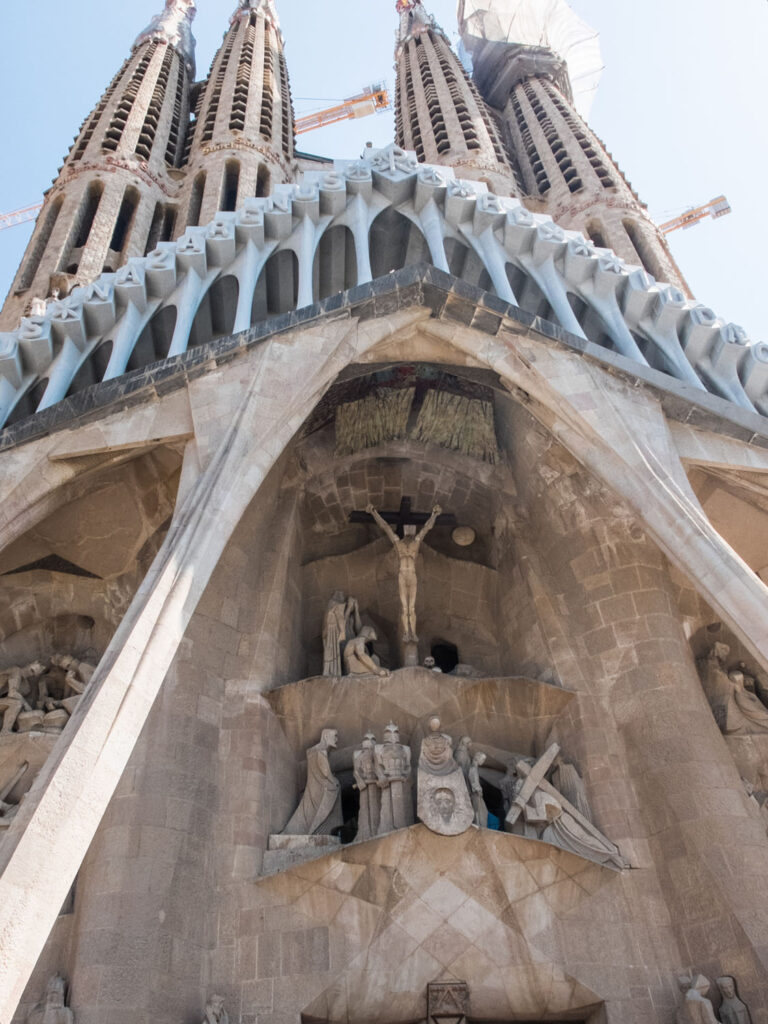
Capping the facade is the pyramid-shaped pediment. This pediment is formed with eighteen bone-shaped pillars, which symbolize those who died. The columns of the Passion Facade reach out towards the street. Unlike a regular column which just goes straight up, they are placed at an angle. Seemingly drawing the viewer in from the outside.
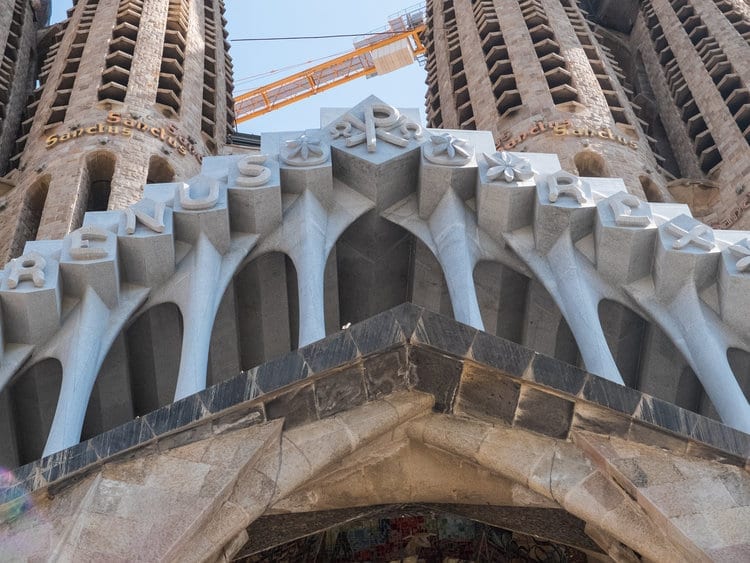
Last Supper
In the bottom left corner, we see Subirachs’ interpretation of Jesus in the Garden of Gethsemane during the Last Supper. All the faces we see here are gaunt and abstract. They seem less human, and each one appears to have an expression of sadness on their face. Jesus turns to his disciples to explain what will happen as Judas is off to the side, accepting the blood money for betraying his friend.
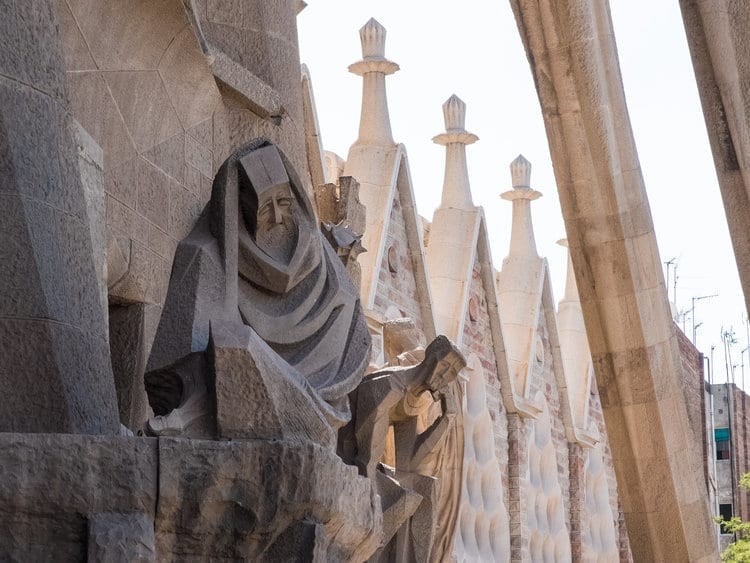
The Kiss of Judas
We then move to the scene where Juda kisses Jesus, indicating he is the man whom the Roman soldiers must arrest. In the bottom right corner of this scene, you’ll see the snarling face of a snake. The snake represents the devil as this reptile is regarded as one of the lowest terrestrial animals, closest to the devil’s lair. Besides the two men is a set of numbers on a grid called the ‘magic square.’ The magic square features a collection of numbers which, when added either along one row, one column or diagonally across, always add up the same number. In this case, the number is 33. 33 is the age at which it is thought that Jesus Christ died; it also contains the number 3 twice, which is the symbol of the holy trinity.
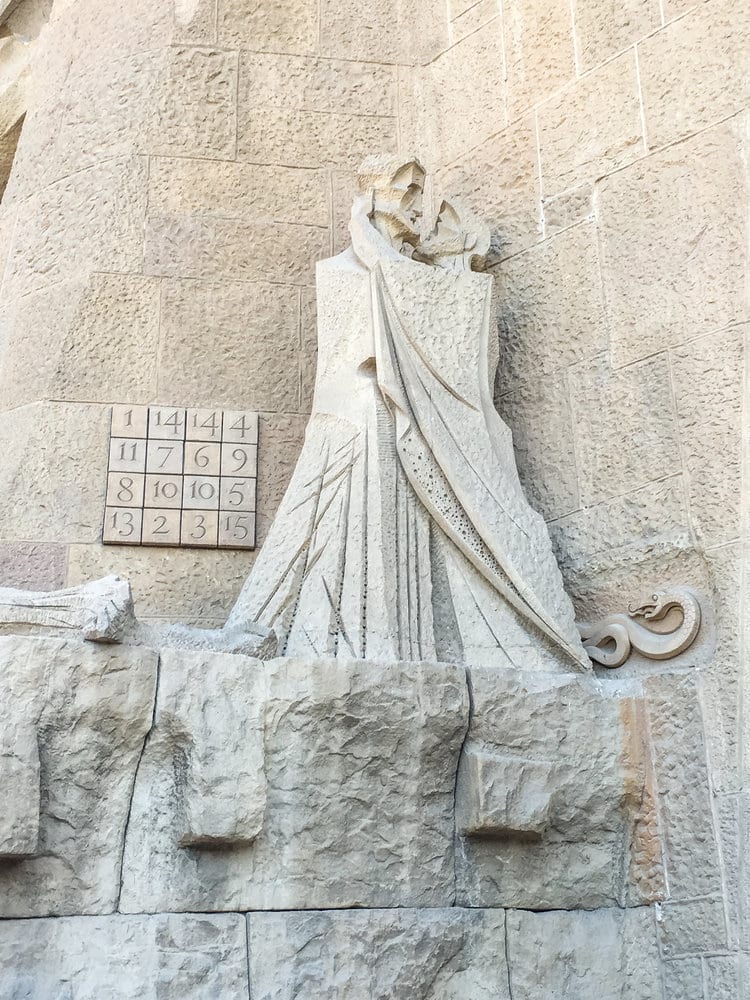
The Flagellation Column
On the main level, in the centre, we have the Flagellation Column. Bringing this scene almost at eye level with the visitors is a critical choice and, once more, brings humanity back to this otherwise godlike man. Everywhere else where Jesus is depicted, he is within a group, but here he is totally alone. An interesting detail is the three steps which lead up to the column, symbolizing the three days between Jesus’ crucifixion and the resurrection. Subirach used travertine marble to carve the column, the same stone used in all the buildings in ancient Rome.
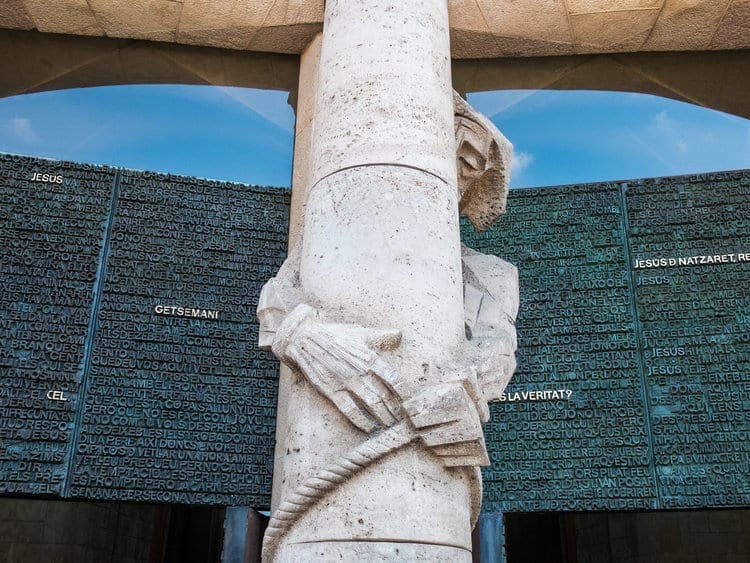
The Bronze Doors
Three broad sets of bronze doors are set behind and on either side of the Flagellation Column. On the right, we have the Gethsemane door; in the centre is the Gospel door and on the left is the Coronation of Thorns. The main entrance used today into the church is through the Gospel door. This door contains thousands of raised letters with passages from various texts relating to the last days of Jesus’ life.
The Gethsemane door looks almost like a sketchbook. It combines text and images relating to the prayers Jesus’ made in the Garden of Gethsemane, pleading for God to change his mind and save his mortal life. The Coronation of Thorn’s door has two main scenes. One of the scenes depicts the soldiers presenting Jesus to Herod and Pontius Pilate and being crowned with thorns. The top scene is of the humiliation of the soldiers who tortured Jesus on the way to the cross.
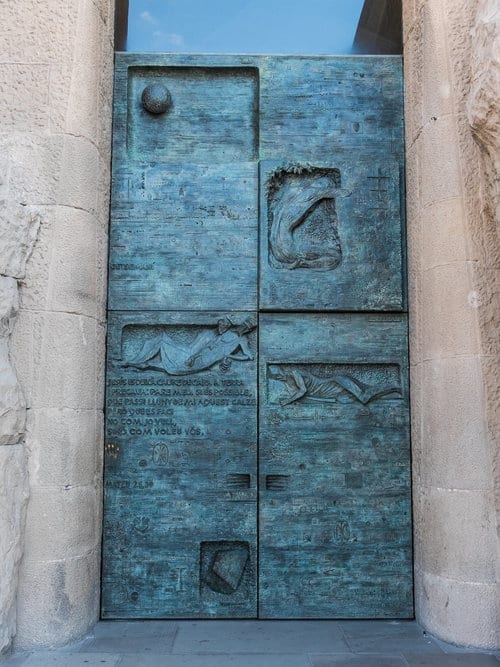
The Denial of Peter & Ecce Homo and the Trial of Jesus
This sculpture depicts the three times Peter denied he knew Jesus, represented by three women. He wears a large sheet, a symbol of cowardice. In the next scene, we see Pilate presenting Jesus to the people. In the final scene, we see Pilate washing his hands as he announces to the crowd, “I am innocent of this man’s blood; see you to it.”
The Three Mary’s and Simon Cyrene
In the next vignette, we see the three Marys; The Virgin Mary, Mary Magdelene and Mary of Cleophas. On the ground is the fallen form of Jesus, and the man carrying the cross is actually Simon Cyrene, who helped Jesus take the cross to the sight of the crucifixion. It is thought that this man showed sympathy for Jesus as he walked, so the soldiers forced Cyrene to carry the cross, another example of the soldier’s cruelty. Now, Simon Cyrene is considered the patron saint of passersby.
Veronica and the Evangelist
Over the Gospel door, we find the scene where Jesus falls again. A woman named Veronica bends down to brush the blood off his face with a cloth, and when she removes it, the face of the Messiah is imprinted on it. The carving of Jesus’ face on the cloth is masterfully done, and no matter where the viewers go, Jesus’ eyes seem to follow. To the left of the group, you’ll see the legionnaires whose armour was made in the shape of Gaudi’s famous chimneys from Casa Milá, a little reference to Gaudi’s history.
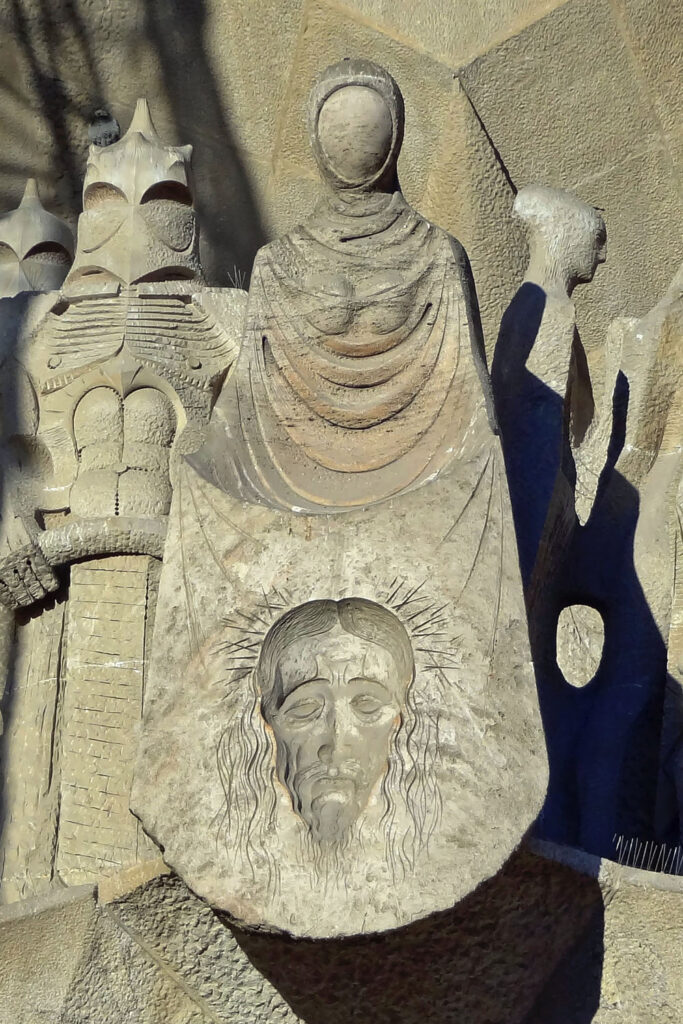
Saint Longinus
The figure to the right of Veronica is a Roman soldier on horseback. This is Saint Longinus, who was a Roman general that stuck a spear into Jesus. Legend has it that Longinus was half blind, but when he speared Jesus, a drop of blood spurted into his eyes, and they were healed. Upon this miraculous healing, Longinus repented of his sins and converted to Christianity.
Soldiers Player Dice
We have a small group of Roman soldiers to the left of the crucifixion scene. They can be seen playing a dice game. The victor of this game would win Jesus Christ’s clothing and possessions. A heartless moment but another depiction of the cruelty of man.
The Crucifixion
The top of the facade is dominated by the form of Jesus Christ crucified on the cross. He is tied to a cross composed of two iron beams. The iron beam meets to form the shape of an “I.” This is thought to recall “INRI,” which in Latin stands for ‘Iesus Nazarenus Rex Iudaeorum’ meaning ‘Jesus of Nazareth, King of the Jews, something which they nailed over Jesus on the cross as he lay dying. At his feet is the sobbing form of Mary Magdalene, while the Virgin Mary stands to the side, her face in her hands, consoled by St. John. At the base of the cross, we can make out a skull symbolizing Jesus’ final death. In the upper right corner, we can make out a full moon, as it is said that the night he died, there was a full moon.
To the right of the Crucifixion scene, we have the burial of Christ. In this sculpture, we see Joseph of Arimathea and Nicodemus preparing and wrapping Jesus’ body to make it ready for the tomb. The image of Nicodemus is actually a self-portrait of the sculptor Subirachs. In the background is the Virgin Mary with an egg on her head, symbolizing the resurrection.
The Passion Vaults
Under the vaults of the Passion’s portico, when you look up, you’ll see a torn cloth hanging in front of a brightly coloured mosaic. The enormous torn fabric acts almost as a type of baldachin hanging beneath the cross. In the Temple of Jerusalem, there was always a large cloth that separated the holier areas of the temple from the ordinary people. At the very moment of Jesus’ death, it was said that this cloth split in two, bringing together common people and God as one. The glasswork is Venetian and contains texts and imagery relating to the resurrection. Unlike the rest of the facade, which is bleak and monotonous, this hidden bright spot is representative of the hope that Jesus’ resurrection gave the people, always present but hiding in the darkness.
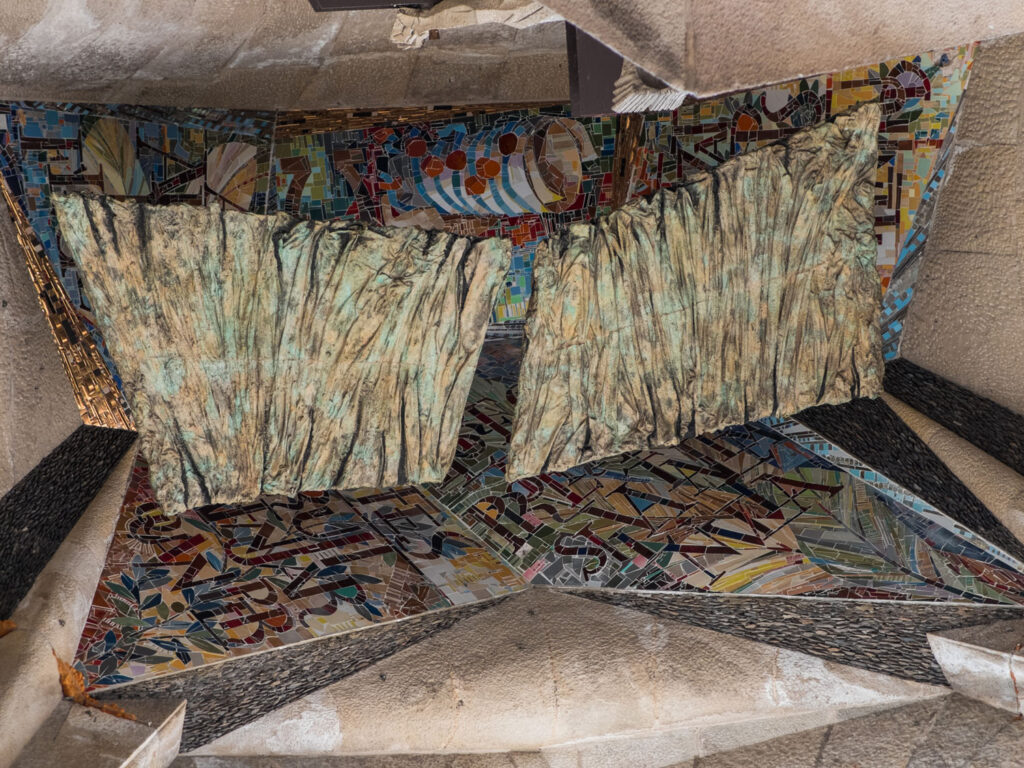
The Glory Facade
The Glory facade is the one part of the church which has not begun construction. This side faces the midday sun when the sun is the brightest and therefore exemplifies the idea of Glory and Hope. The design of the Glory facade is made up of a series of large lanterns and a grouping of fluffy white clouds. The three types of clouds represent the Holy Trinity: the Father, Son and Holy Spirit, each inscribed with words of prayer. By entering this doorway, worshippers will have a sense of movement through the earthly plain into the divine heavens.
The Schoolhouse
Outside the Passion, the facade is a small building, a recreation of the 1909 original, which once served as the children’s schoolhouse. During the Basilica’s construction, there were so many workers that they needed a dedicated school to cater to their children. Gaudi made it his mission to educate these kids and create a beautiful place for them to do it. You can enter the old schoolhouse, study the Catalan vaulting technique he employed here, and study the classroom’s various details. You can even see some of the things the children studied during their time here.
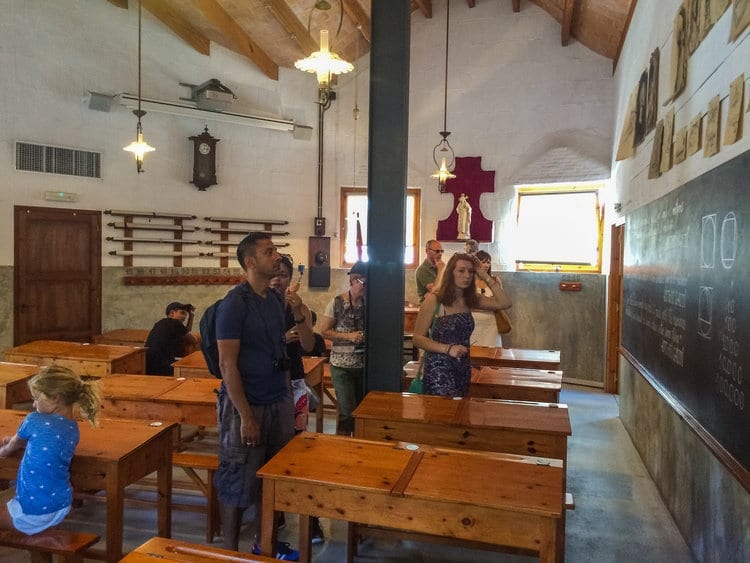
The Gaudi Museum
Located in the basement of the cathedral is the Antoni Gaudi Workshop and Museum. Although many of the original documents and plans were destroyed when a bomb went off during the Civil War, this newly created space is where the city has taken it upon itself to conserve, restore and put on display pieces of the history of the construction of this church. You can find drawings, period photographs, ceremonial furniture and several scale model copies of the originals. There is also a model of the original workshop where Gaudi would spend all this time.
If you’ve made it all the way through, I commend you and know that I appreciate the time you took to understand the immense amount of history, art and cultural values instilled in this incredible temple. I genuinely wish I could spend every day here, and I hope your time visiting this space is just as magical as mine was.
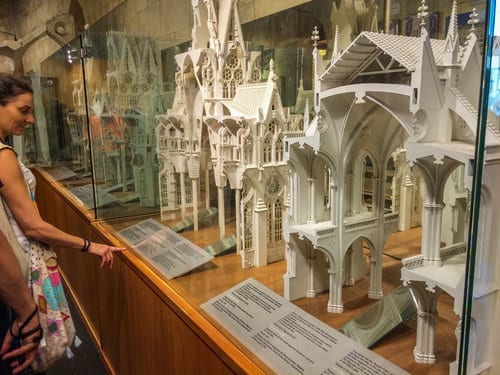
Have you been here before? What was your favourite thing to see? If you’re on your way, let me know what you’re looking forward to the most.
Happy Travel Adventurers
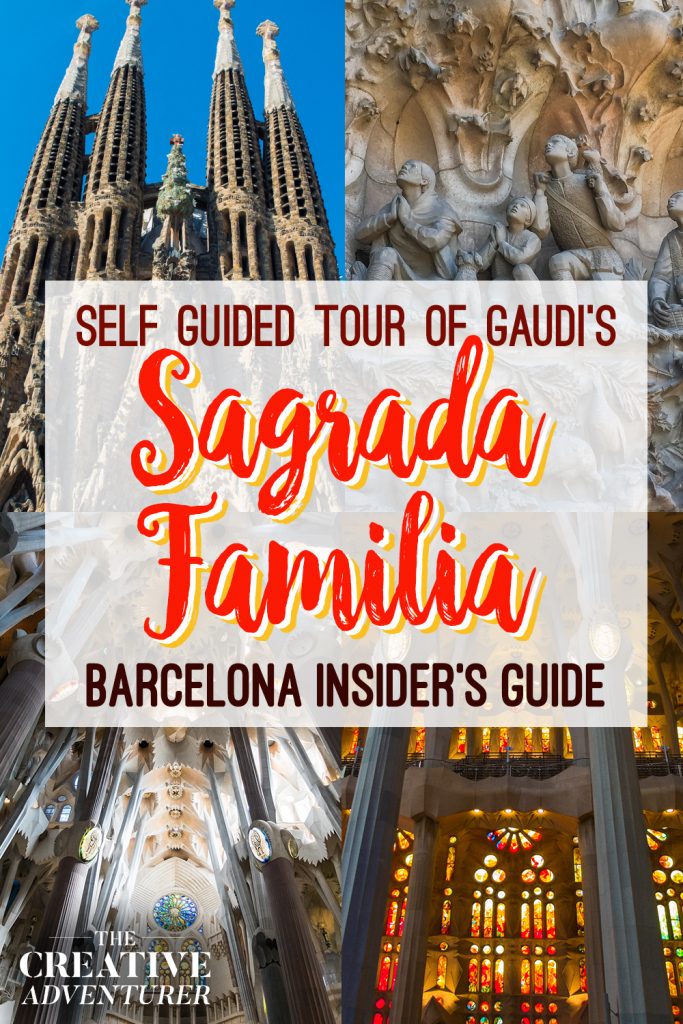
« The 11 Best Instagram-Worthy Spots in Harajuku!
The ultimate highlight tour of la sagrada familia, an insider’s guide to barcelona », you may also like.
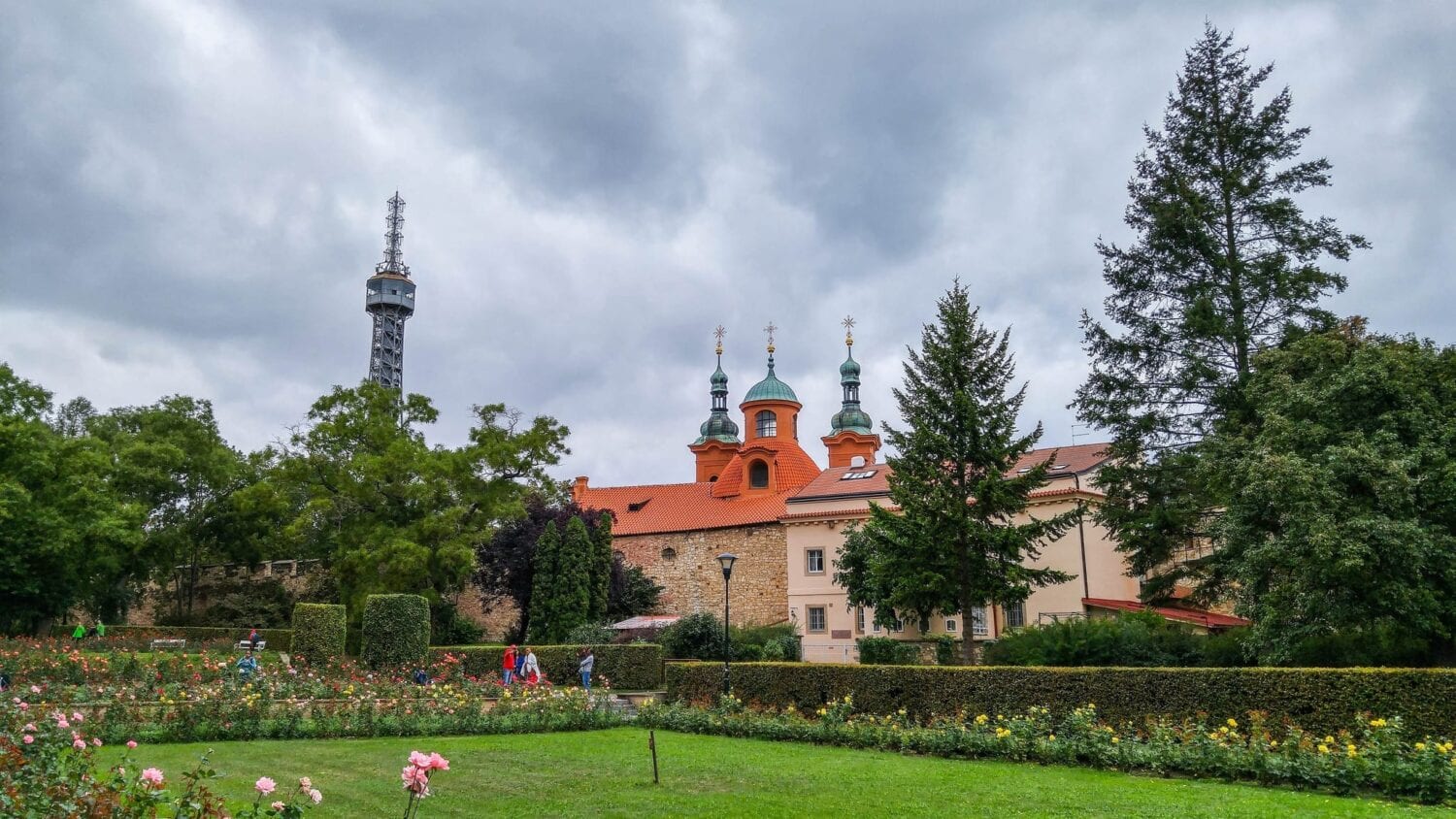
The Ultimate Walking Tour of Prague’s Peaceful Petrin Hill
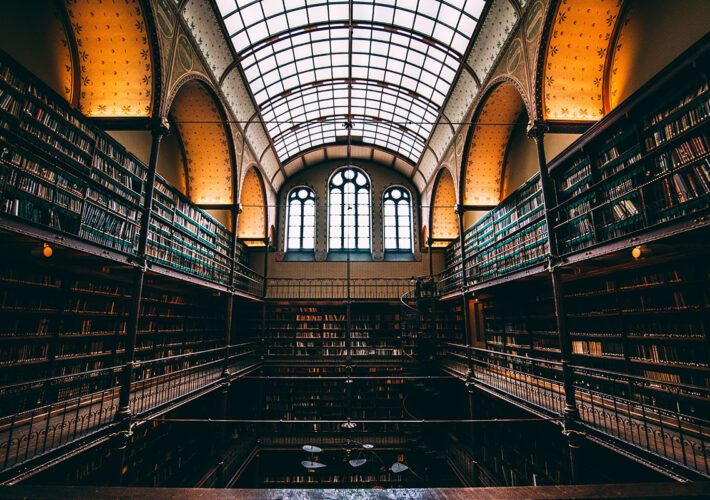
Guide to Visiting and Exploring the Rijksmuseum Research Library, One of the Most Beautiful Libraries in the World
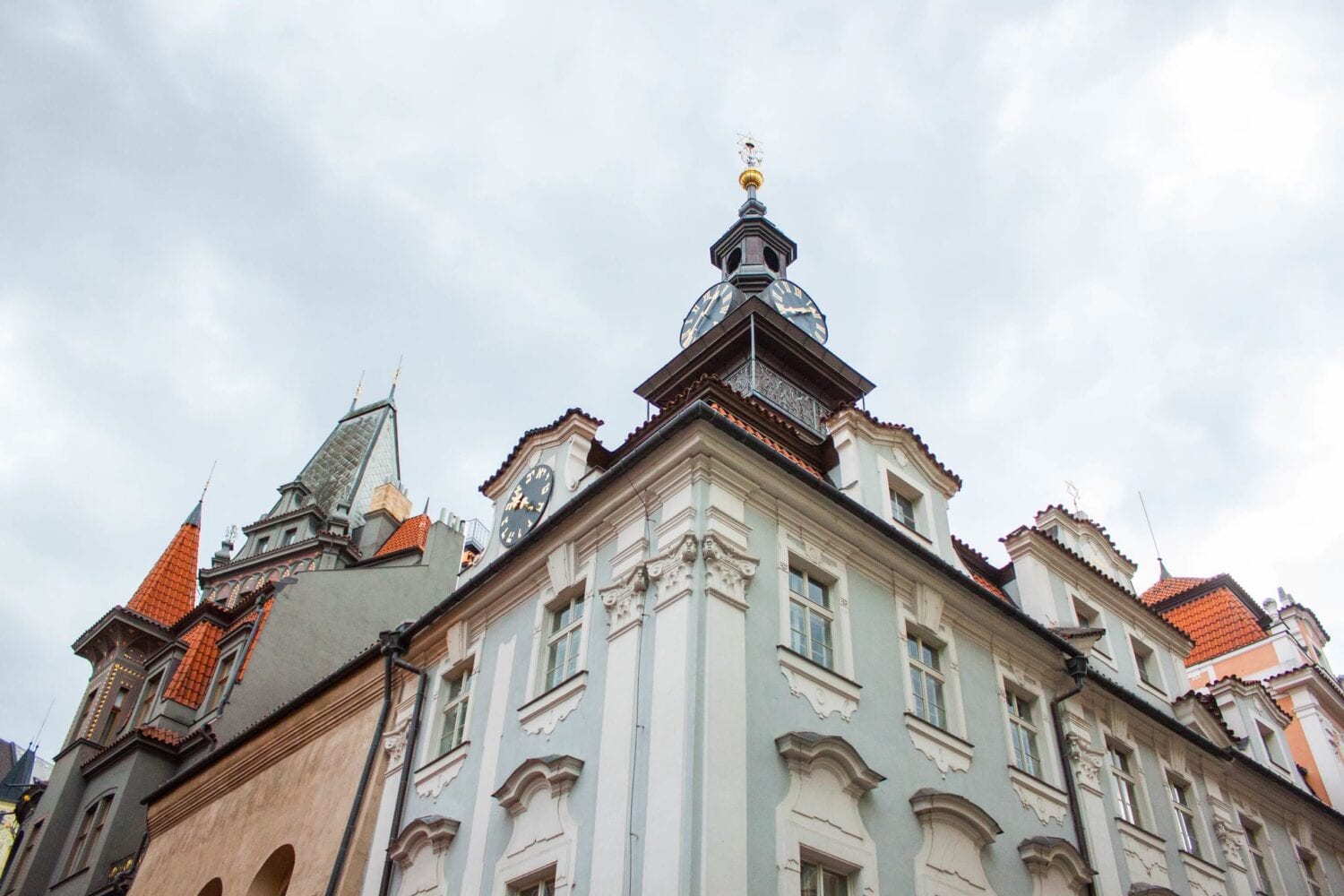
Prague’s Jewish Quarter, Your Self-Guided Walking Tour of the Best Things to See and Do in Josefov [UPDATED 2023]
On the Passion facade, your burial information is not correct. It is Joseph of Arimathea and Nicodemus who were responsible for preparing and wrapping up Jesus body to make ready for the tomb. In the background is the Virgin Mary with an egg on her head, a symbol of the resurrection. The image of Nicodemus is actually a self-portrait of the sculptor Subirachs. xx
laura.f.whelan
Thank you ever so much Karla for taking the time to send me this information! I’ve gone ahead and updated the post to reflect those changes. I truly appreciate it as I’m always learning myself from others! Cheers, Laura
Leave a Comment Cancel reply
Your email address will not be published. Required fields are marked *
Copyright @ 2023 The Creative Adventurer | All Rights Reserved | Privacy Policy
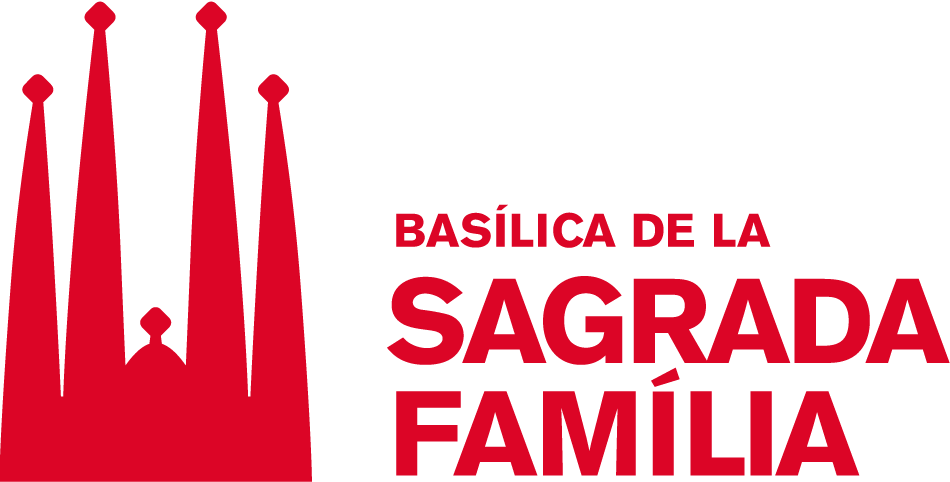
- DONATIVES -->
Language Selector
Winners of tickets for after-hours guided tour on eve of Sant Jordi announced - Winners of tickets for after-hours guided tour on eve of Sant Jordi announced
Asset publisher.

The Sagrada Família has announced the winners of the 90 tickets for two for the after-hours guided tour on 22 April.
The winners will receive their tickets by email in the coming days. The tour will be in Catalan and there will be several time slots between 8:15 pm and 9:05 pm.
Check the list of winners here .
Art installation created with AI, for the first time at the Basilica of the Sagrada Família
For Sant Jordi, the Sagrada Família will install a digital art projection called Rosa, Rosae , created with artificial intelligence specially for the occasion .
It is an innovative, original piece of digital art that combines shapes from a rose and inspired by Antoni Gaudí. Projected on a huge LED screen, the art piece is in direct dialogue with the sculpture of Saint George by Josep Maria Subirachs. The visual piece is accompanied by a composition for the organ to create an artistic experience full of shapes, colours and music.
This installation will be on display from 22 to 27 April.
Free tickets for anyone named Jordi, Jordina, Jorge or Georgina from anywhere in the world
On 23 April, people called Jordi and Jordina, or the equivalent names in any language from anywhere in the world, can visit the Basilica for free with a guest, without having to book.
More information on the Sant Jordi celebrations at the Basilica of the Sagrada Família is available on our website http://sagradafamilia.org/sant-jordi .
YOUR PRIVACY MATTERS
We use our own and third-party cookies to improve this website, as well as collect and analyze access data. By clicking on 'OK' you accept the use of your data for these purposes. You can modify this consent whenever you wish.

IMAGES
VIDEO
COMMENTS
Read reviews and view photos. Book a tour today! Full Refund Available up to 24 Hours Before Your Tour Date. Quick & Easy Purchase Process
¡Tours culturales de 5* en Barcelona! Reserva en Viator de TripAdvisor. ¡Compra rápida y sencilla. Reembolso total hasta 24 horas antes de la fecha del tour
LA SAGRADA FAMÍLIA. DOWNLOAD DOWNLOAD. Choose your option. ... Special entrance, audio equipment to follow the tour better, a special route for groups, etc. You'll have an official guide with you to explain all the secrets of the Basilica. This visit is also perfect for university groups or companies not in the tourism sector.
Park Guell & Sagrada Familia Skip the Line Tour in Barcelona. 667. Enjoy priority access to two Antoni Gaudí masterworks on this half-day skip-the-line tour. Tour the highlights at Park Güell, a park sprinkled with Gaudí buildings and statues. Then, travel by coach to La Sagrada Familia, Gaudí's unfinished cathedral.
Go With a Local: Skip the Line Tour: #1 Choice of the Best Sagrada Familia Tours. Duration: 90 min | Price: From €52.00 I always recommend opting for an extended English guided tour offered exclusively by legendary tour operator Viator.. At 90 minutes it is almost double the length of the official La Sagrada Familia tour.. You also skip Sagrada Familia lines VIP-style - and you can stay as ...
10. Barcelona: Sagrada Familia Tour & Optional Tower Visit. Take a fully guided tour of La Sagrada Familia Basilica accompanied by your guide. Learn about Barcelona's most iconic landmark and admire Gaudí's unfinished masterpiece. Meet your guide and begin your tour of this world-famous site, which started at the end of the 19th century.
Make the most of your visit to Barcelona's architectural crown jewel on a skip-the-line tour of the Sagrada Familia Cathedral. Bypass the long wait to enter Gaudí's Modernist masterpiece, and learn about the inspiration and symbolism of the cathedral's design on a guided tour of all five levels. Finally, ascend the cathedral towers to rise directly over the heart of Barcelona for ...
Step inside La Sagrada Familia in Barcelona on this guided tour. Learn from your guide about the famous Catalan architect Antoni Gaudí, whose Barcelona masterworks hold UNESCO World Heritage status. Stroll among columns as large as trees, admire the lavish decoration, and view the colorful stained-glass windows. Upgrade to enjoy spectacular views from one of the towers or transform your ...
Full description. Take a fully guided tour of La Sagrada Familia Basilica accompanied by your guide. Learn about Barcelona's most iconic landmark and admire Gaudí's unfinished masterpiece. Meet your guide and begin your tour of this world-famous site, which started at the end of the 19th century. Striking for its architectural features and ...
Prices are up to date as of January 2024. Sagrada Familia Basic Ticket - €20 (only available for the last two hours each day, not always available) Sagrada Familia - €26 (includes audioguide, available all day) Sagrada Familia with guided tour - €30. Sagrada Familia with guided tour and towers - €40.
Sagrada Familia Small Group Tour With Skip the Line Access. Delve into the hidden details of Gaudi's basilica alongside an expert guide. 4.94. ( 17) Max 25 Guests. from. $60.
La Sagrada Família is located in the central Eixample district in Barcelona, Spain. The bustling district is full of shops, restaurants, and cafes and is laid out on a grid, making it exceptionally easy to get around. Although the area is very walkable, we think that the best way to visit Sagrada Família is on a guided tour since tickets sell ...
Access. The Sagrada Familia is pretty easily accessible since it's located in the centre of town. By metro, you just need to hop on the L5 line towards Sants Station.Upon getting out of the metro, simply follow the signs for the 'Sagrada Familia.' If you are arriving by bus, get on the H10 and get off at the València, Lepant stop. If you bought a Hop-On Hop-Off Bus ticket, these also ...
What I personally like about the tour, despite that it can get up to 30 people, is that you will get a headset to hear your guide better, and, trust me, with all the crowds inside, it's very helpful! BOOK NOW: Skip-the-line Sagrada Familia Tour. 2. Park Guell & Sagrada Familia Combo Guided Tour. ⭐ Rating: 4.3/5.
Sagrada Familia guided tours are the best option for first-time visitors. You get a 90-minute Sagrada Familia tour with an entertaining flesh-and-blood guide who knows this Antoni Gaudí church inside out. English Sagrada Familia tour times are daily at 11:15 am and 1:30 pm. Sagrada Familia Guided Tour Prices. Price.
Sail past long lines of tourists trying to gain entry to Gaudí's Sagrada Familia on this priority access tour of the modernist masterpiece. Accompanied by a guide, head straight inside to get fascinating insight into the history of the UNESCO World Heritage-listed cathedral. Admire the opulent ceilings and stained-glass windows while learning about the building's charismatic creator ...
Join me on a tour in 4K of the world-famous Sagrada Familia in Barcelona, Spain. Designed by the legendary architect Antoni Gaudi, the unfinished basilica is...
La Sagrada Família, the most famous church in all of Spain, is a must-see in Barcelona. ... The full name of the basilica is "el Templo Expiatorio de la Sagrada Familia", which translate as "The Expiatory Temple of the Holy Family". ... Visit of the basilica with a tour guide, tower visit included: Adults pay $42.80 (40 €); seniors ...
Sagrada Familia Tour Information - 2024. La Sagrada Família - An icon of Barcelona's skyline and one of the most notable masterpieces by Antonio Gaudí. The Basílica de la Sagrada Família! Yes! The famous Sagrada Familia is a huge, unfinished basilica in Barcelona's Eixample region. The structure was designed by the Spanish architect ...
Short Answer: Yes, a tour is worth it. Check out our free guide to the Best tours of Sagrada Familia. While it is entirely possible and enjoyable to visit the Sagrada Familia without a guide, a guided tour can often elevate a visit to another level. The entry fee of 26 euros includes an audio guide, but audio guides are robotic and cannot ...
Tip #1: Buy Your Tickets in Advance. Simply put, you cannot enter the Sagrada Familia without booking tickets online in advance. If you don't have them you'll be asked to book with your phone, though especially in summer you're likely to encounter sellouts. Luckily, you can buy them conveniently from our trusted partner Tiqets.
La Sagrada Familia is THE MOST important sight to see when visiting Barcelona. Its history, design and the feeling you get upon stepping inside in unparalleled. The church feels like a summation of what Barcelona is all about and understanding it before visiting or while you tour it is so essential to better enjoying this fantastic monument.
The Sagrada Família has announced the winners of the 90 tickets for two for the after-hours guided tour on 22 April. The winners will receive their tickets by email in the coming days. The tour will be in Catalan and there will be several time slots between 8:15 pm and 9:05 pm. Check the list of winners here.